October 27
We’re picked up to drive to the airport at 4:30, a bit sad to be leaving this amazing hotel. From the center of India we travel west to the desert and town of Jodhpur, flying through Mumbai (Bombay). We are met by a representative of our travel agency in Mumbai and a driver who take us to the new terminal (for our flight to Jodhpur), which opened five years ago and is easily the most beautiful terminal I’ve seen anywhere. The terminal was designed by the Chicago architectural firm, SOM. I’m so proud.
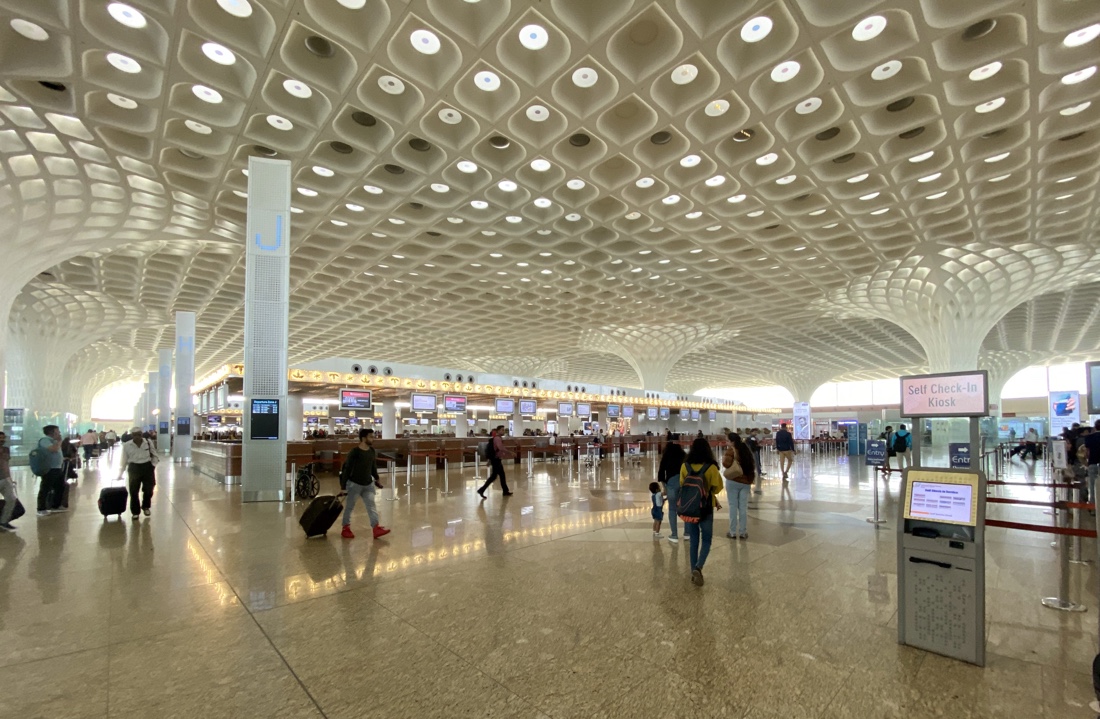
The terminal is so special that I’d encourage a traveler who was in Mumbai, but not flying in or out, to go see it. Except, they couldn’t, because India, being much smarter than we are, requires that you show a ticket and identification before you are allowed to enter the terminal.
Our flight to Jodhpur is an hour late. We are met at the airport and transferred ten minutes or so to our hotel, the Hotel Umaid Bhawan Palace.
Well, if we anticipated a step down from our Hyderabad hotel, we were mistaken. This place seems equally amazing. The young woman who shows us to our room, er, I mean, suite, says that this was the number one rated hotel in all of India and number three in the world. We are greeted by trumpets blaring and rose petals dropped from above. And I hardly ever get that at home, damn it.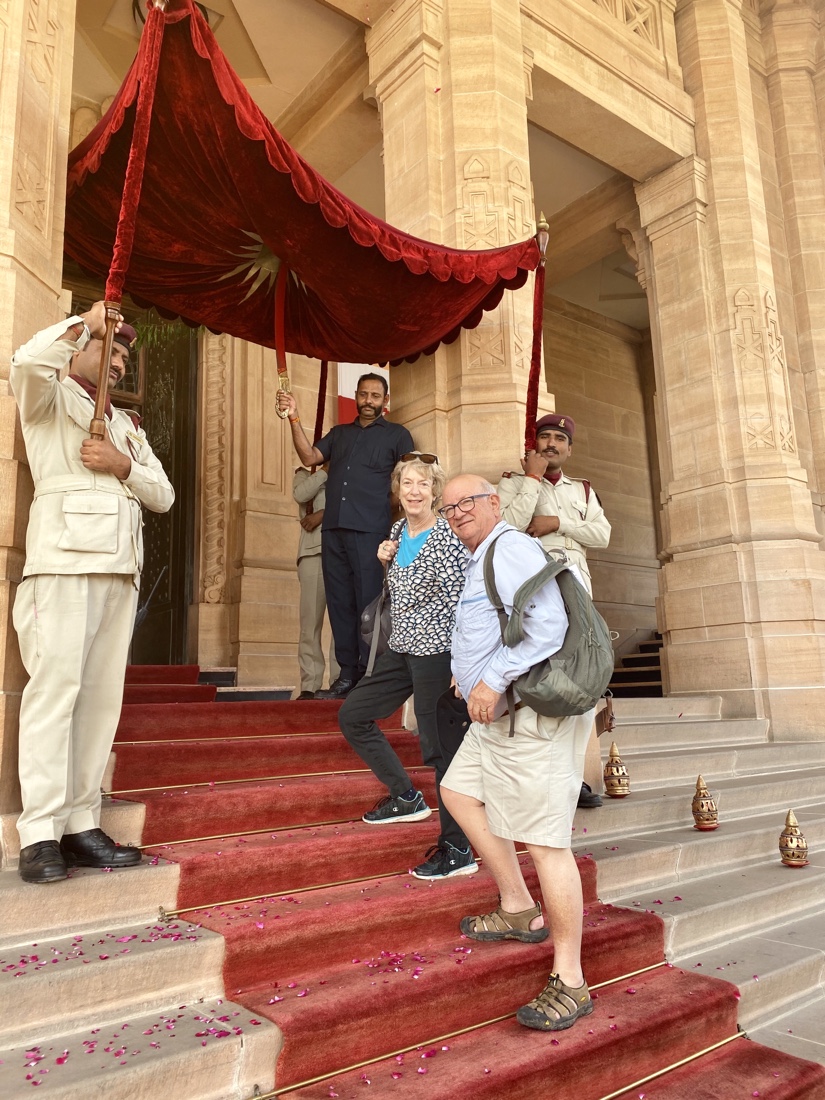 The hotel is decked out magnificently for Diwali, with fresh flower arrangements everywhere. The hotel is decked out magnificently for Diwali, with fresh flower arrangements everywhere. 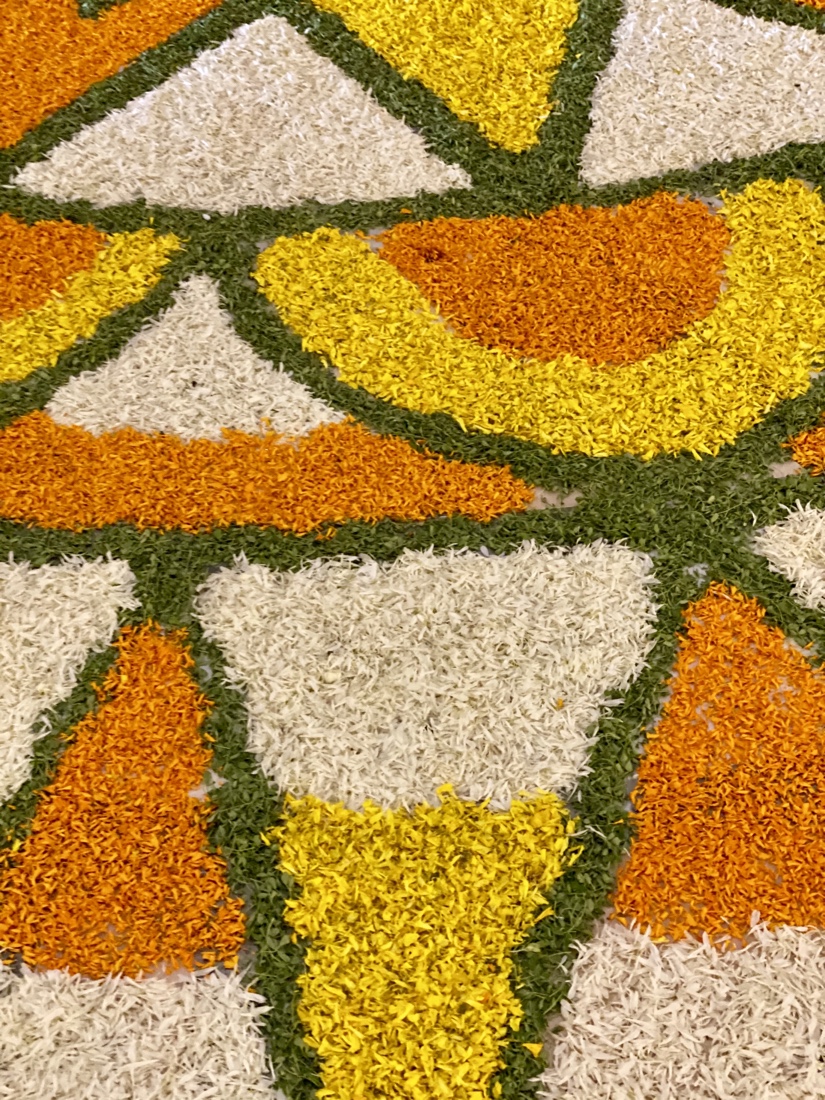
And our suite is not too shabby, either, as you can see from the bedroom part.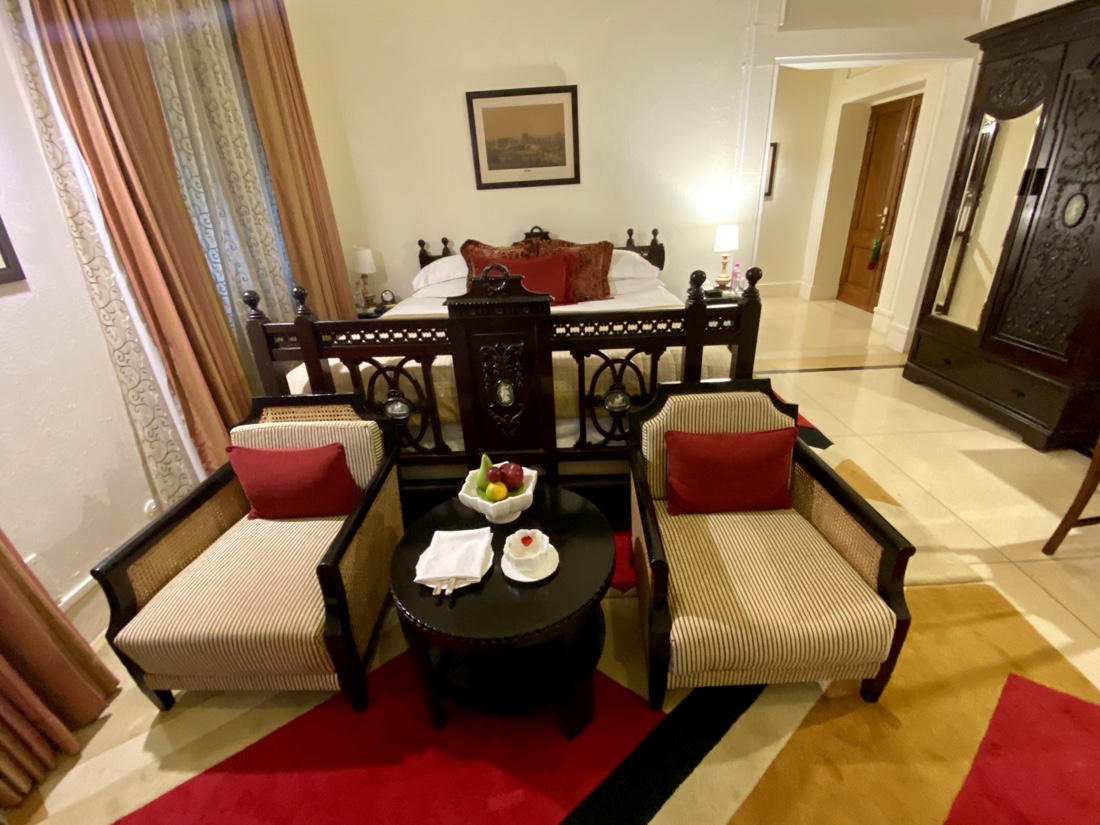 Later in the afternoon we walk around the blue city, with our guide, Praveen, an enthusiastic Jodhpur native Later in the afternoon we walk around the blue city, with our guide, Praveen, an enthusiastic Jodhpur native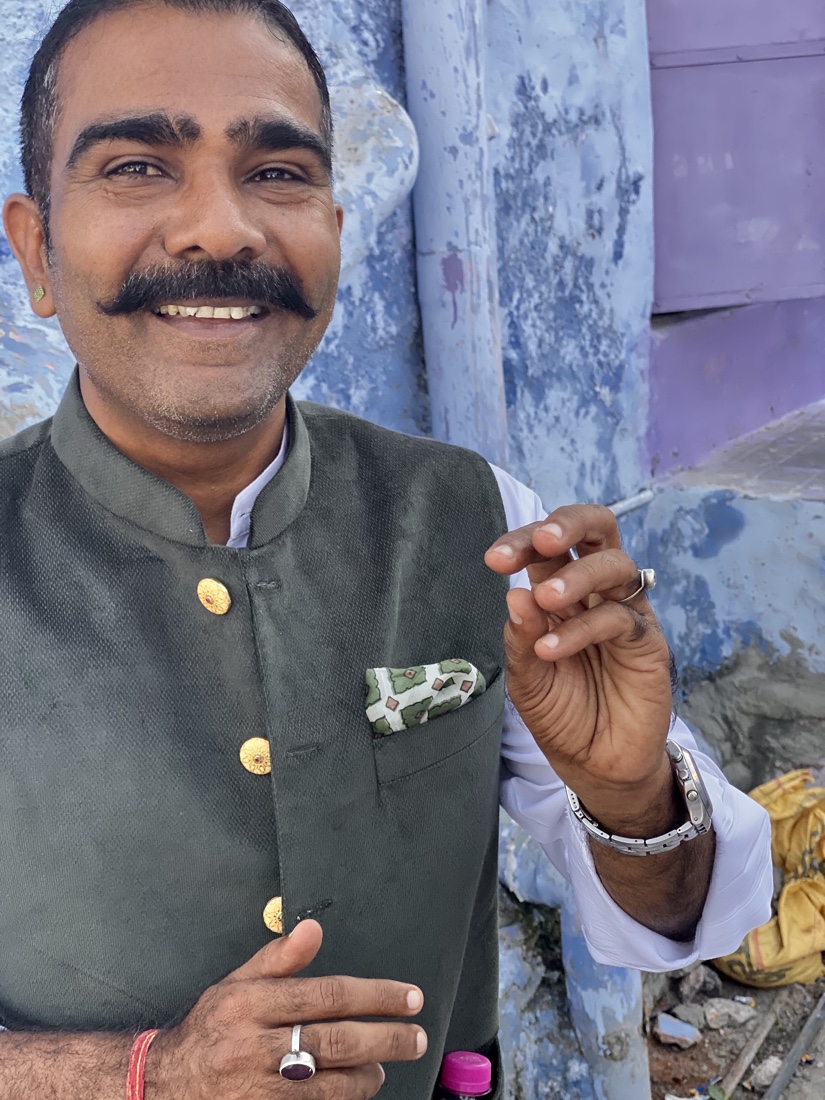 driven there by Mahendra (Manu), who shares the road with Ubers driven there by Mahendra (Manu), who shares the road with Ubers 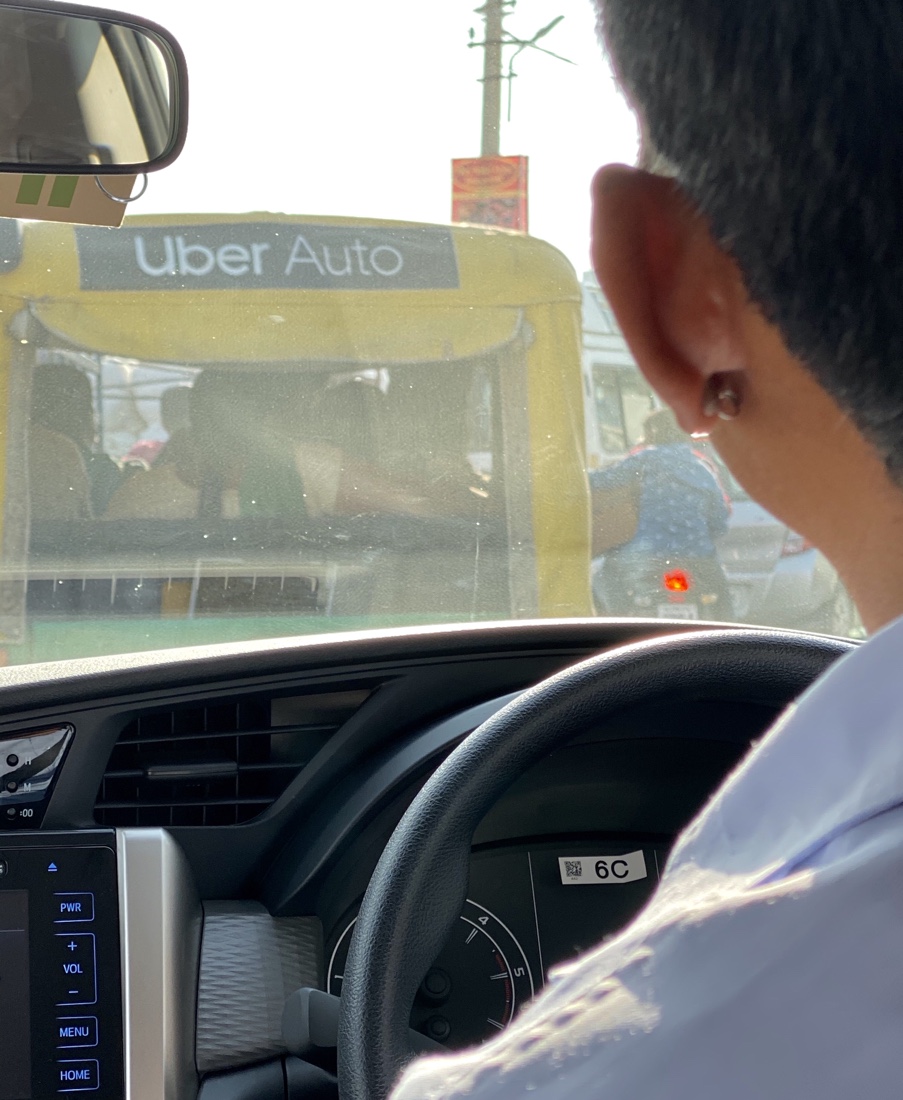
Praveen talks of the blue city, and certainly there is some blue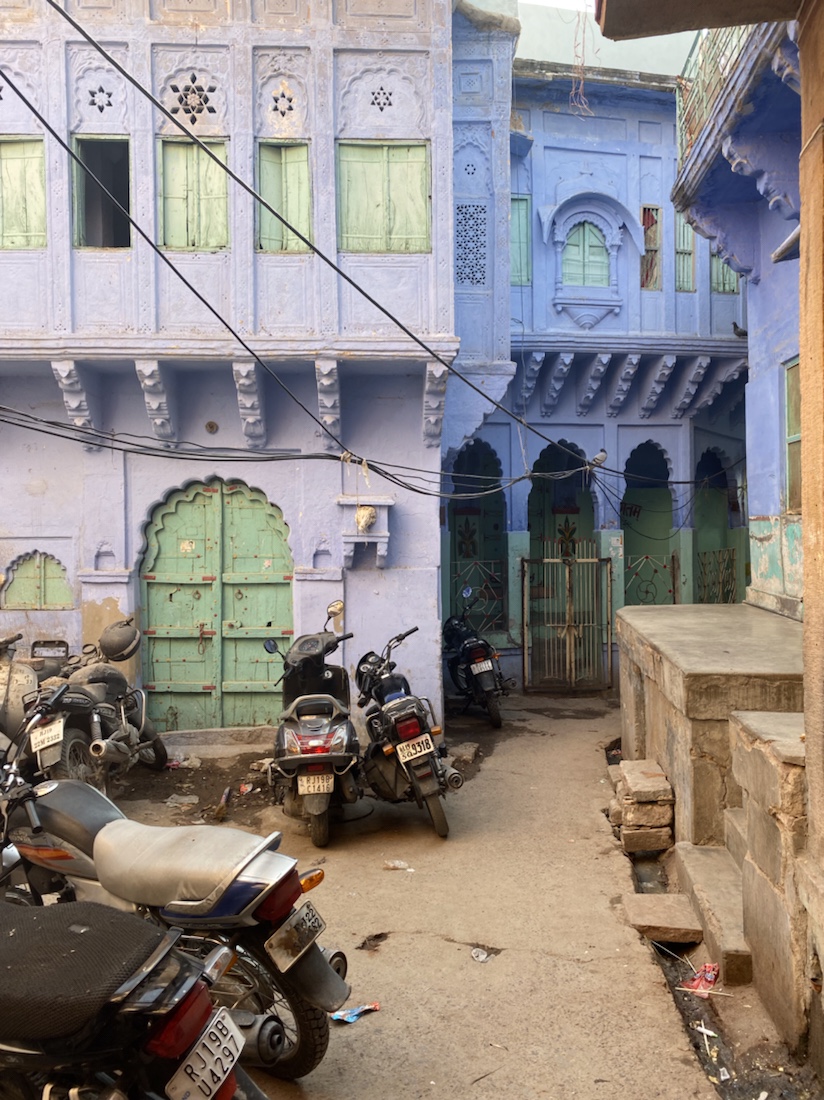 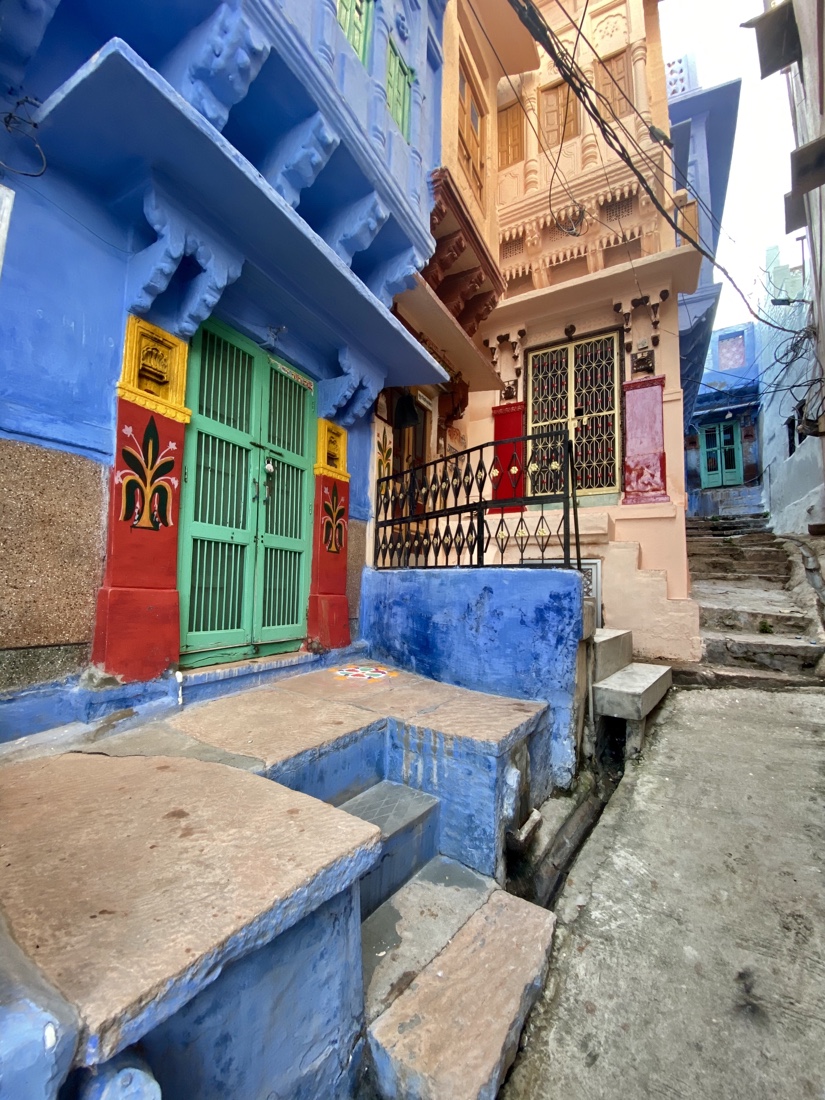 You see some blue as you look out over the city, towards the fort that was occupied by the rulers until they built and moved into the palace that is now our hotel. You see some blue as you look out over the city, towards the fort that was occupied by the rulers until they built and moved into the palace that is now our hotel.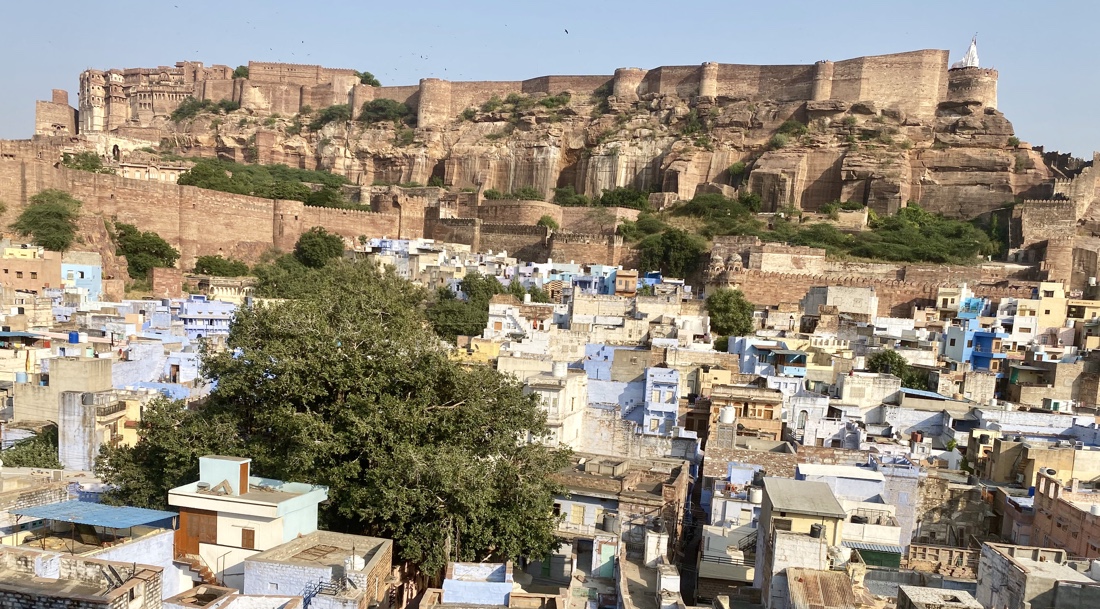 But there also is plenty of trash But there also is plenty of trash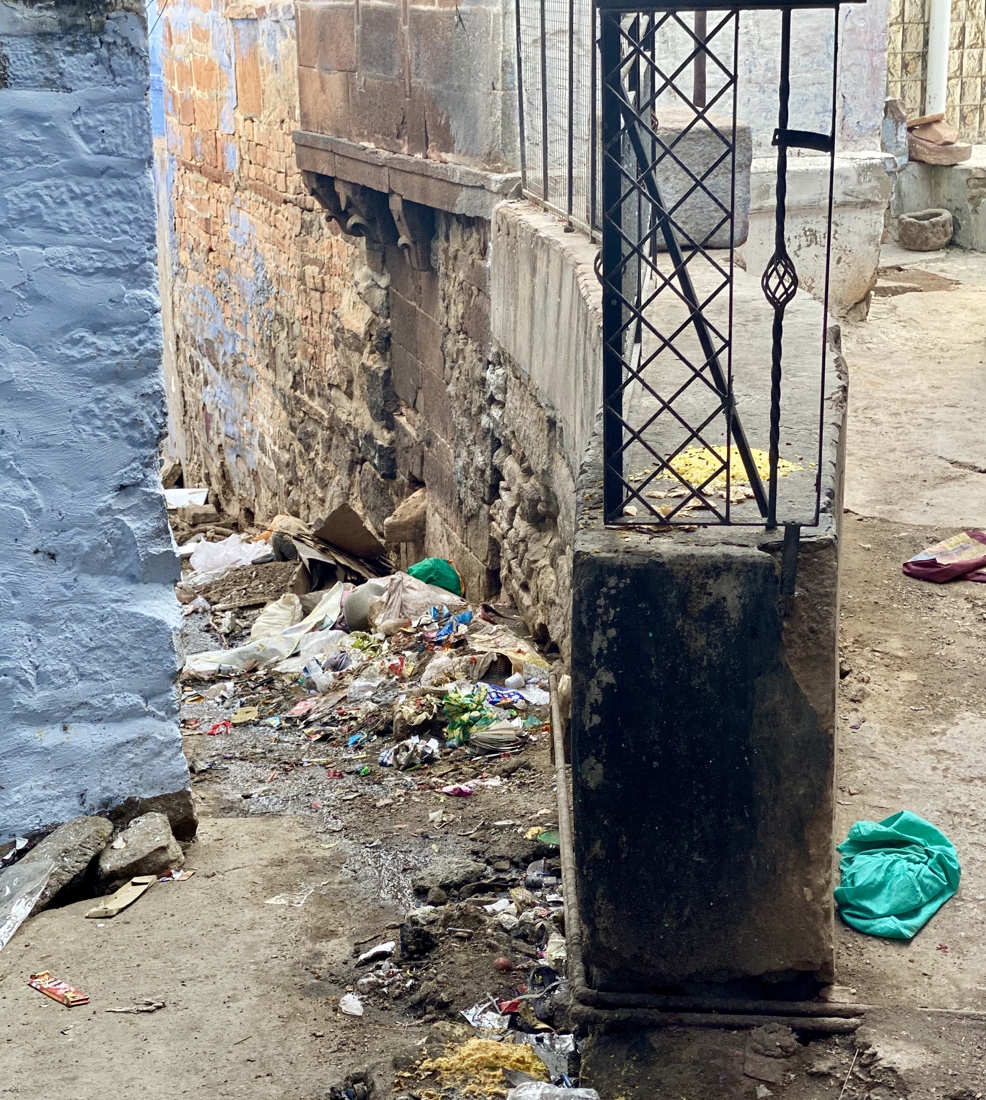 And, one of the “problems” of traveling as much as we do is that when you hear somebody rave about a blue city, you compare it to another blue city, Chefchaouen , that you saw in Morocco and, as blue cities go, the latter wins, hands down. And, one of the “problems” of traveling as much as we do is that when you hear somebody rave about a blue city, you compare it to another blue city, Chefchaouen , that you saw in Morocco and, as blue cities go, the latter wins, hands down.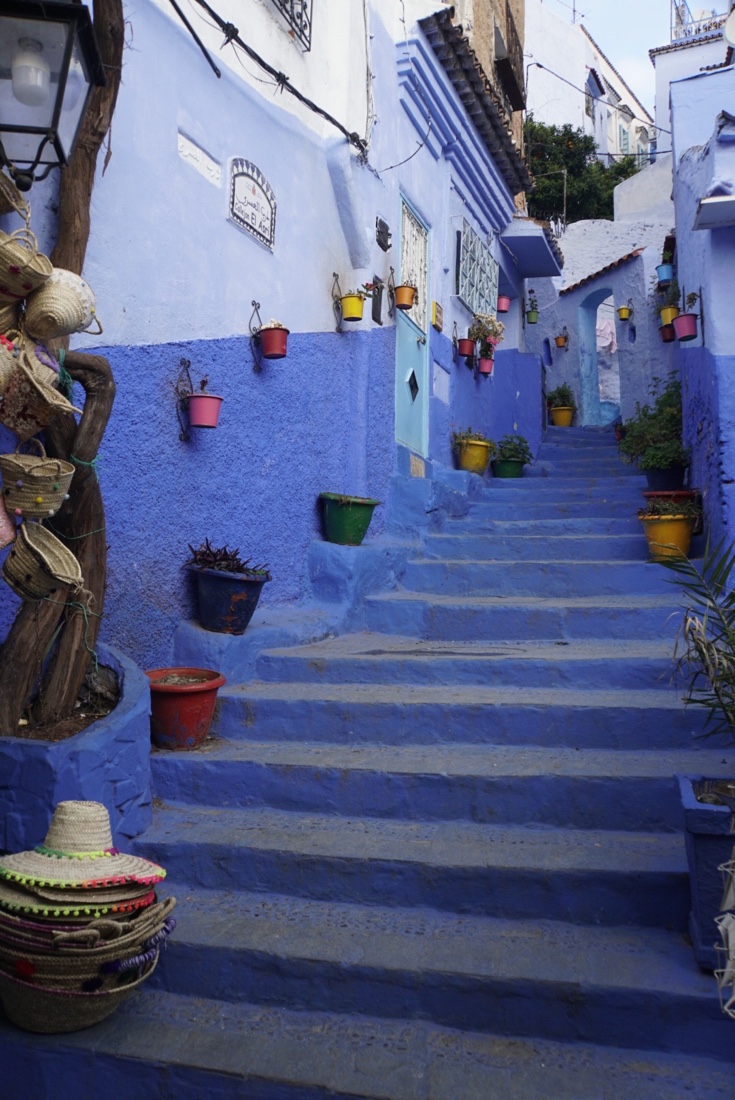 The most interesting part of walking around Jodhpur is seeing people preparing for Diwali, by ironing with a coal iron The most interesting part of walking around Jodhpur is seeing people preparing for Diwali, by ironing with a coal iron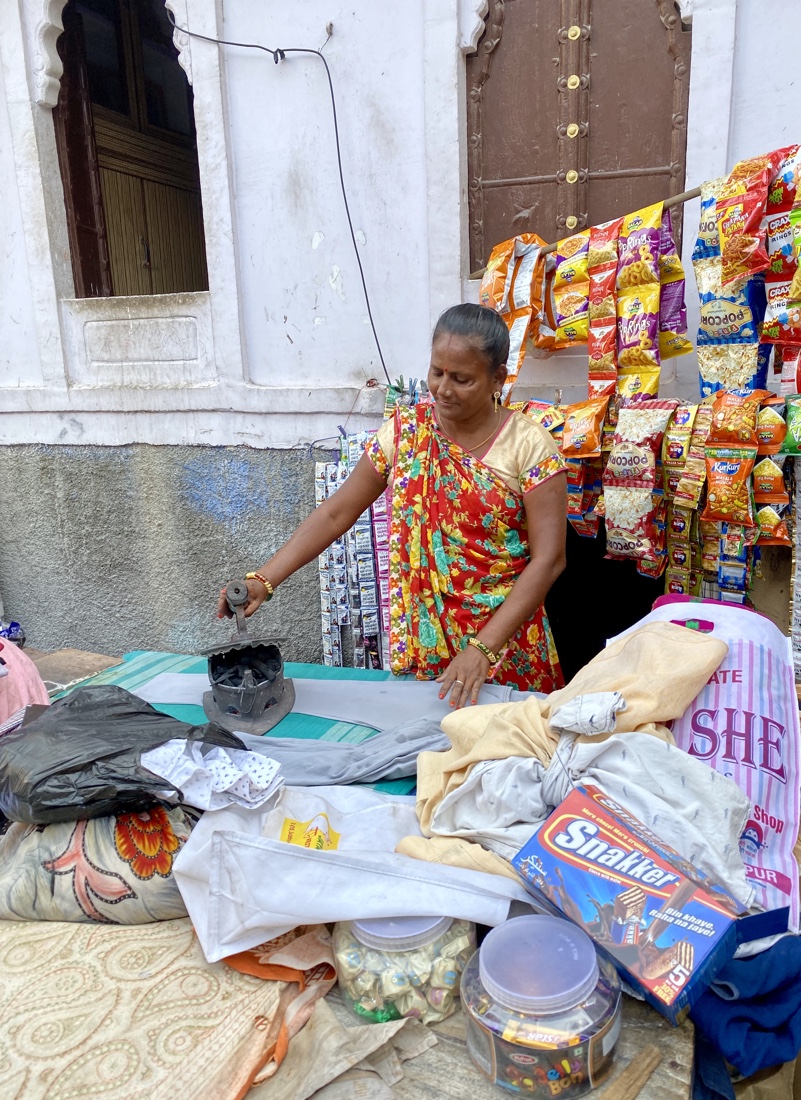
Or by decorating their doorsteps.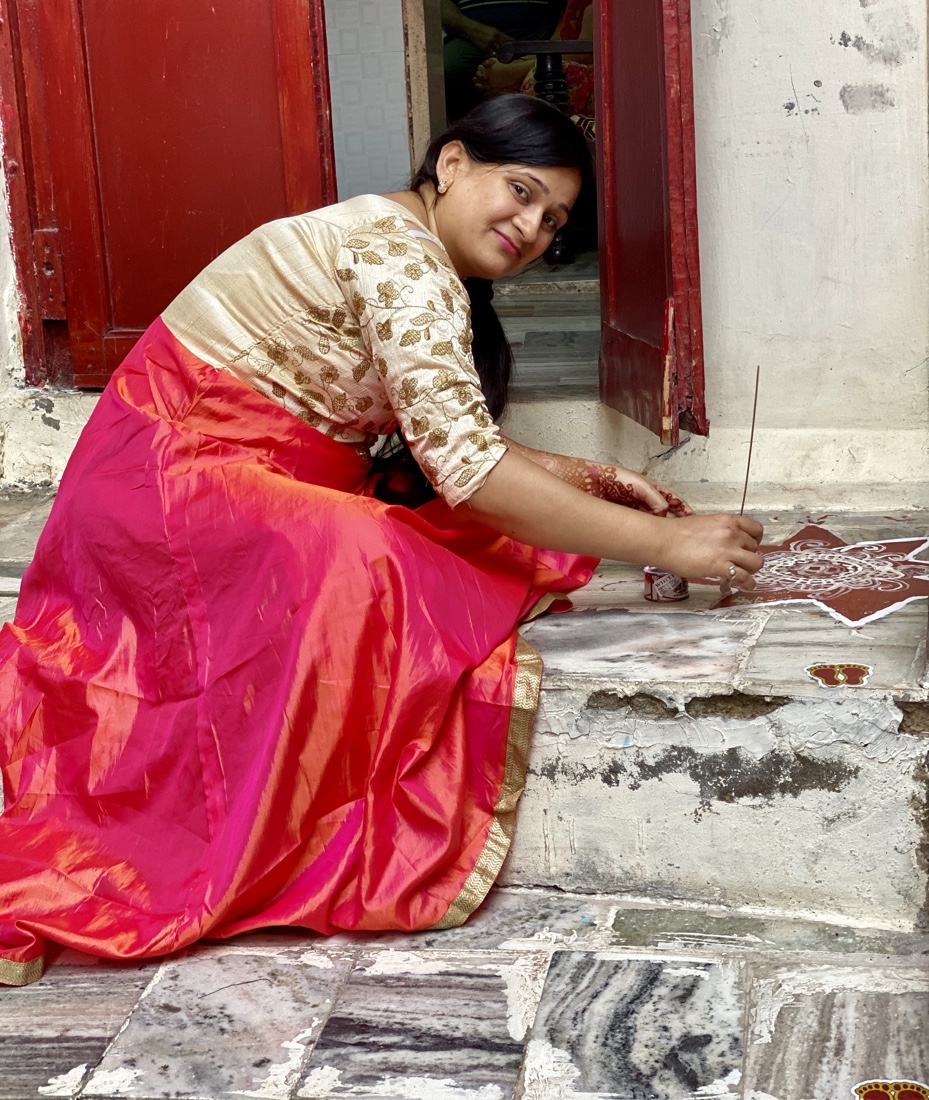
Or old or young people just being themselves.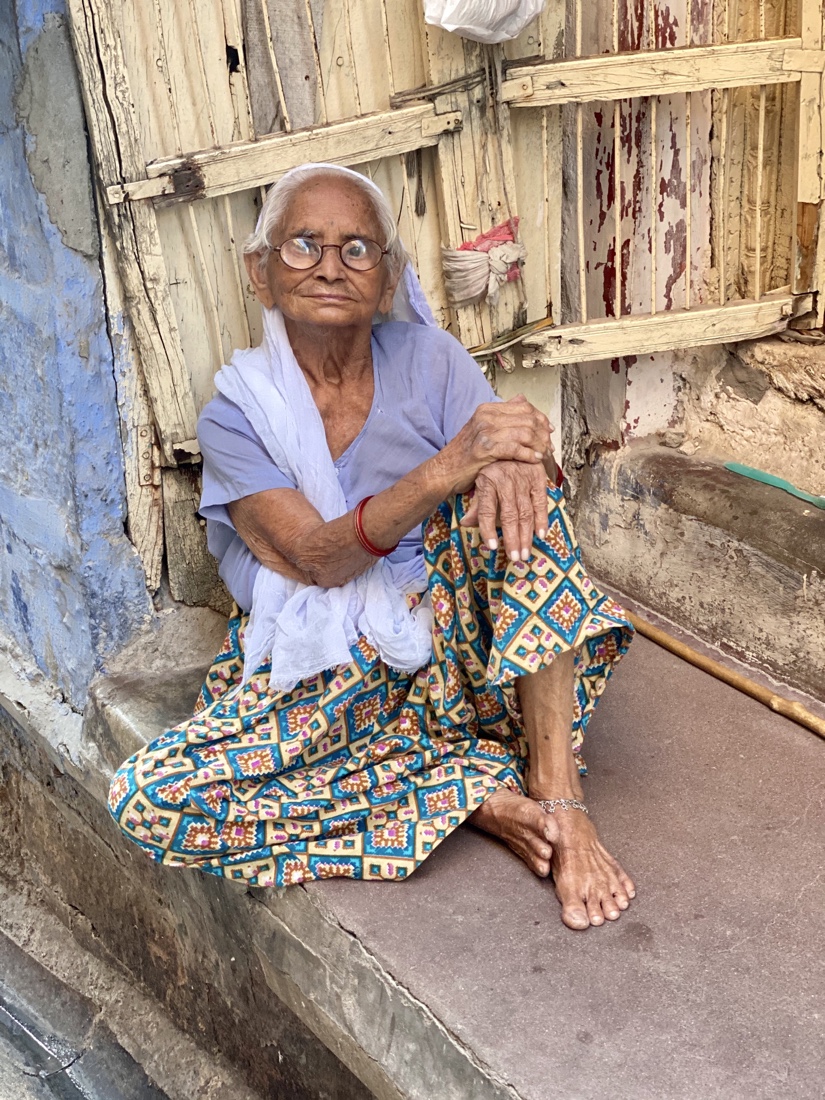 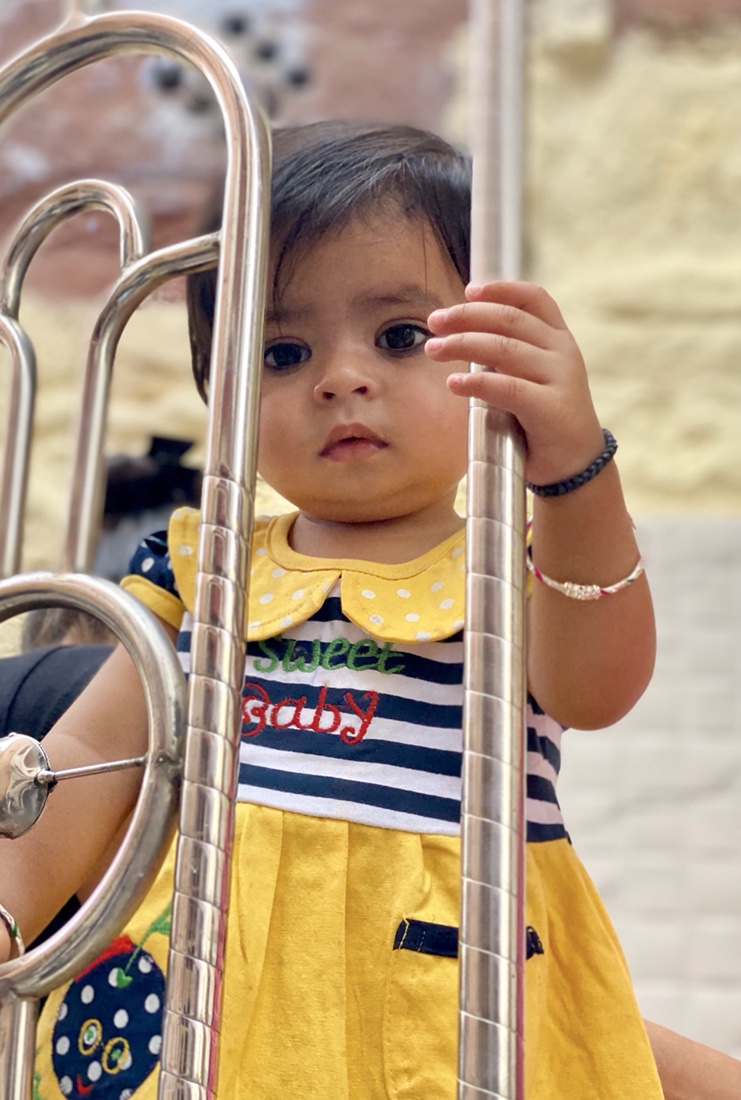
We return to the hotel before being picked up and driven to the home of Lokendra and Rama (and their two small children, cousin and nephew, with whom Shonali has arranged that we celebrate Diwali.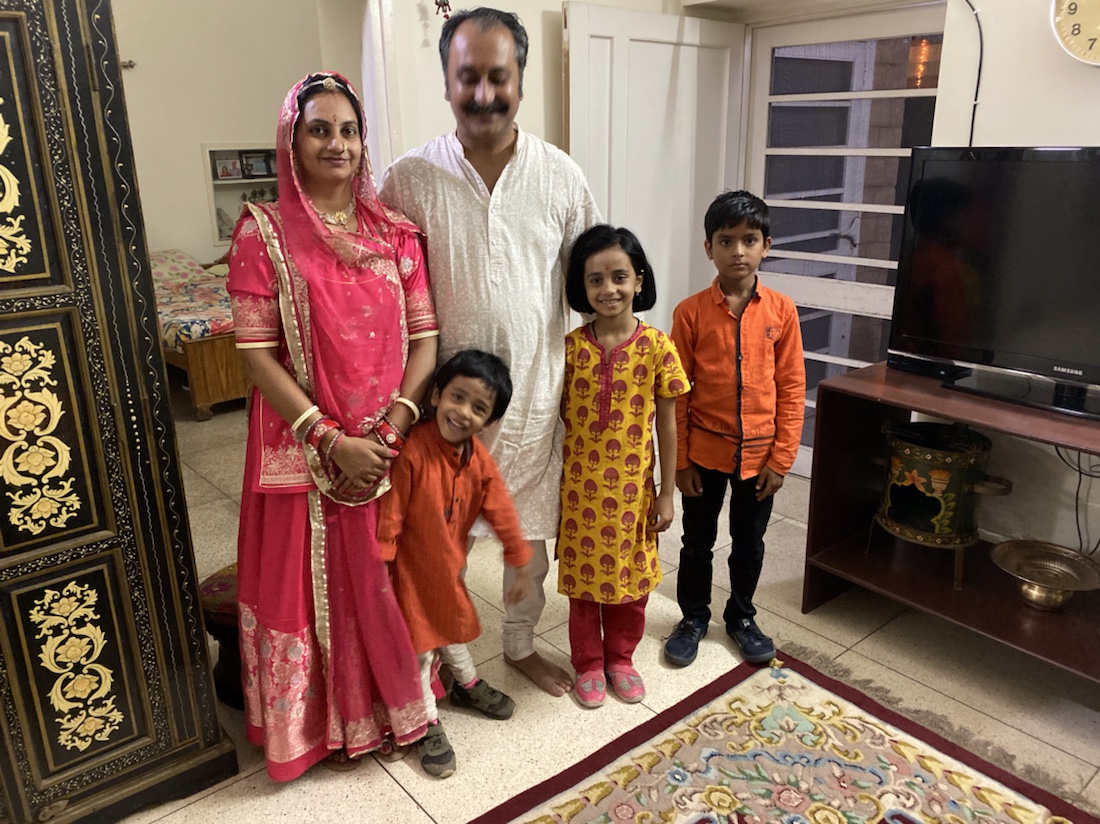 For Diwali, the festival of lights and one of India’s most beautiful celebrations, oil lamps are lit to decorate homes, and in the evening a “puja” is performed to welcome the Lakshmi, the goddess of wealth. People spend more than a week preparing, cleaning and decorating their homes. We are able to experience the celebration, first hand, with Lokendra and Rama, which is a real treat. For Diwali, the festival of lights and one of India’s most beautiful celebrations, oil lamps are lit to decorate homes, and in the evening a “puja” is performed to welcome the Lakshmi, the goddess of wealth. People spend more than a week preparing, cleaning and decorating their homes. We are able to experience the celebration, first hand, with Lokendra and Rama, which is a real treat.
Before the puja ceremony, Lokendra tells about his family. Large pictures of his great grandfather, grandfather and father hang in the living room. For bravery in battle his great grandfather was given six cities, from which he received the tax revenues. Though illiterate, he insisted that his son, Lokendra’s grandfather, go to school and now the fourth generation of the family is attending the same college, a fact of which Lokendra is very proud.
Lokendra seems to manage some family real estate and Rama manages the house and children, which she says is living a good life. She seems to have little interest in utilizing her advanced business degree. After the rather long, and very ritual-laden pujah, we have dinner, light fireworks in the back yard (clearly the highlight for the kids) and Carol and look through their thick wedding album from ten years ago.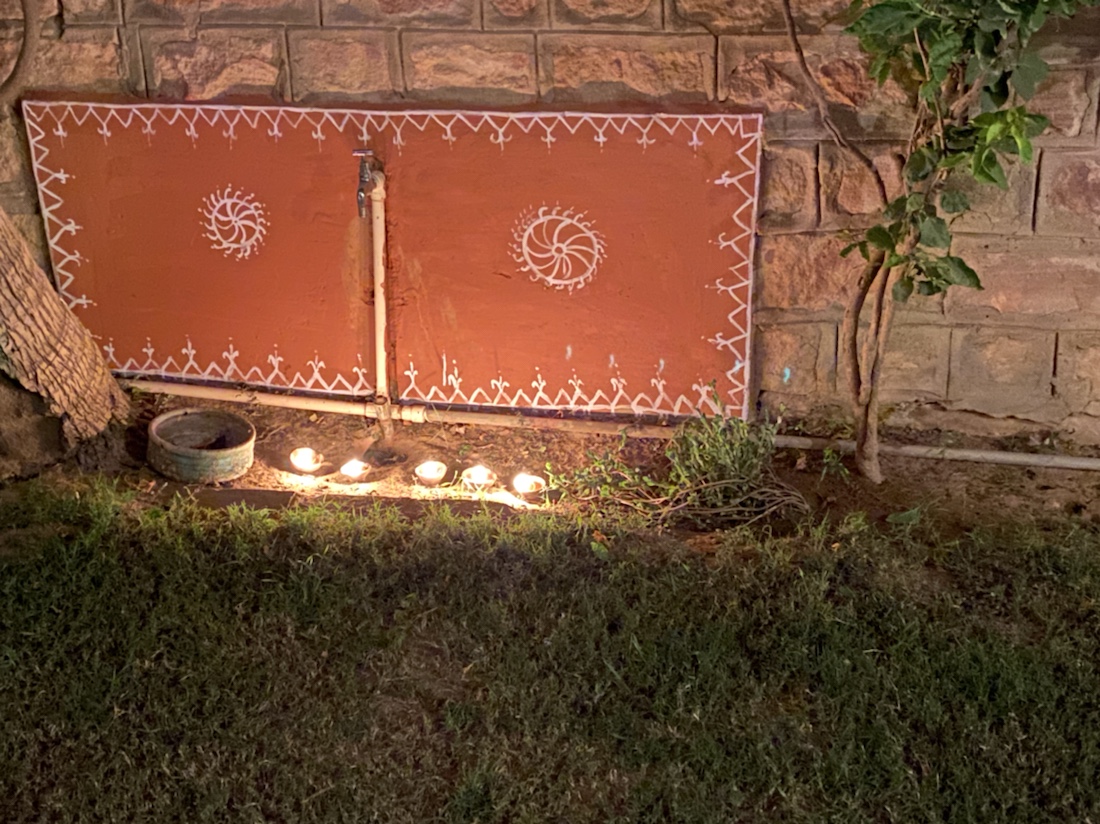 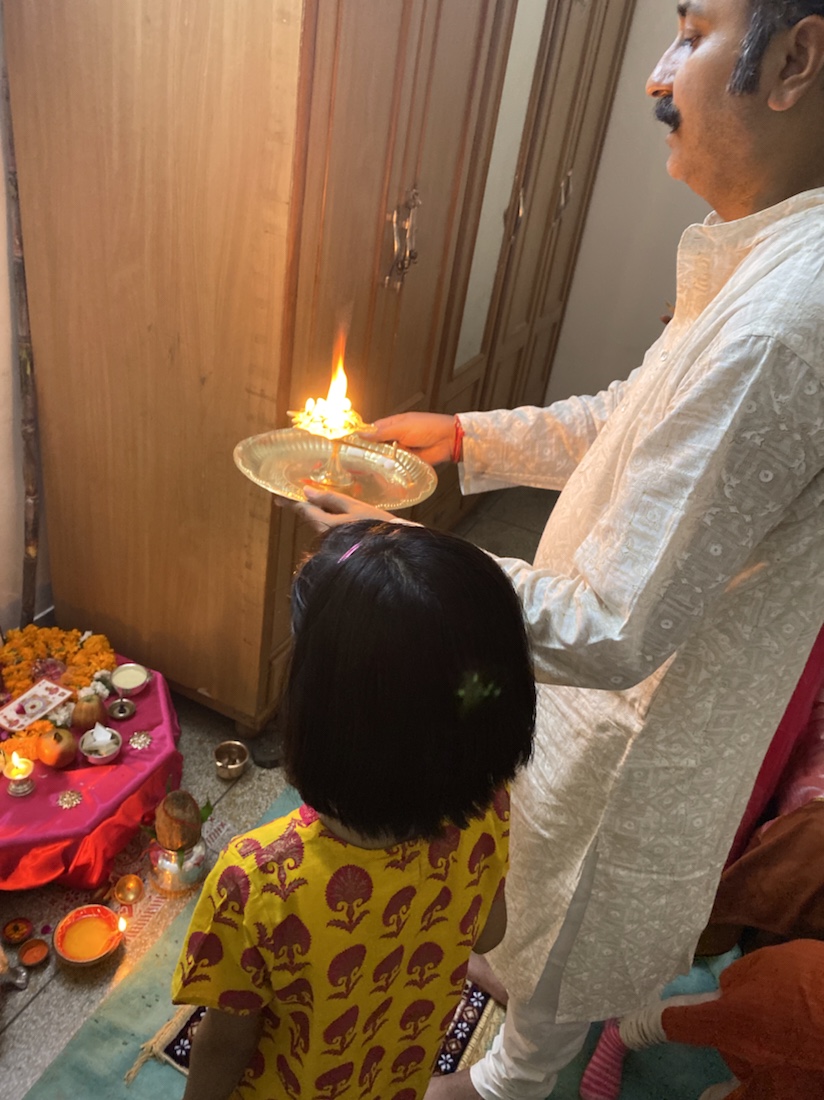 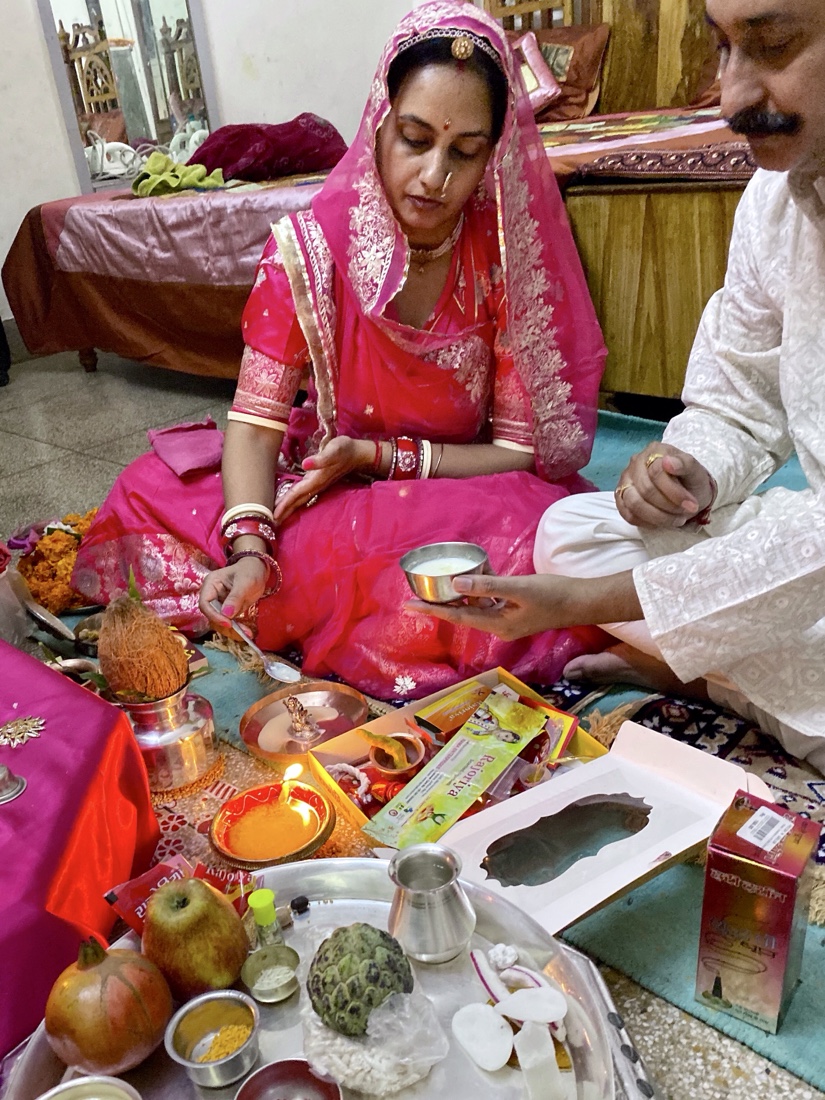 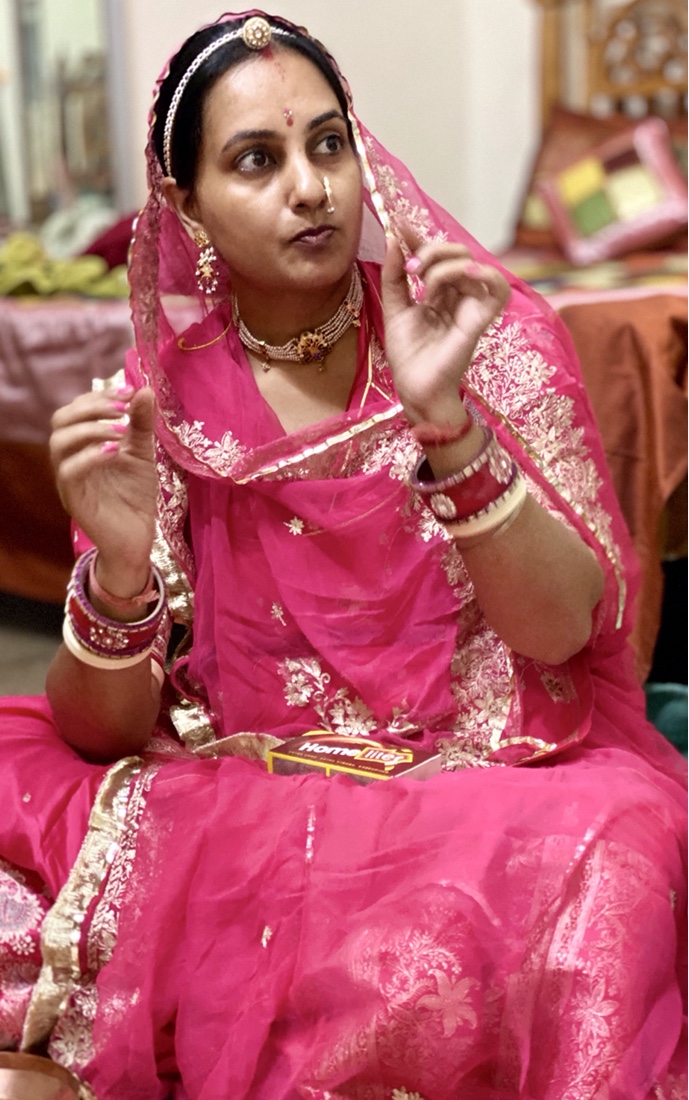 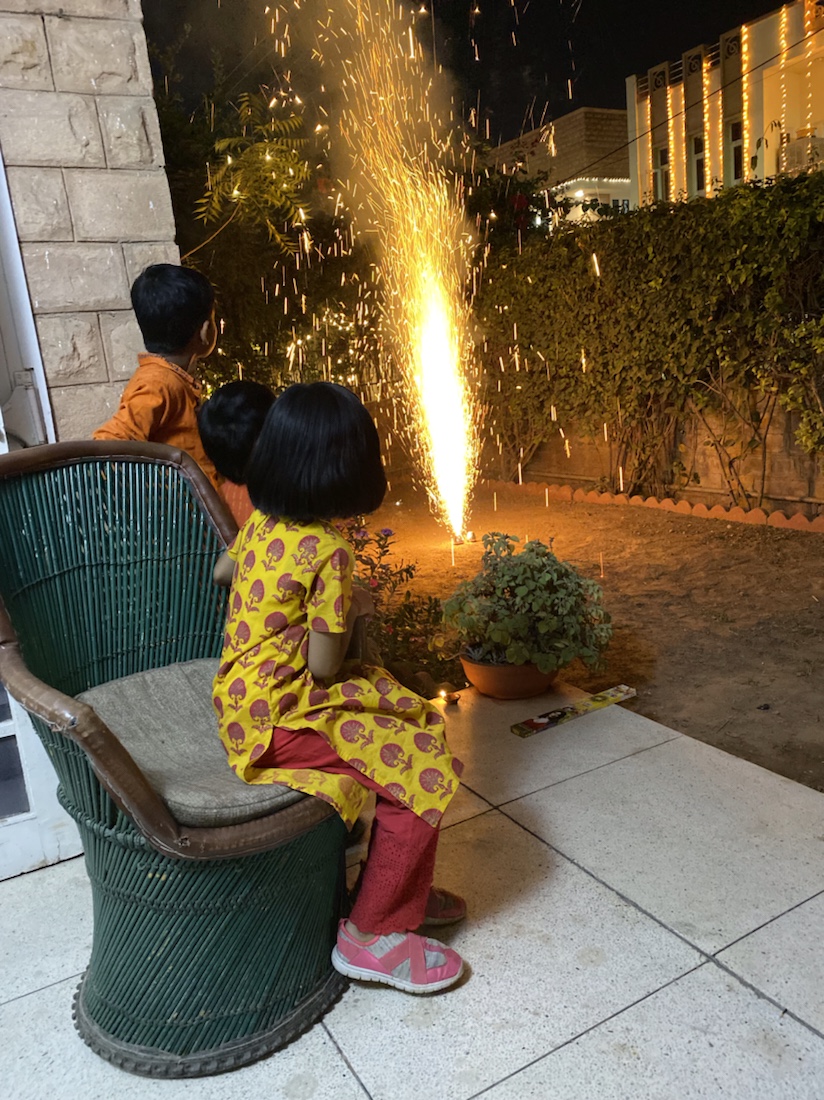 Our guide and driver have waited two and a half hours for us, and now drive us back to the hotel, after our most enjoyable and unusual evening. Our guide and driver have waited two and a half hours for us, and now drive us back to the hotel, after our most enjoyable and unusual evening.
October 26
After breakfast, Jonty picks us up at the hotel and we drive to the old city to visit the extraordinarily beautiful Paigah Tombs. (Whenever I say “we drive” it means that our driver drives our guide and us.). Intricately carved in marble, these are the tombs of the powerful Paigah Nobles who were close to the Nizam. Unlike the tombs we visited yesterday, these are small in stature and not well known. In fact, we are the only ones there and have to rouse a guard to open the gate for us.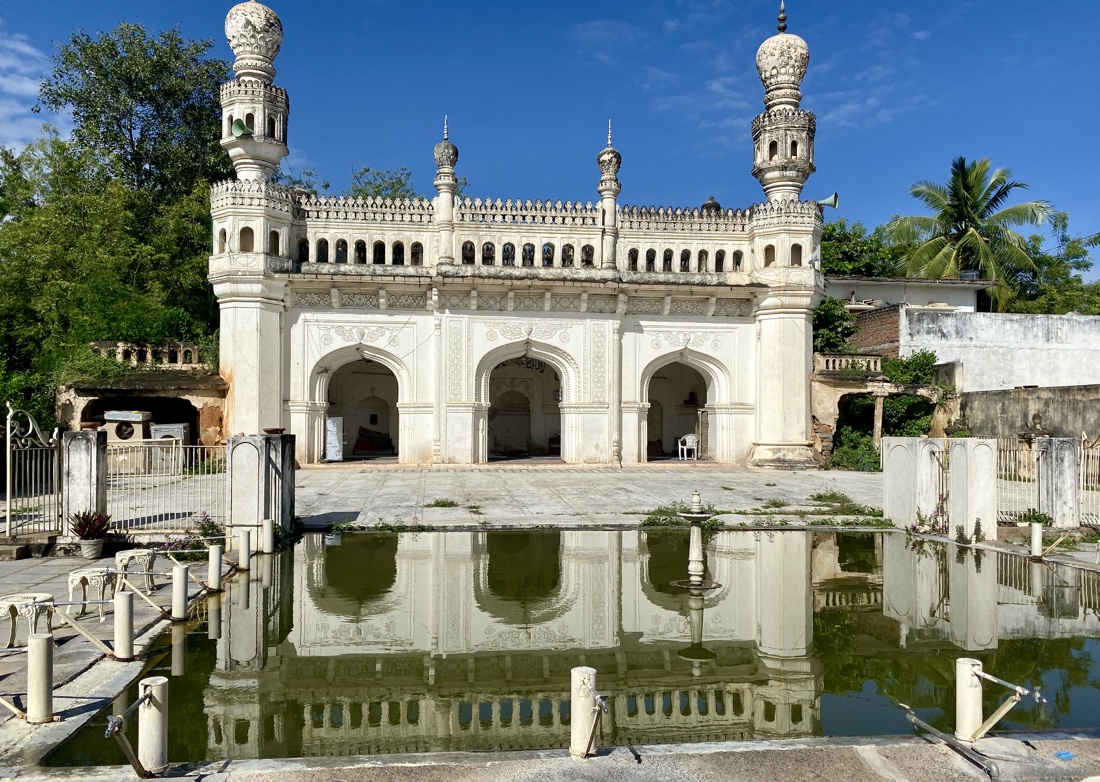 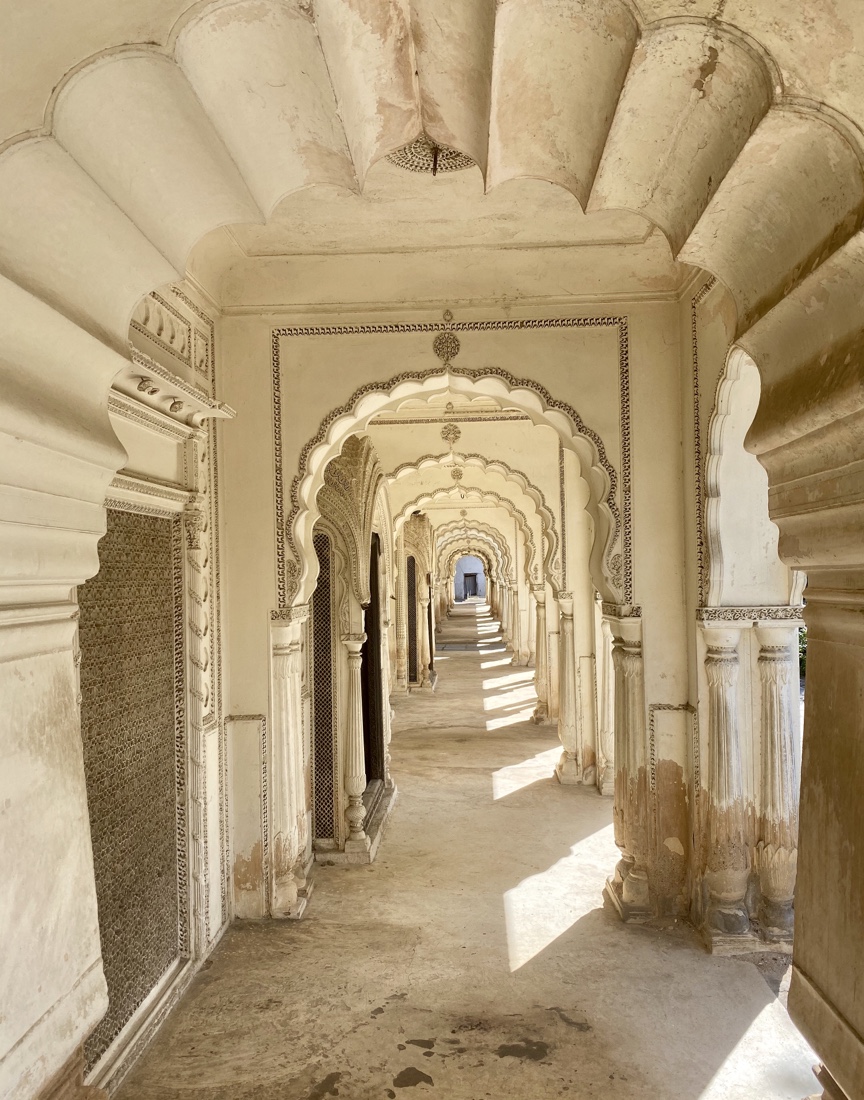
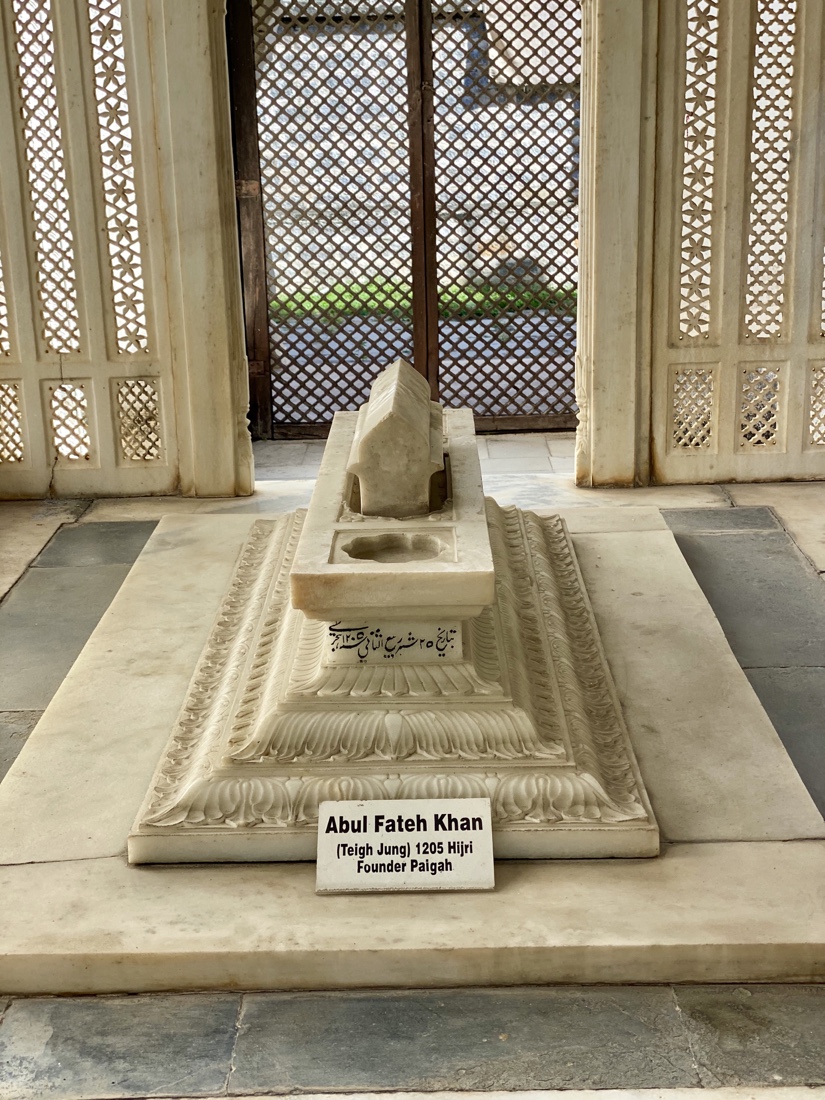 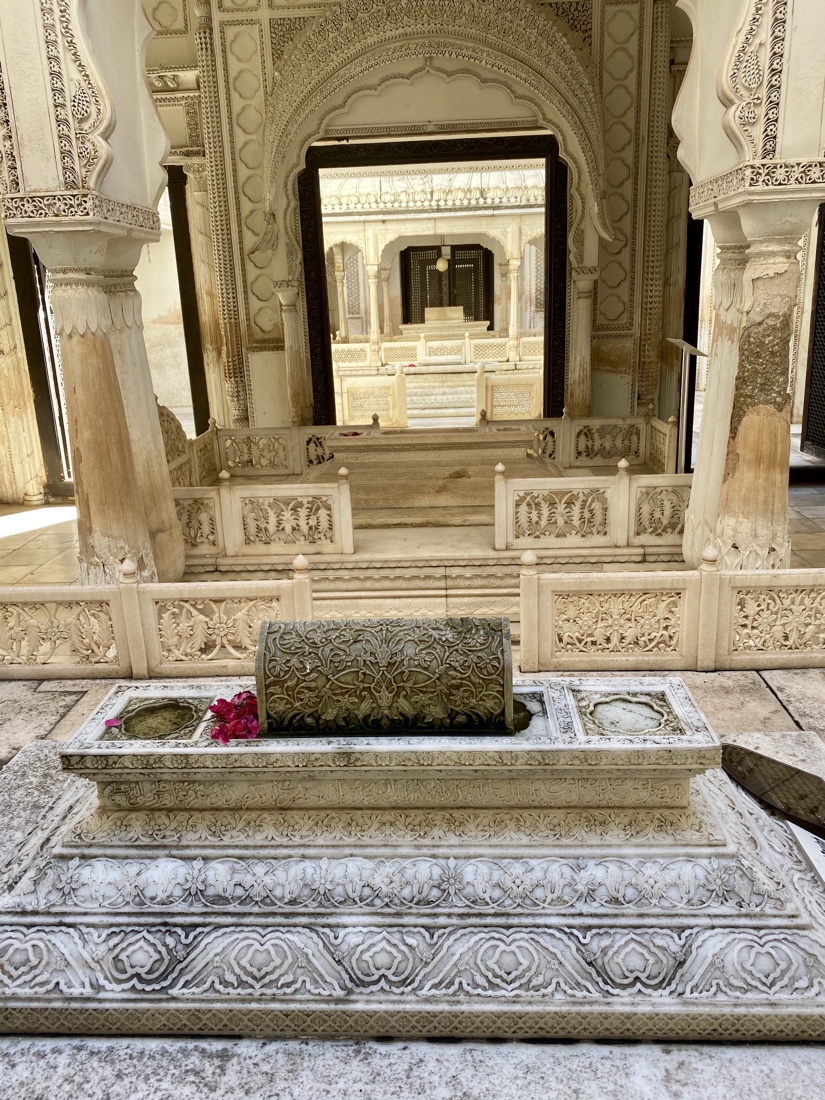 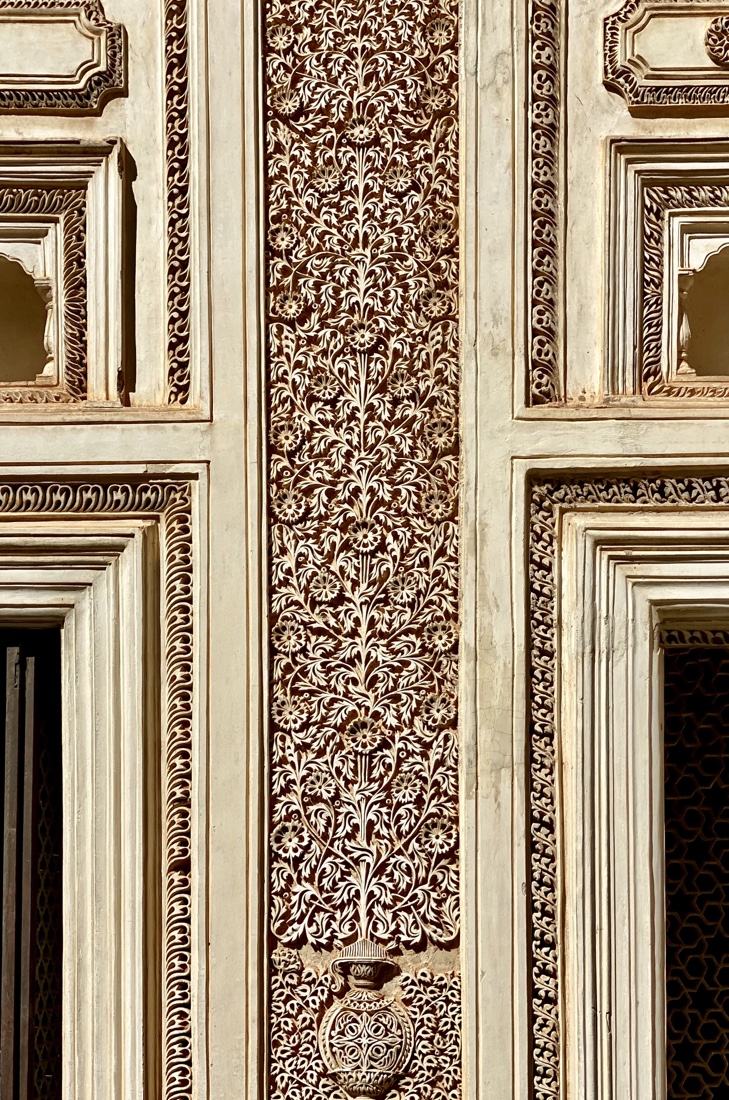 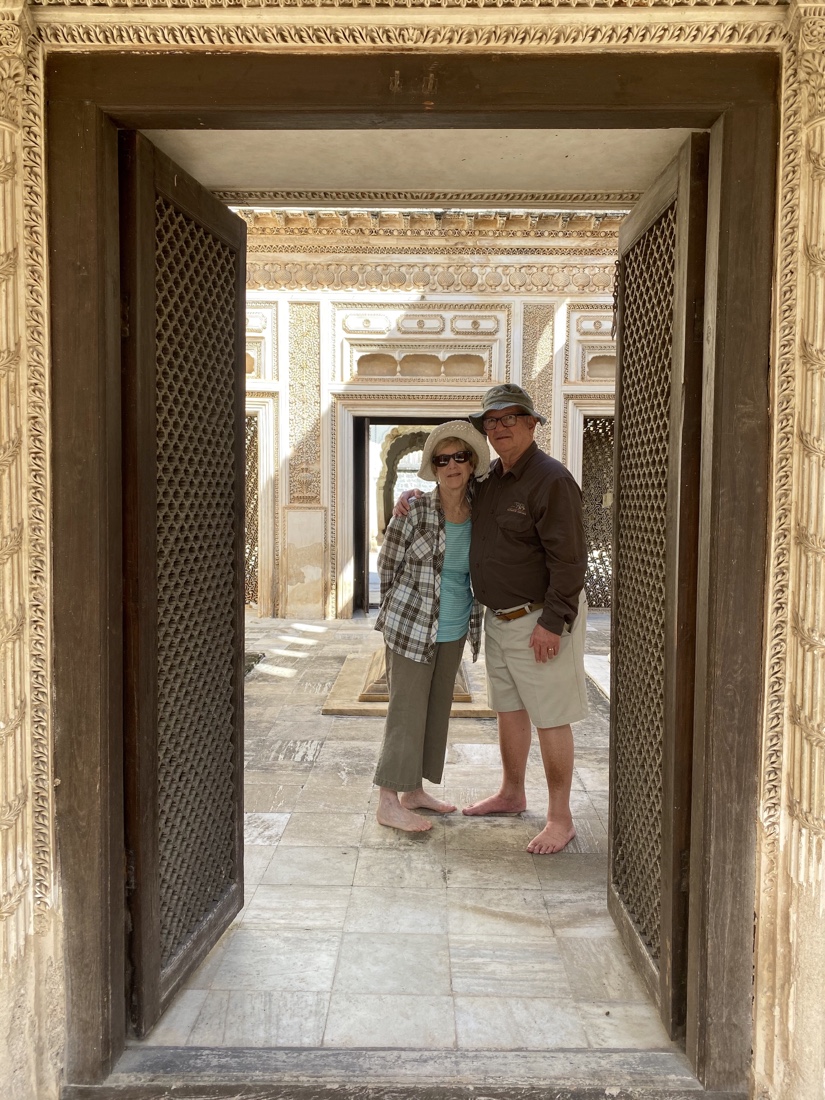 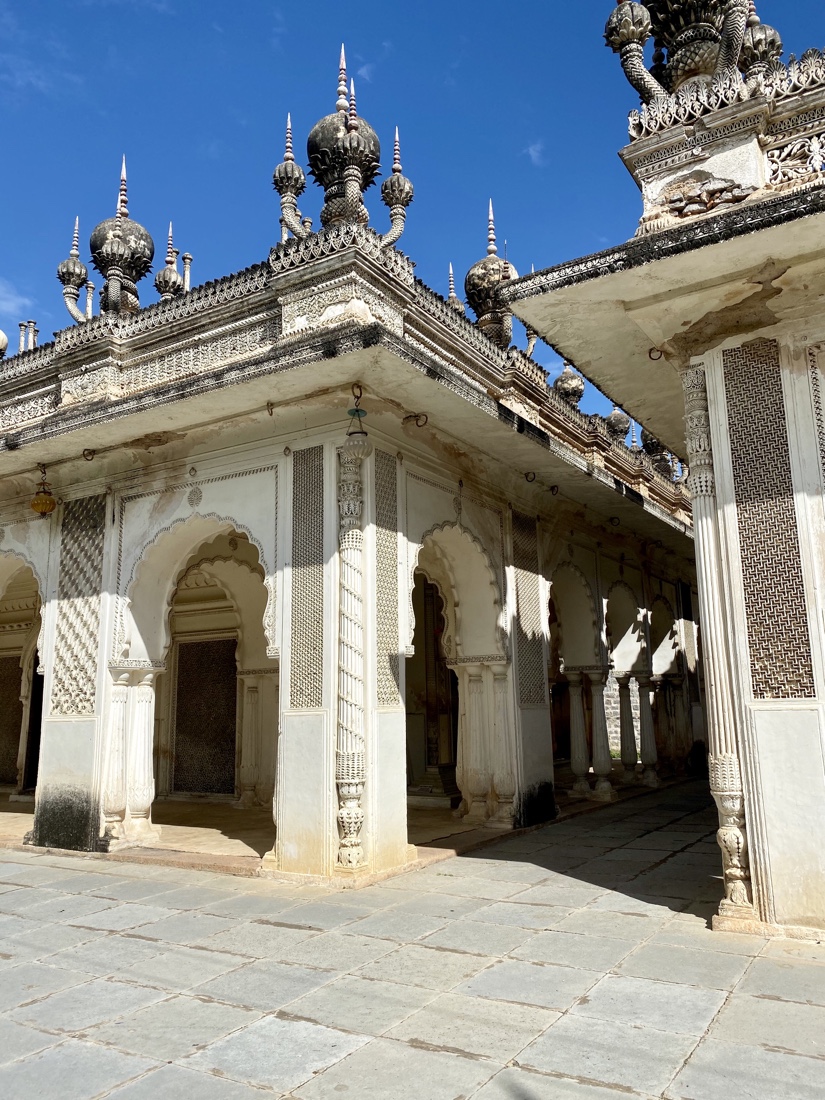 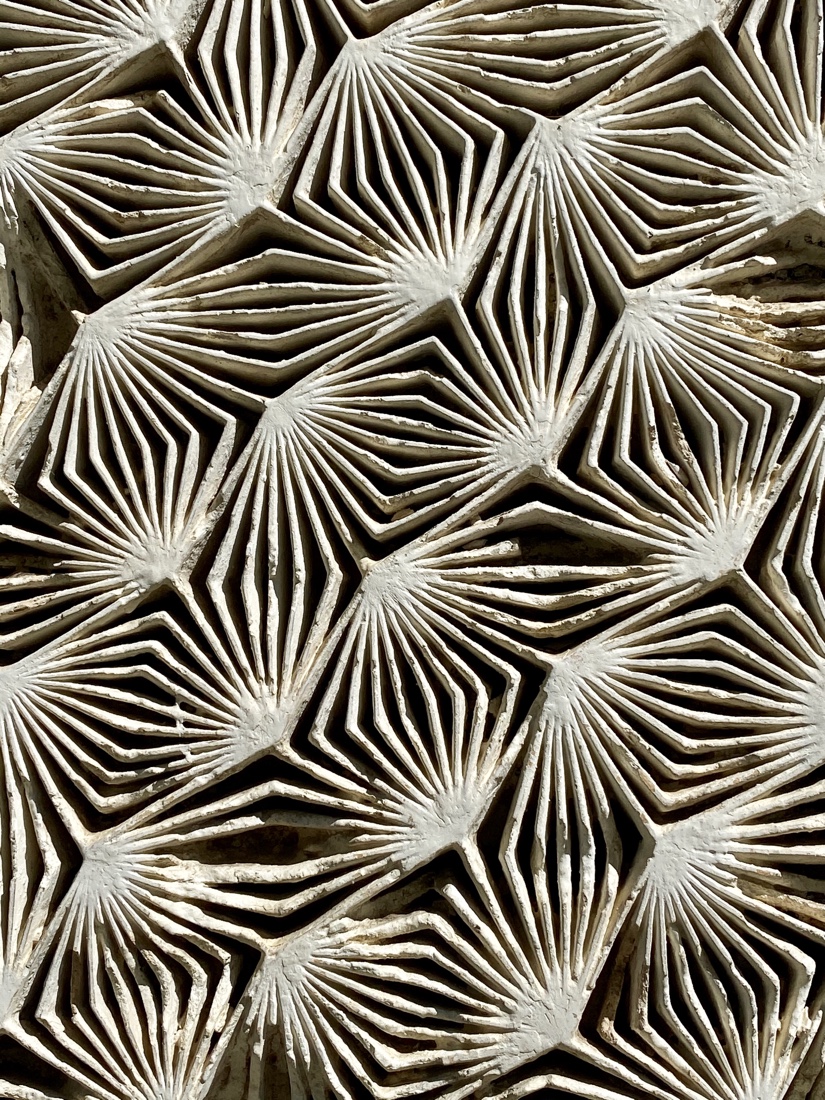
We head next for a vegetable market. Jonty explains what we are seeing, how they are used and more. It’s more vegetables than I, personally, need, but Carol enjoys it.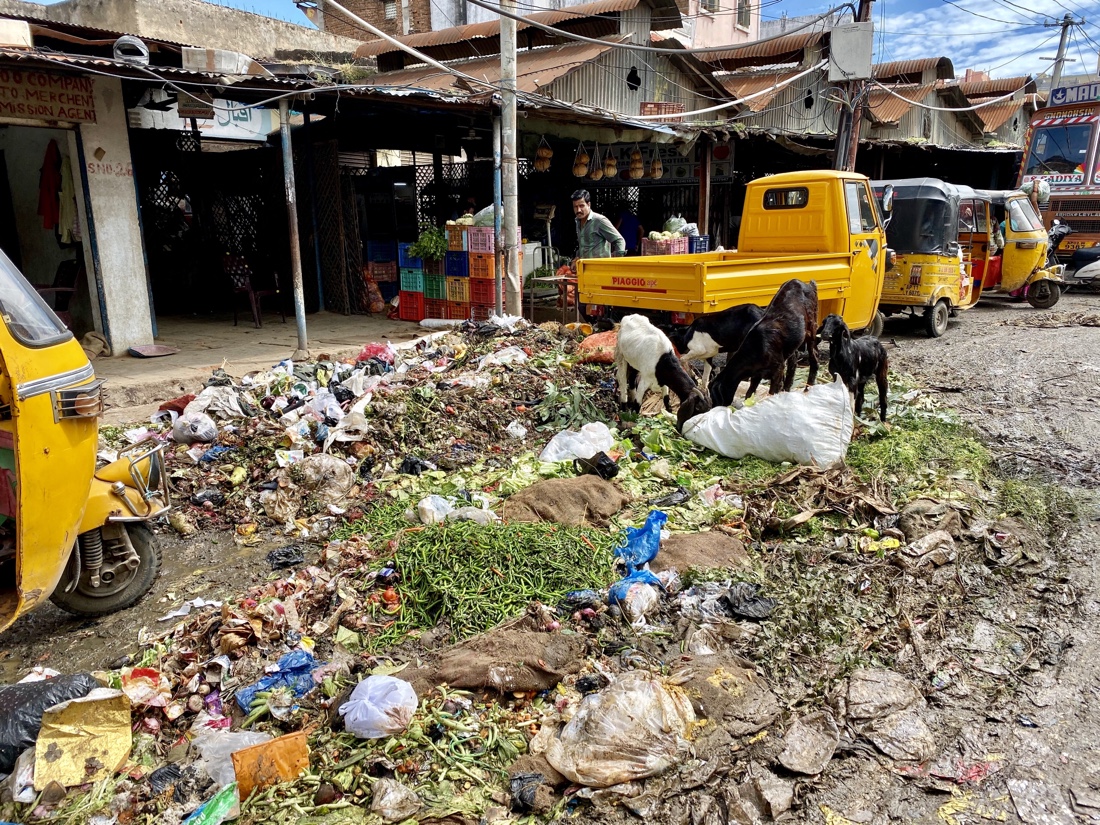   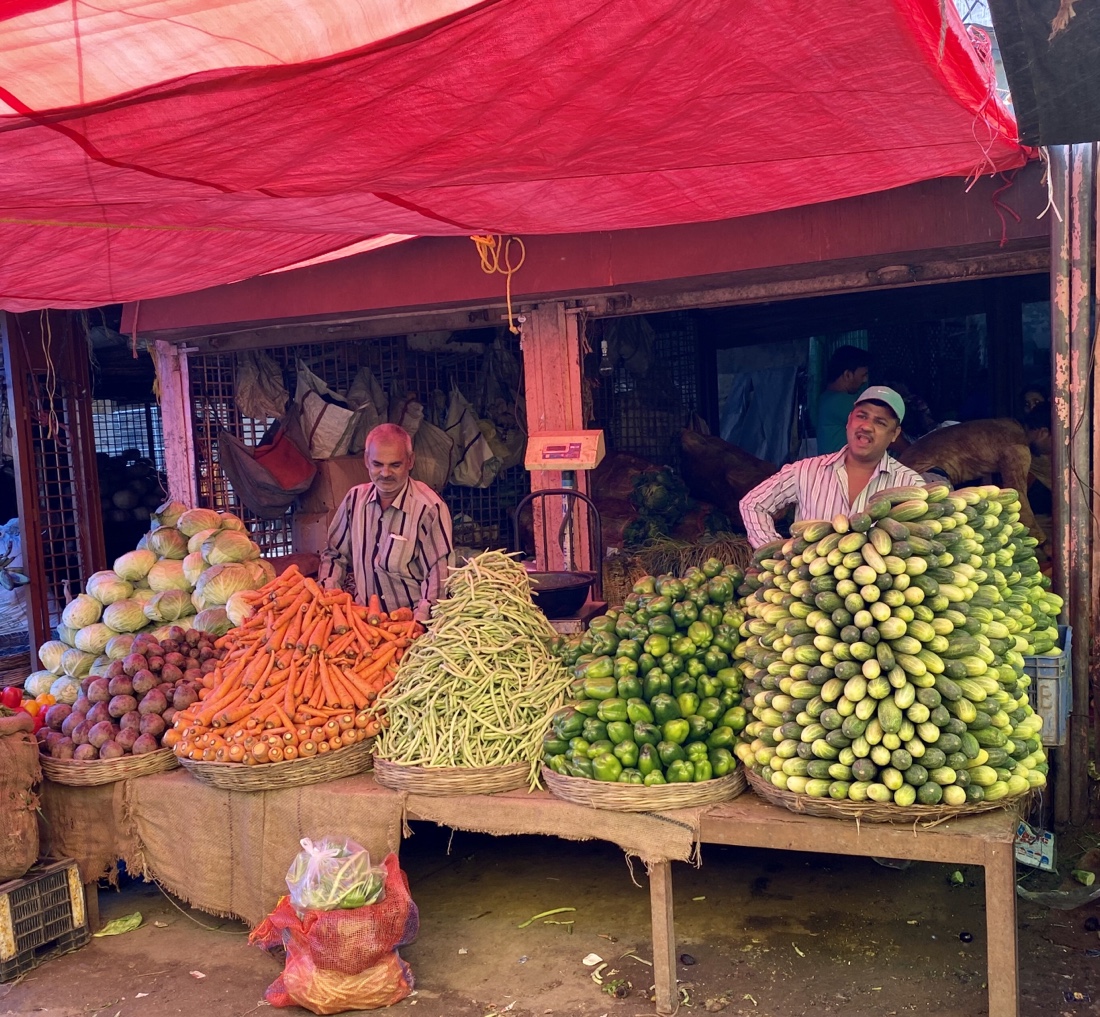 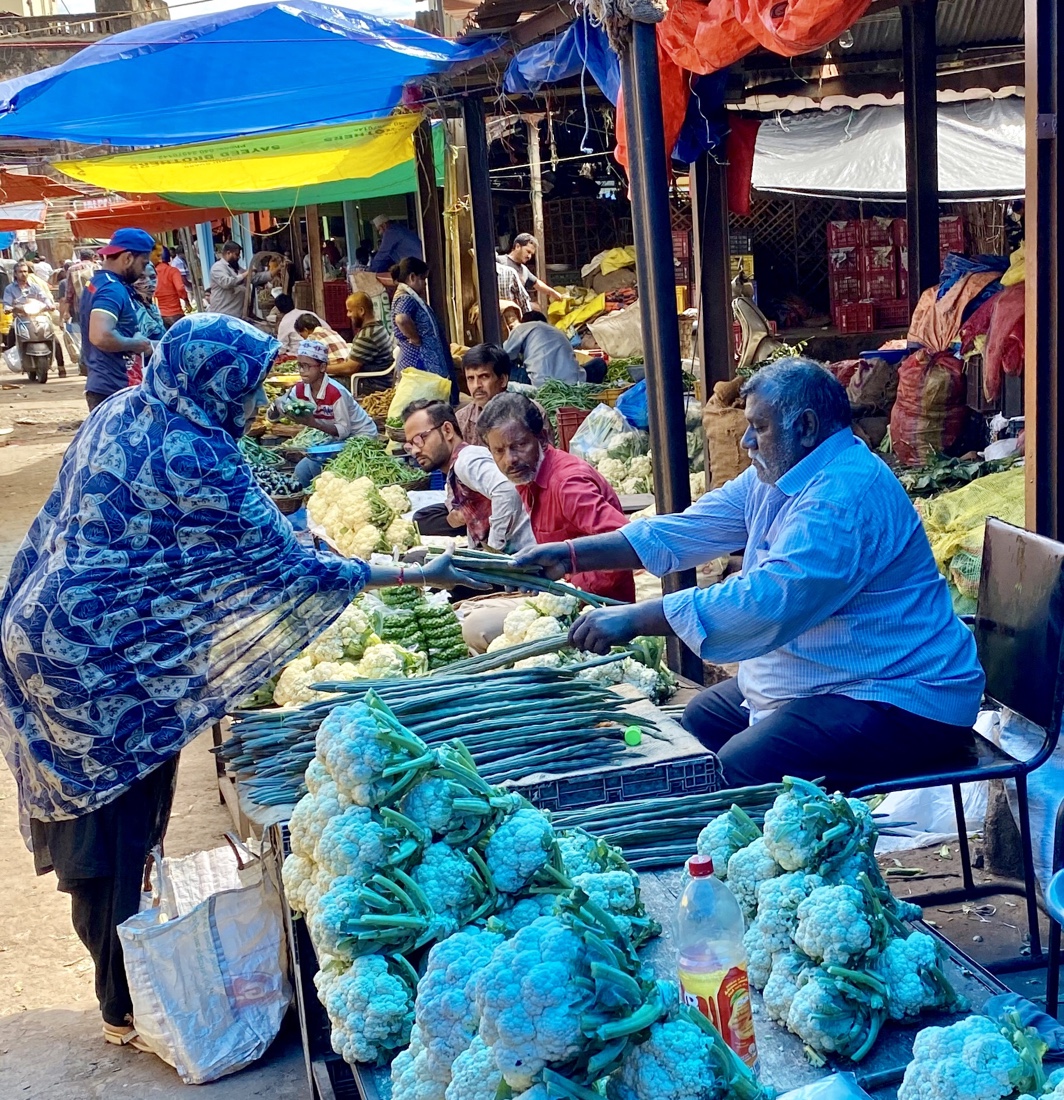 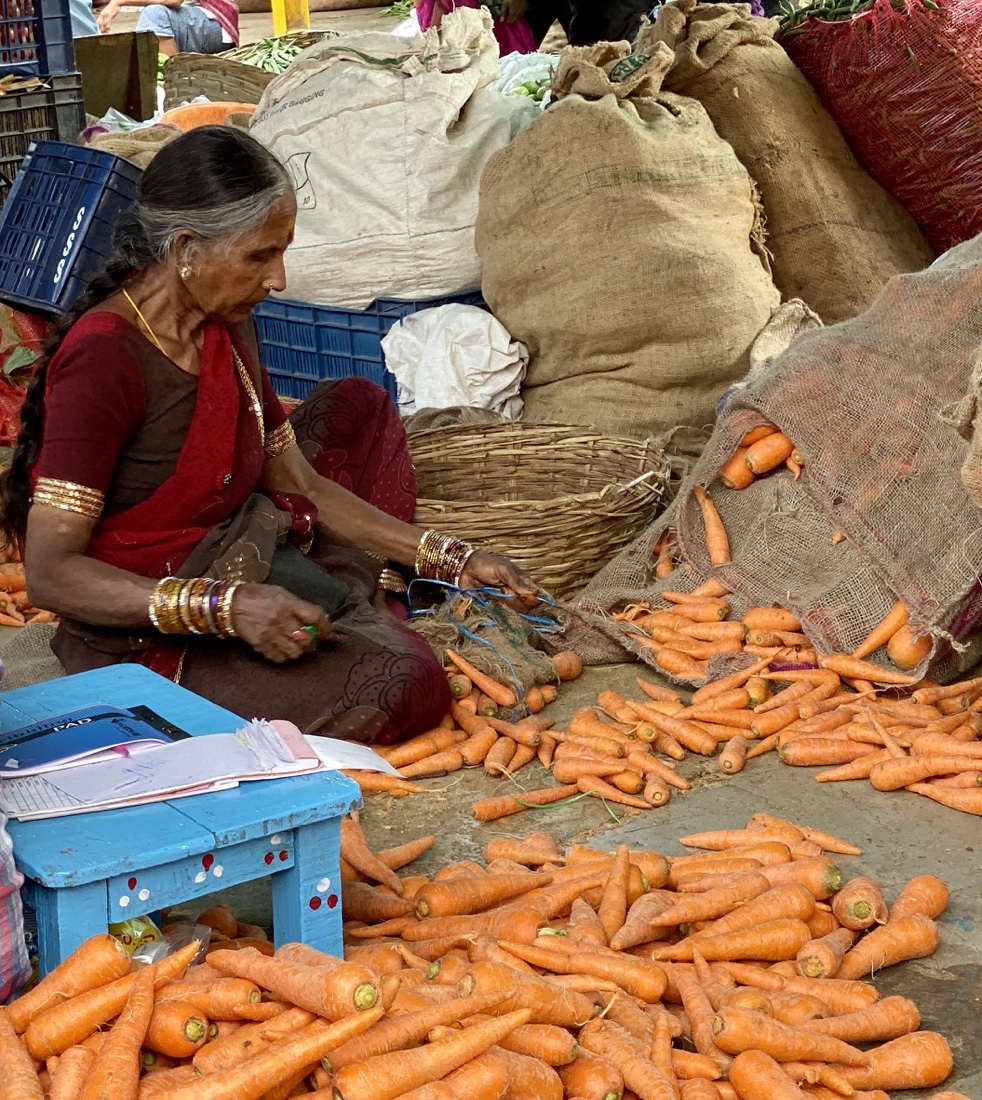
Here’s a creative guide who has built a cash drawer into his seat. 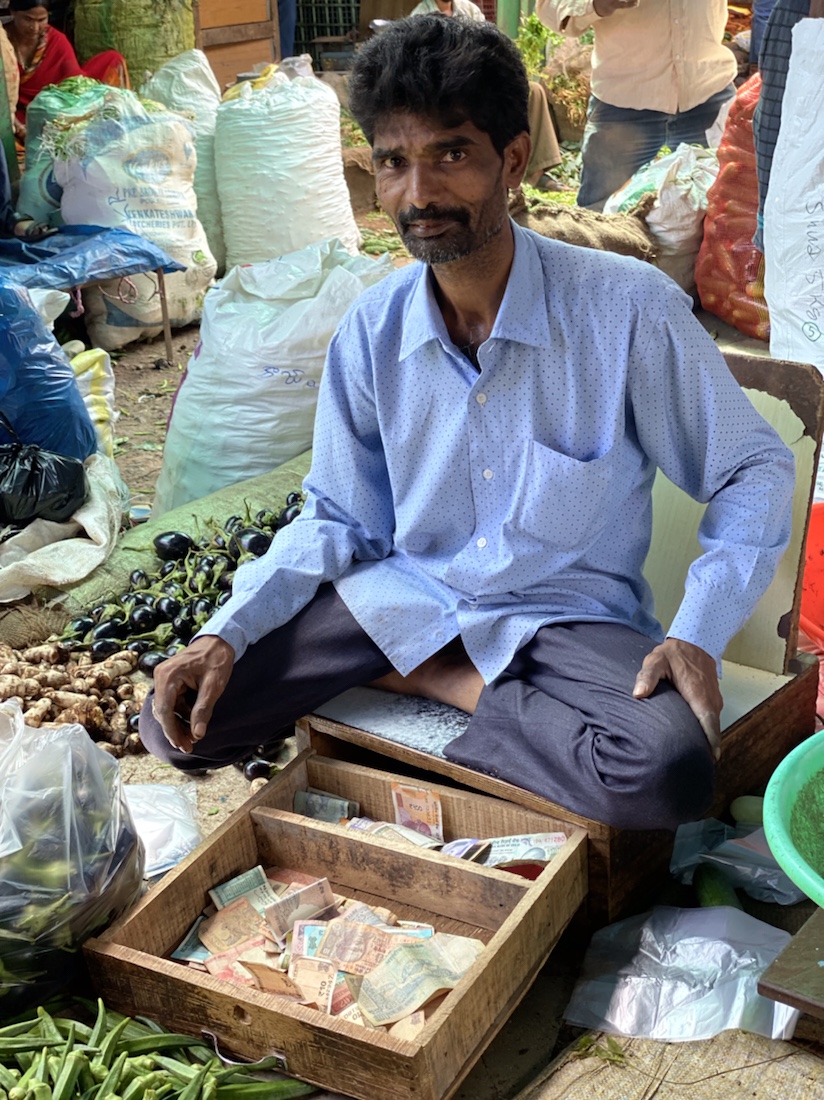
After the market, we head to a private house, where Jonty has arranged for us to have a lunch prepared by the woman who lives there. We first see the altar in the home that they worship at daily. 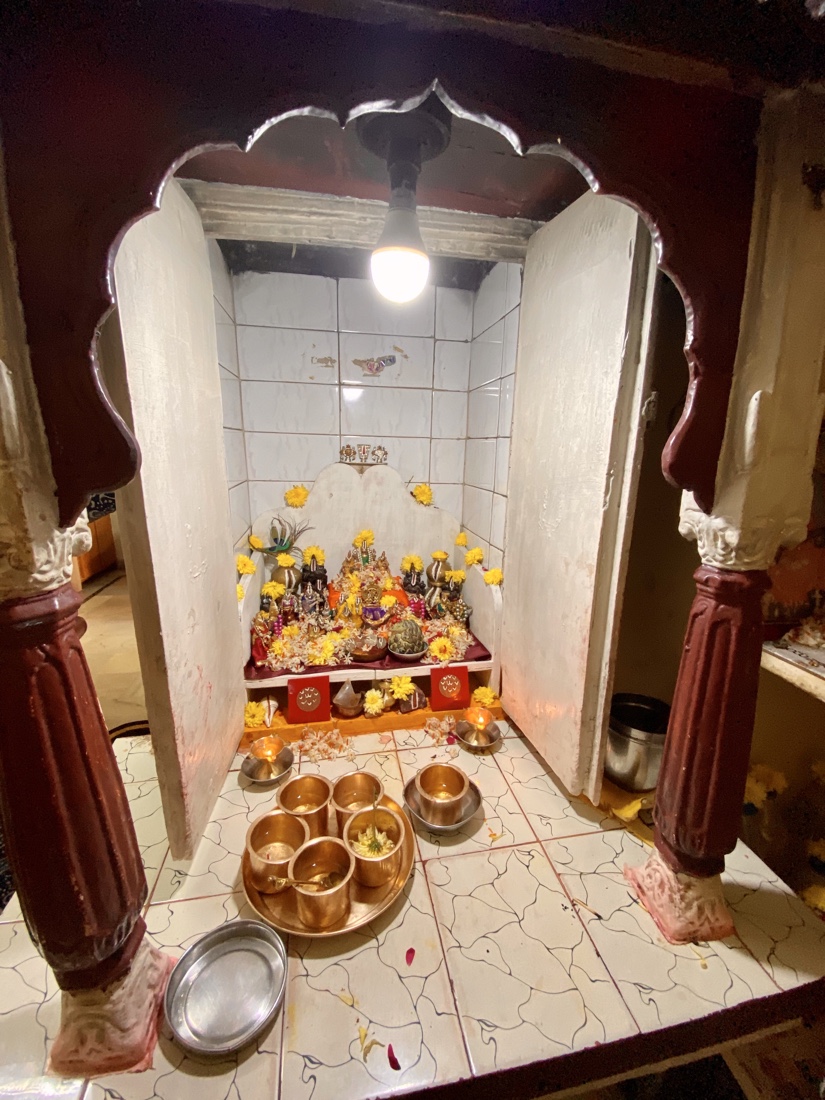 As was true of the vegetable market, Carol likes this far more than I do. She enjoys watching the meal being prepared. Lunch is tasty. As was true of the vegetable market, Carol likes this far more than I do. She enjoys watching the meal being prepared. Lunch is tasty. 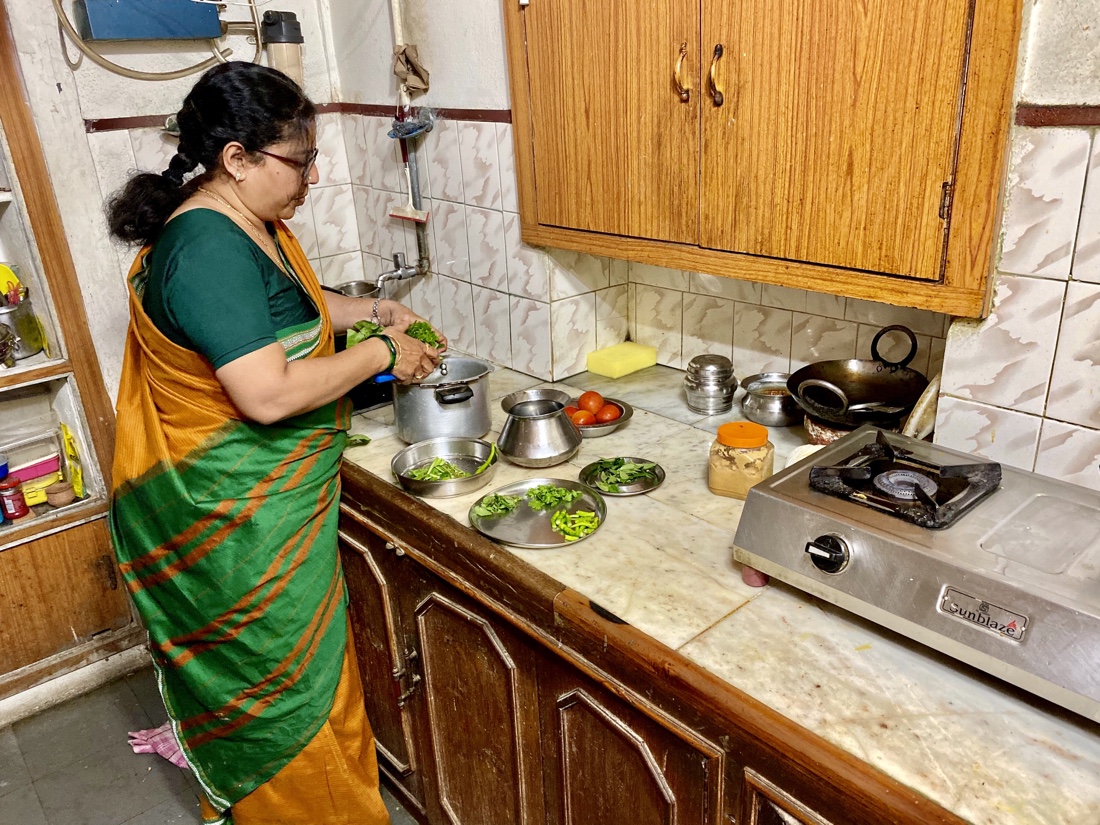 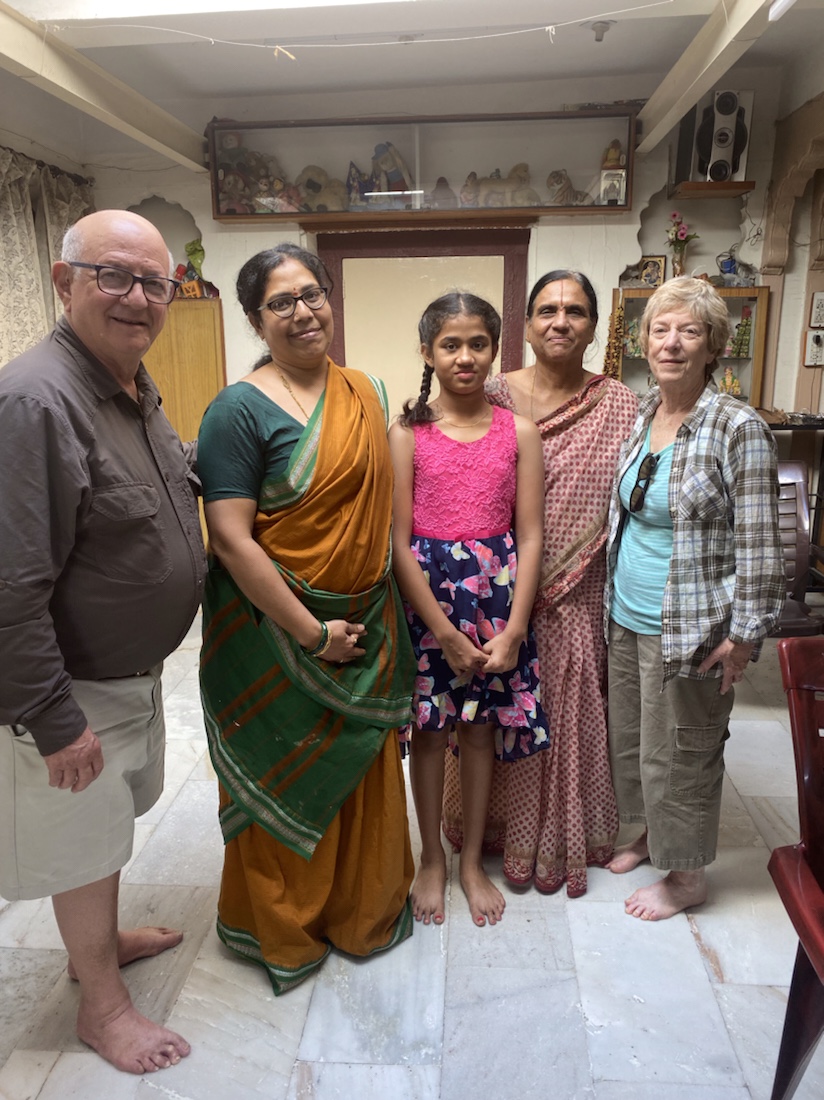
After lunch, we drive to the four palaces of the Chowmahalla Complex. Jonty tells us numerous stories and intrigues about the seven Nizams (Kings) of Hyderabad whose destinies and decisions shaped the history and culture of this region. The Seventh Nizam was once pictured on the cover of Time Magazine as the richest man in the world. The Sixth is the one who built the palace (hotel) we are staying in. We walk through the imposing Durbar Hall and the various rooms which have recreated a slice of life from the past.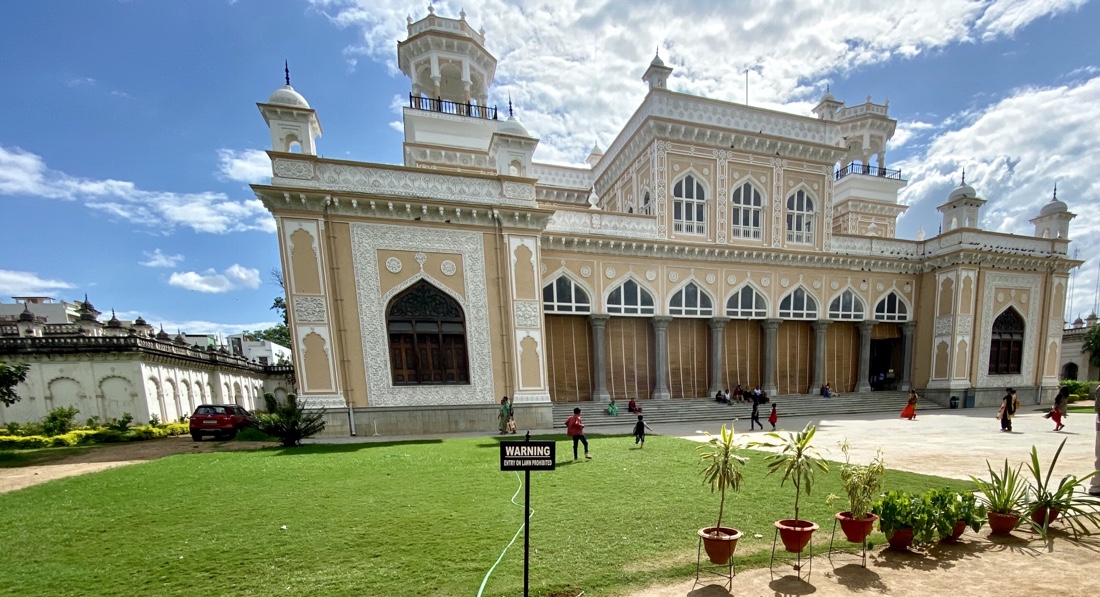 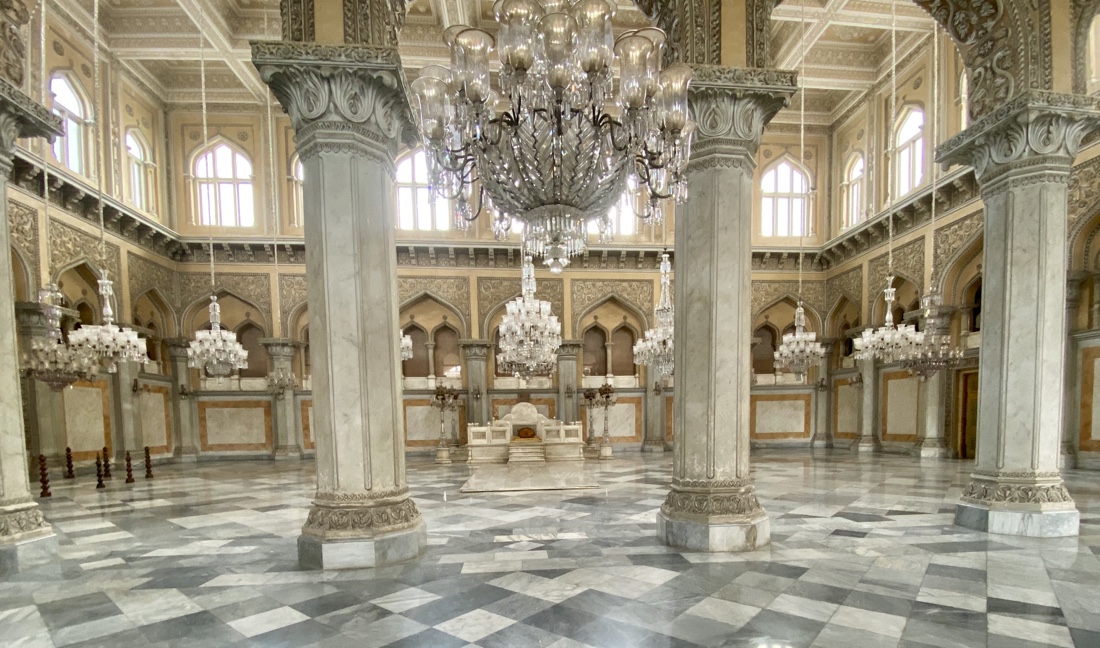
Hyderabad’s charms lie beyond the monuments. The charm of the city is found wandering the through historic Lad Bazaar. We risk life and limb riding in a tuk-tuk from the palace to the bazaar.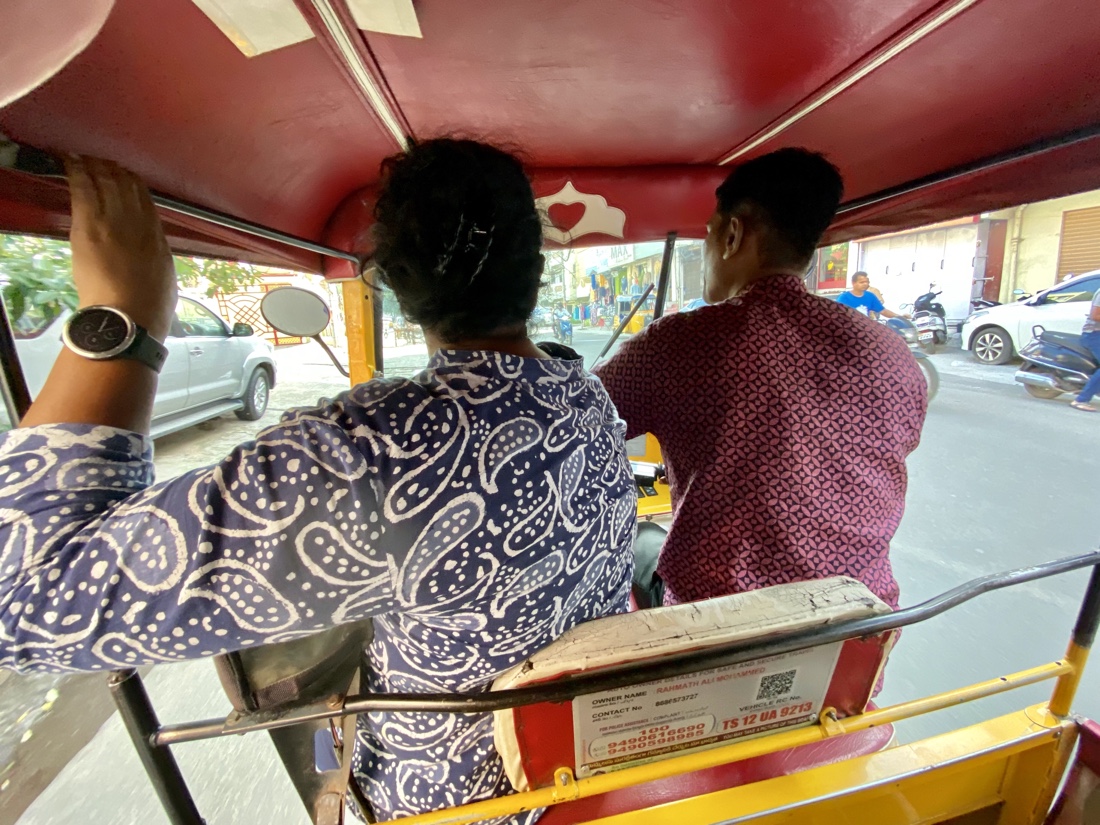 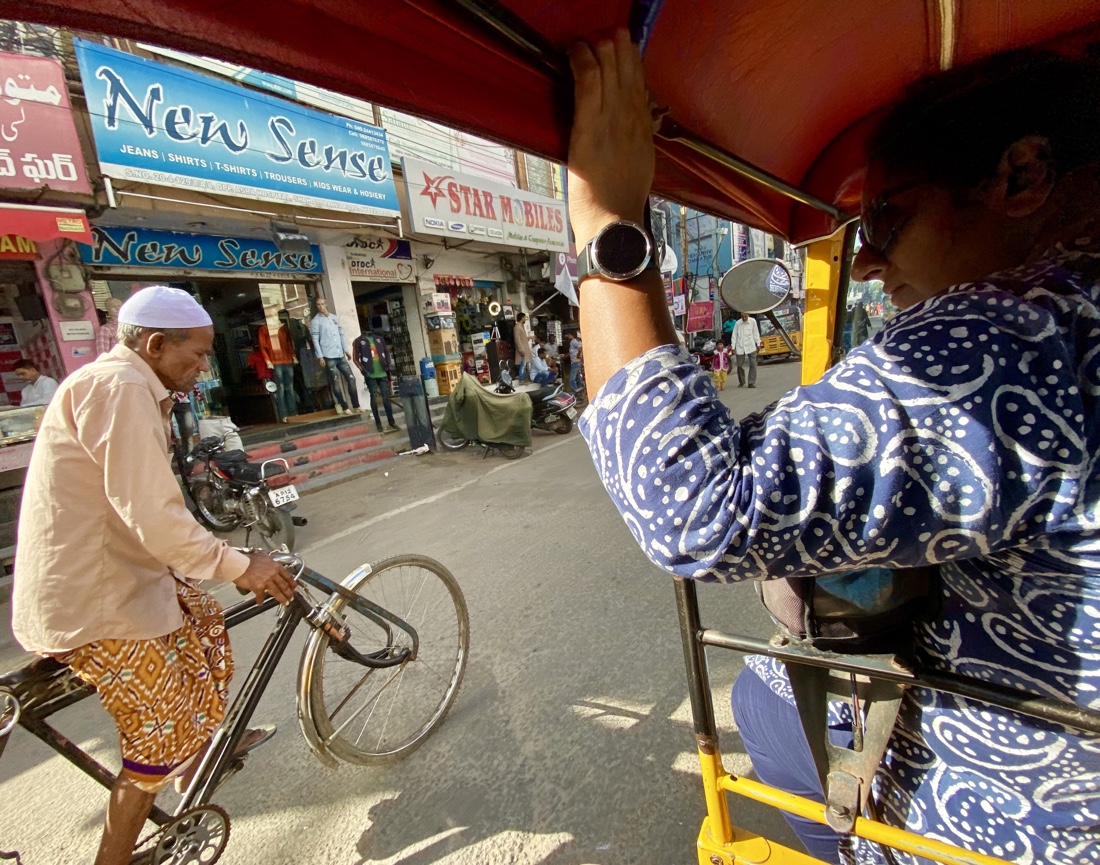 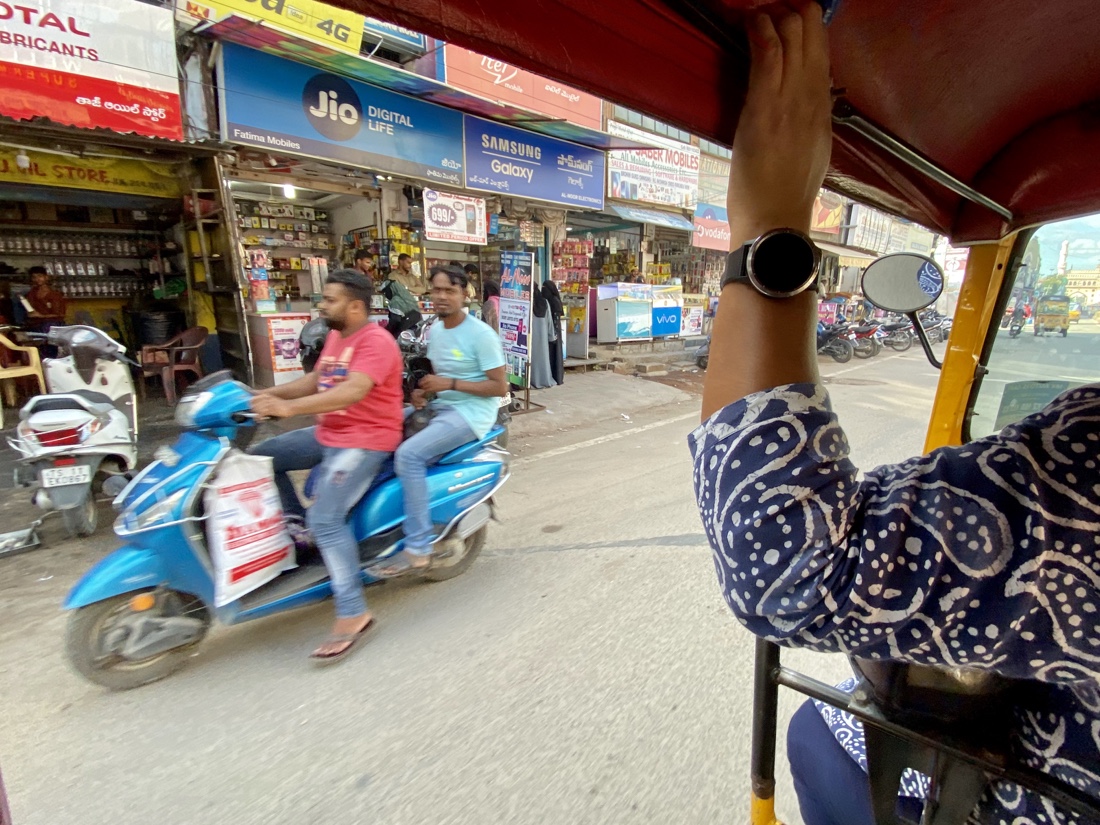 We see the iconic four towers structure in the heart of the market We see the iconic four towers structure in the heart of the market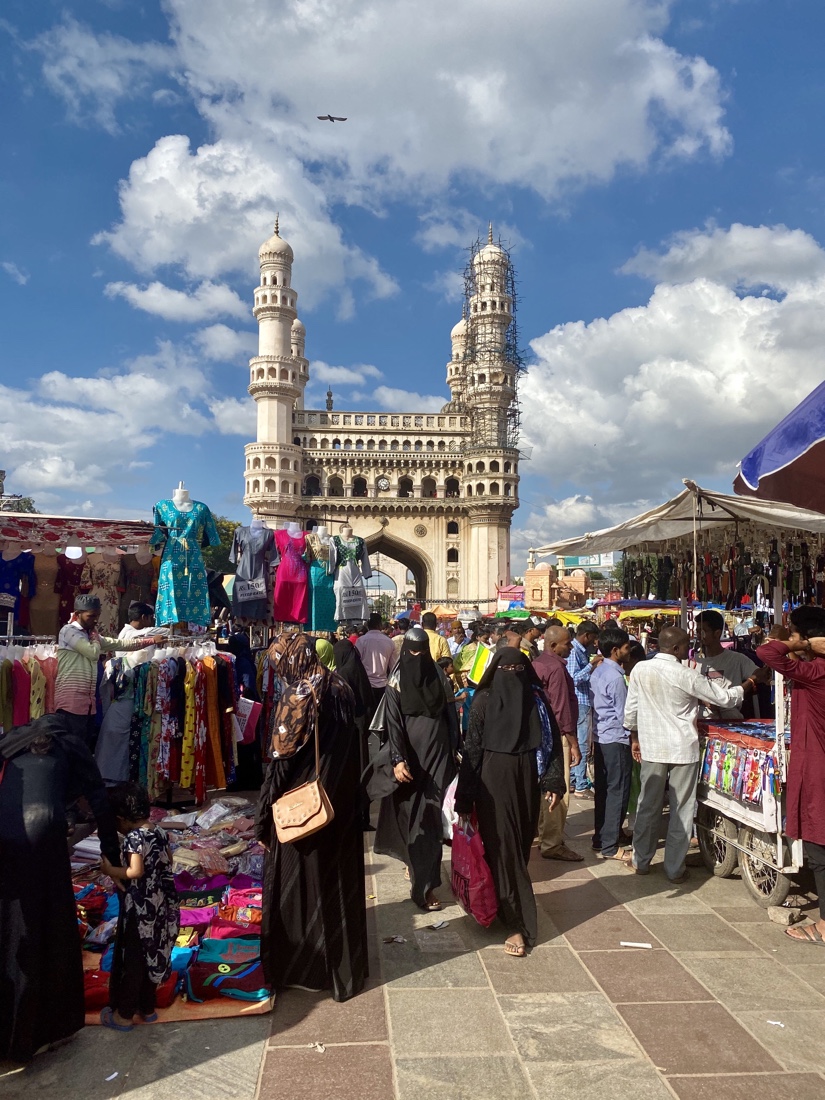 We walk through the colorful and chaotic market where vendors sell an extraordinary variety of items ranging from mundane household goods, to the colorful bangles for which the city is so well known. Carol buys a bunch of bangles, with Jonty’s assistance. It is a slice of Hyderabadi life – vibrant, chaotic and absorbing. We walk through the colorful and chaotic market where vendors sell an extraordinary variety of items ranging from mundane household goods, to the colorful bangles for which the city is so well known. Carol buys a bunch of bangles, with Jonty’s assistance. It is a slice of Hyderabadi life – vibrant, chaotic and absorbing.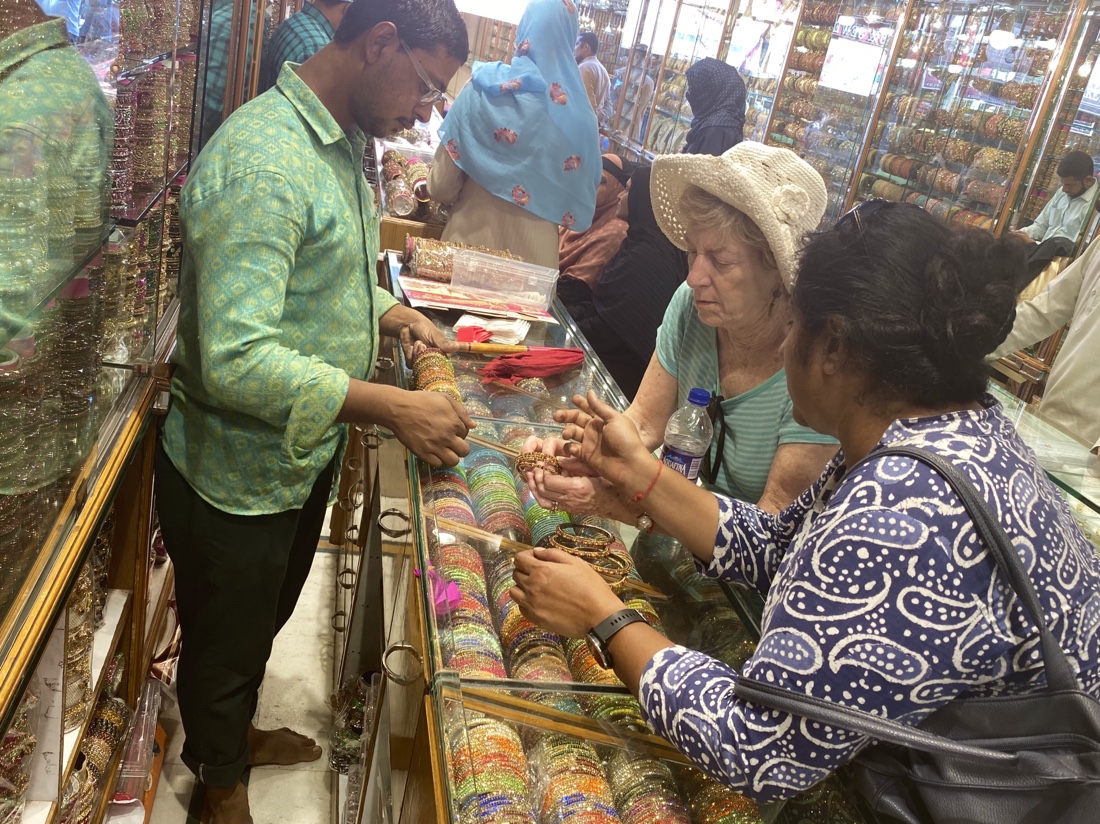
After the bangles, we return to the hotel, bid a fond goodbye to Jonty and try the palace tour again with another, understandable guide. This time it’s far better and the quite incredible palace is a treat. These few photos won’t do it justice, but at least they’ll give you some idea.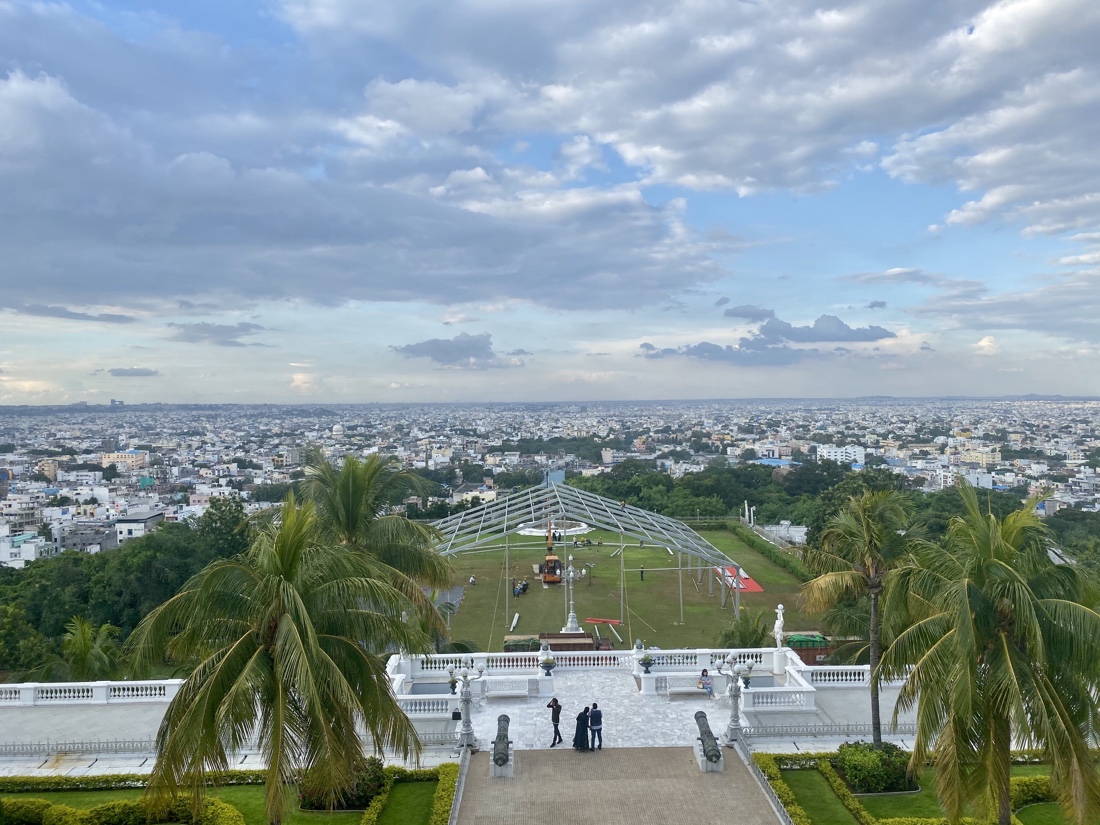 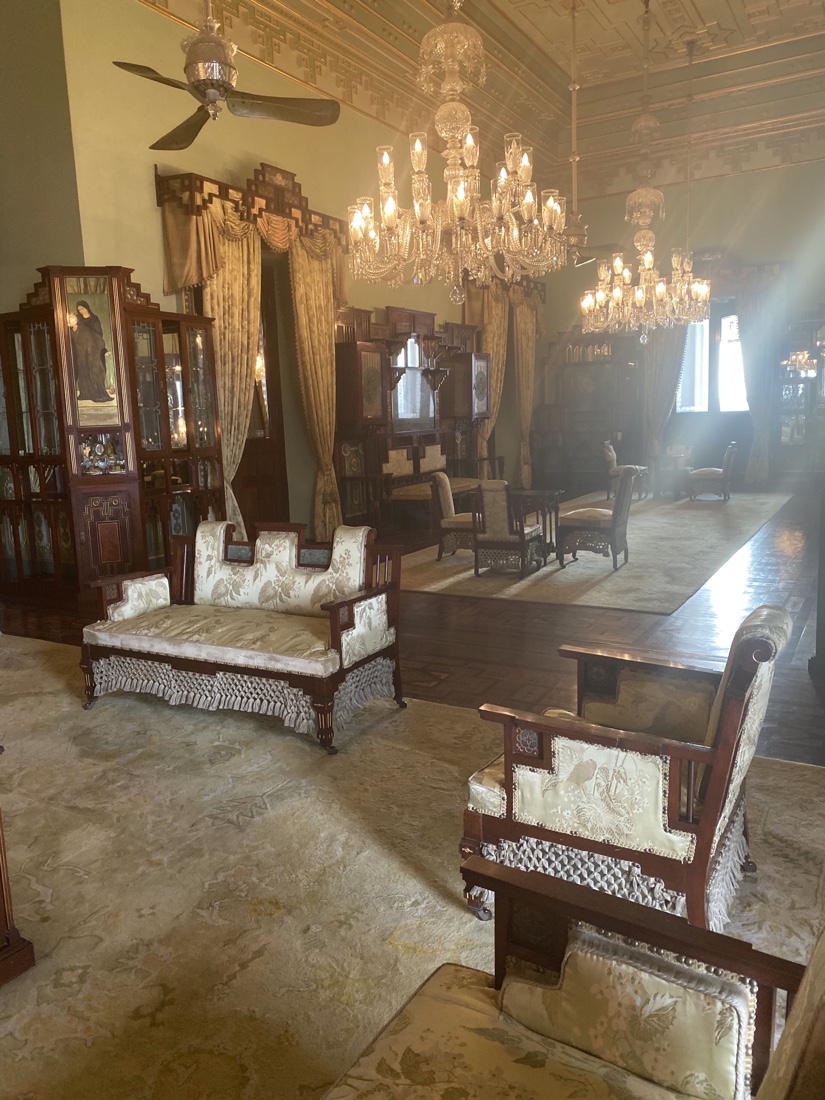 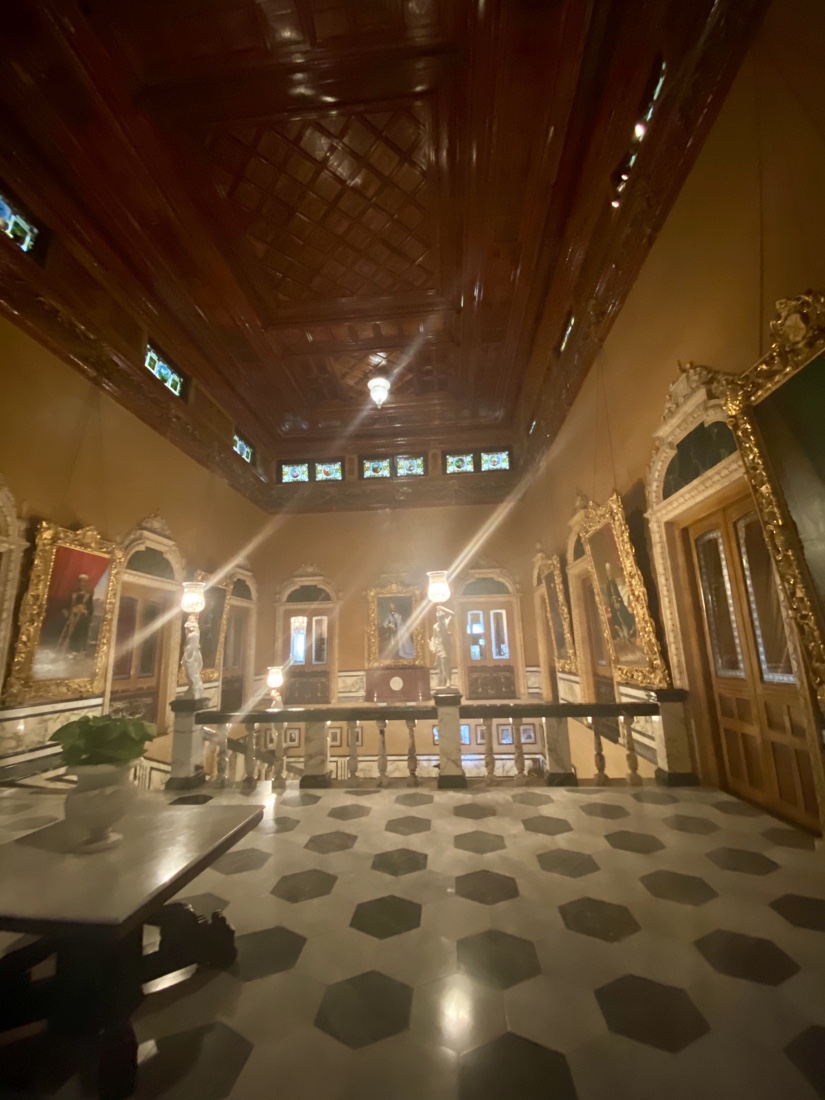 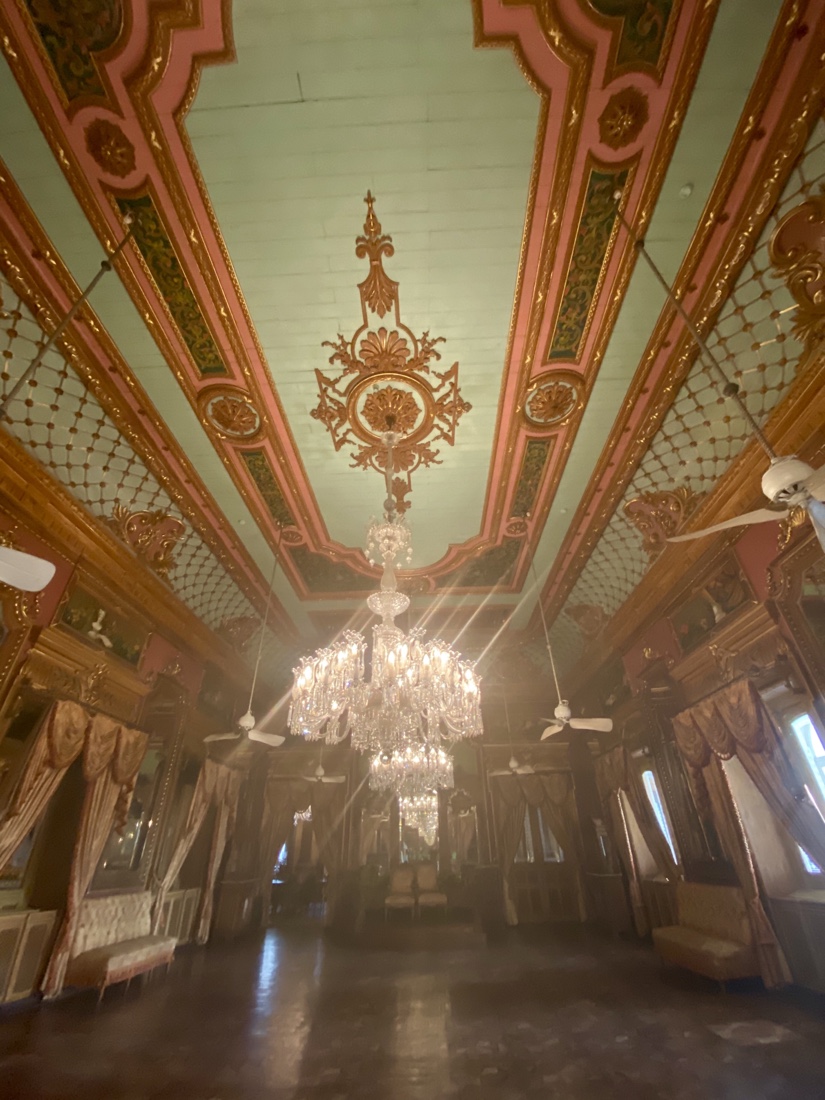
My favorite is the dining table that seats 101 guests, which we are told is the largest in the world.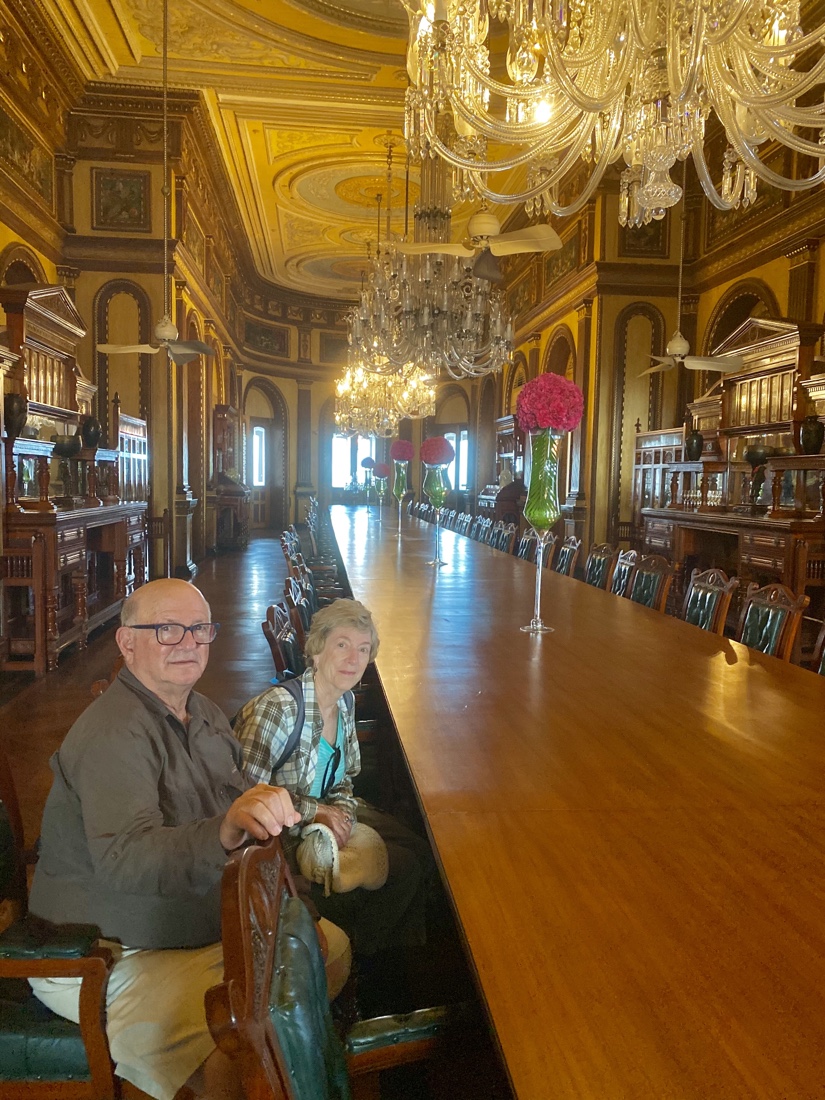
We return to our room and find that the two swans who were at the foot of our bed have morphed into an octopus.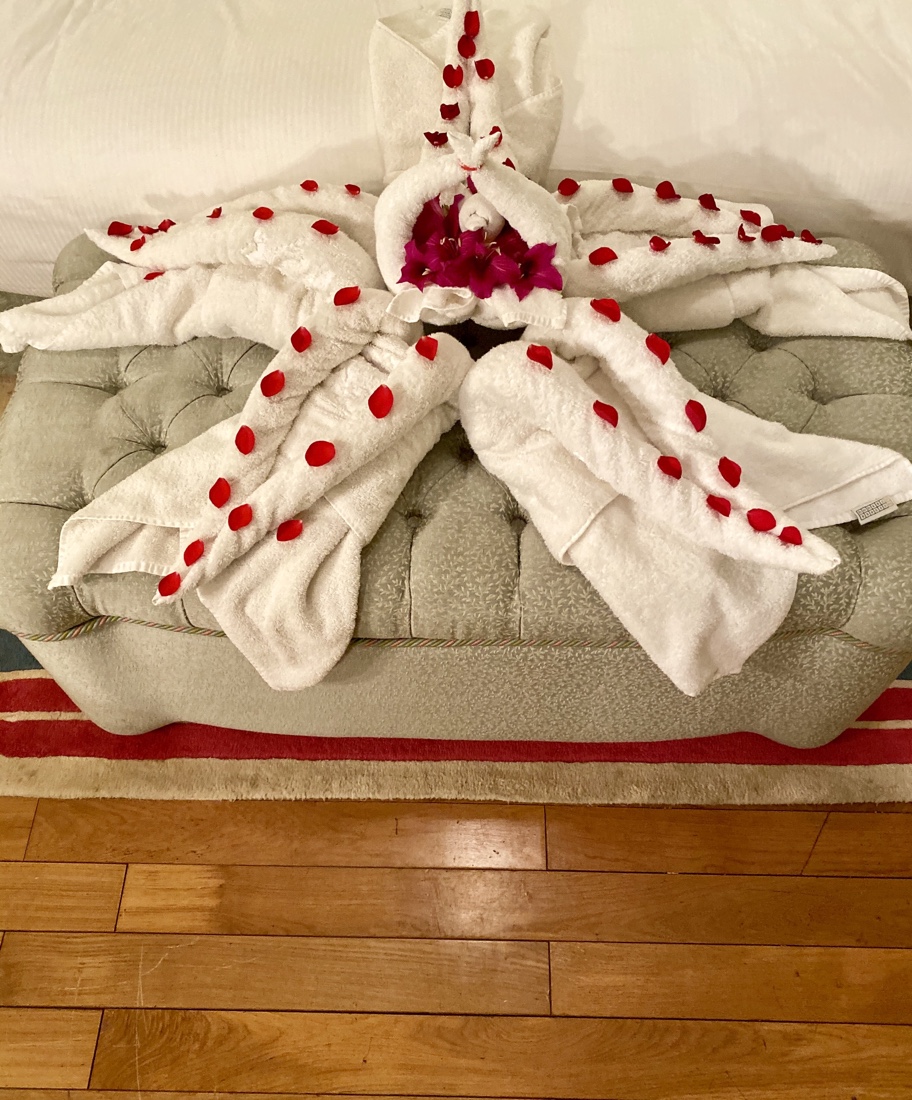
We’ve about had it with going to restaurants, so we opt to order into our room. I order–would you believe it–a pizza, and it’s absolutely fantastic. Carol’s minestrone and a paratha are also excellent. We pack and get ready for tomorrow’s very early departure.
October 25
Our guide in Hyderabad is Ms. Jayanti ‘Jonty’ Rajagopala, a B-school graduate from XLRI, Jamshedpur who comes with over 13 year’s experience in sales, marketing and program management with organizations including Titan Industries and the Bill & Melinda Gates Foundation.
Apart from specialty tours in and around Hyderabad, Jonty also leads an annual 12-day culinary tour across India. A certified, albeit fussy foodie, her biggest passions of food, history and her love for offbeat locations keeps her exploring the length and breadth of India.
Jonty started her tour company with the aim of showcasing her own country in a different way. For her, the most interesting part about India is the cultural diversity, even within a state, not to mention across the subcontinent. Being an avid traveller, she’s always curious to know more about the people, traditions, and especially the food of a region that she visits. The experience that she aims to create is based largely on what she has enjoyed on her travels…slightly offbeat and full of interesting stories and conversations with locals, all of which you would not experience on your own.
Jonty gives us a very succinct and well-thought out overview of South India, including notes on its history, differences from North India, its weather, including the importance of the strength and timing of the monsoon, the central role of the Himalayas in weather and politics, and a description of the different Indian states.
We start our day with a visit to the Golconda Fort and the exquisite Qutb Shahi tombs. The history of the fort dates back to the 12th century when it was originally built of mud by the Hindu Kakatiyas. Within the fort are the royal palaces, the harem, halls for both public and private audiences, royal baths and a temple. The huge vaults once held the famous Kohinoor and Hope diamonds. 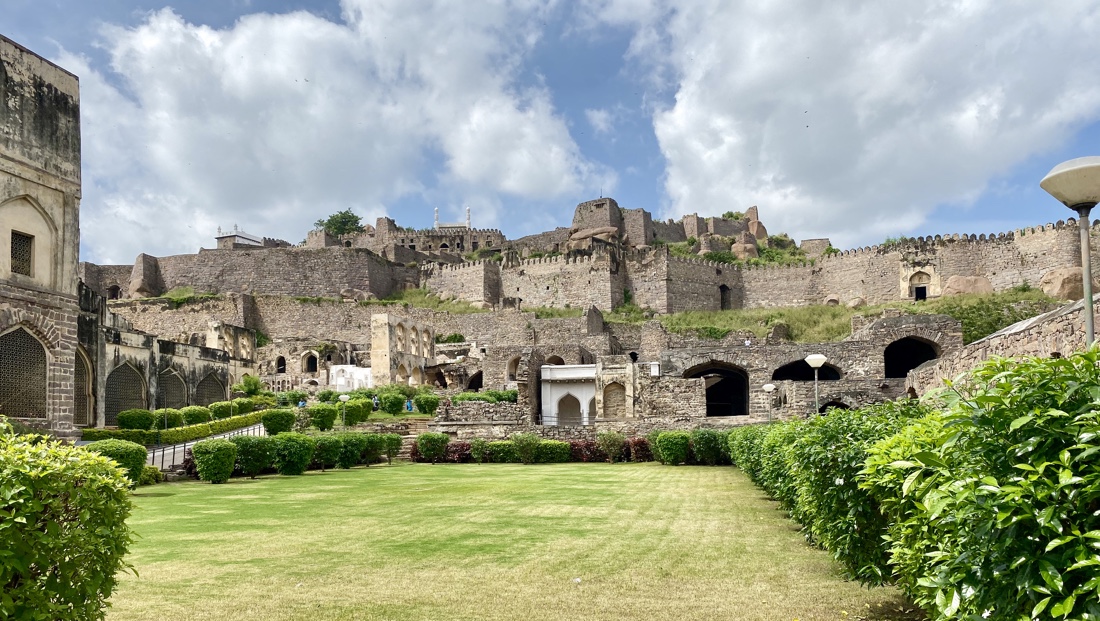 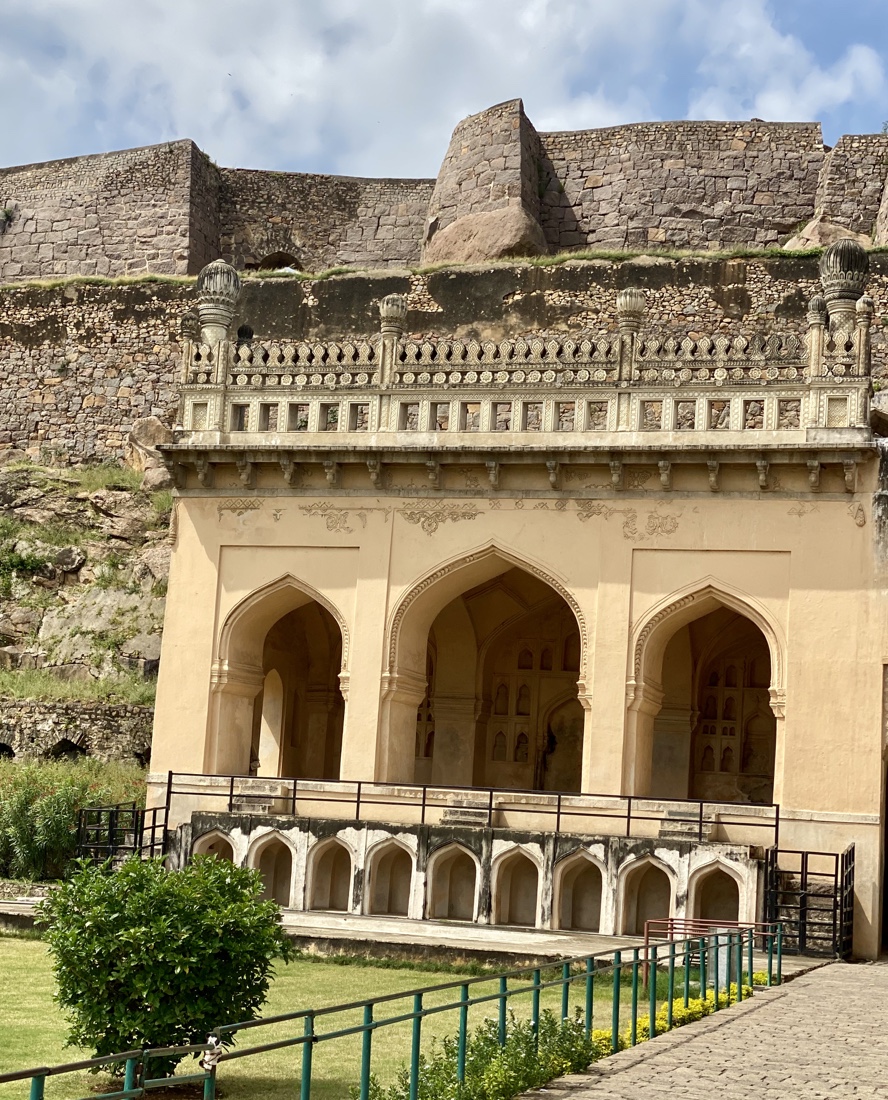 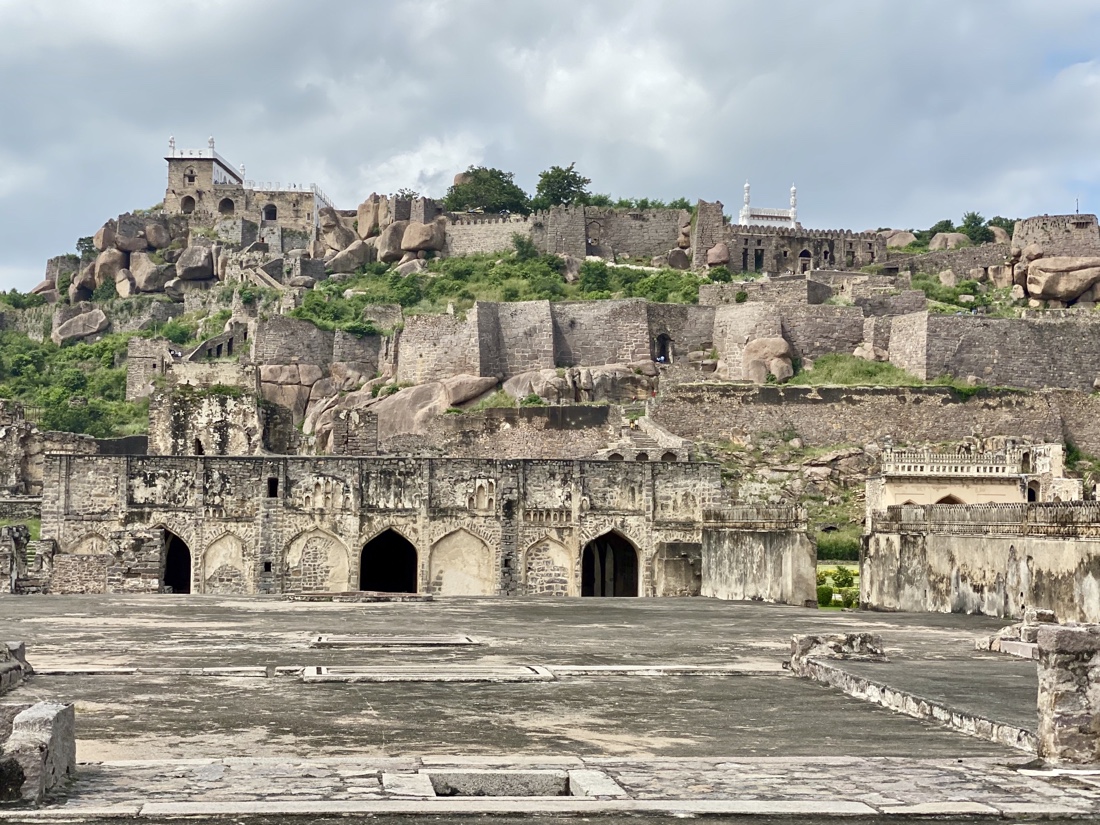
We also visit the Qutb Shahi Tombs of 16th and 17 th century kings.
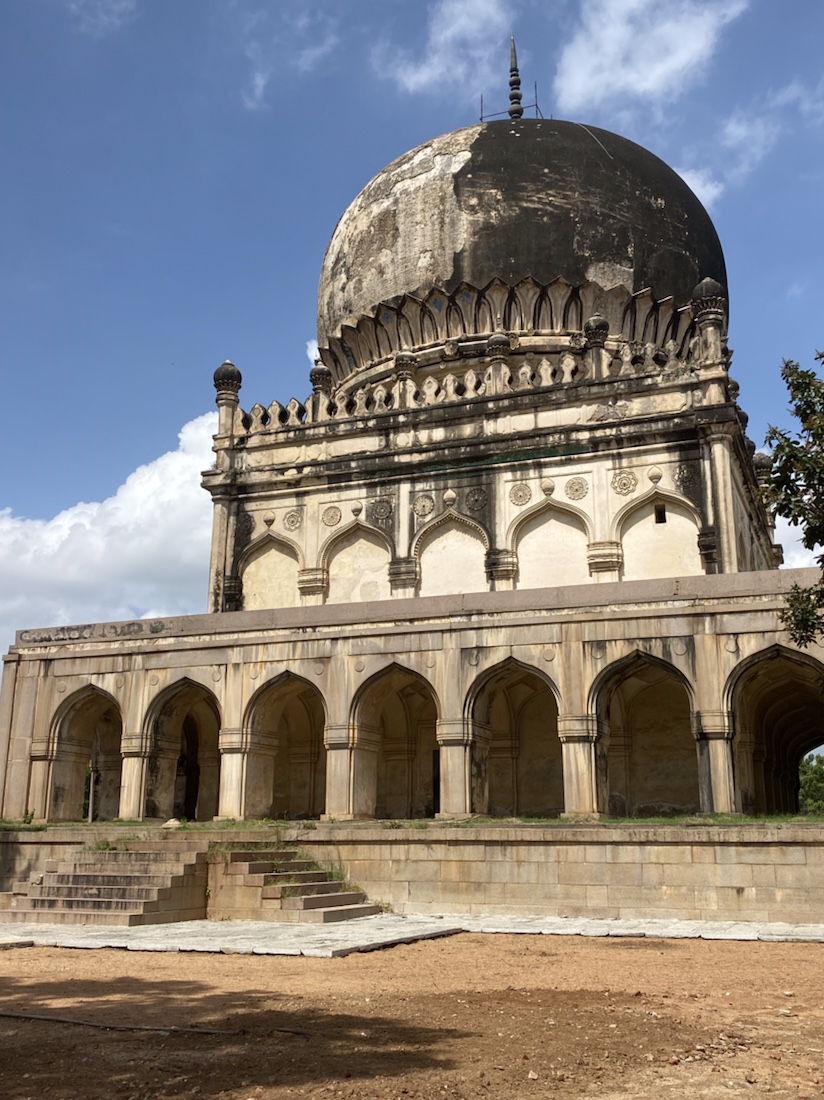 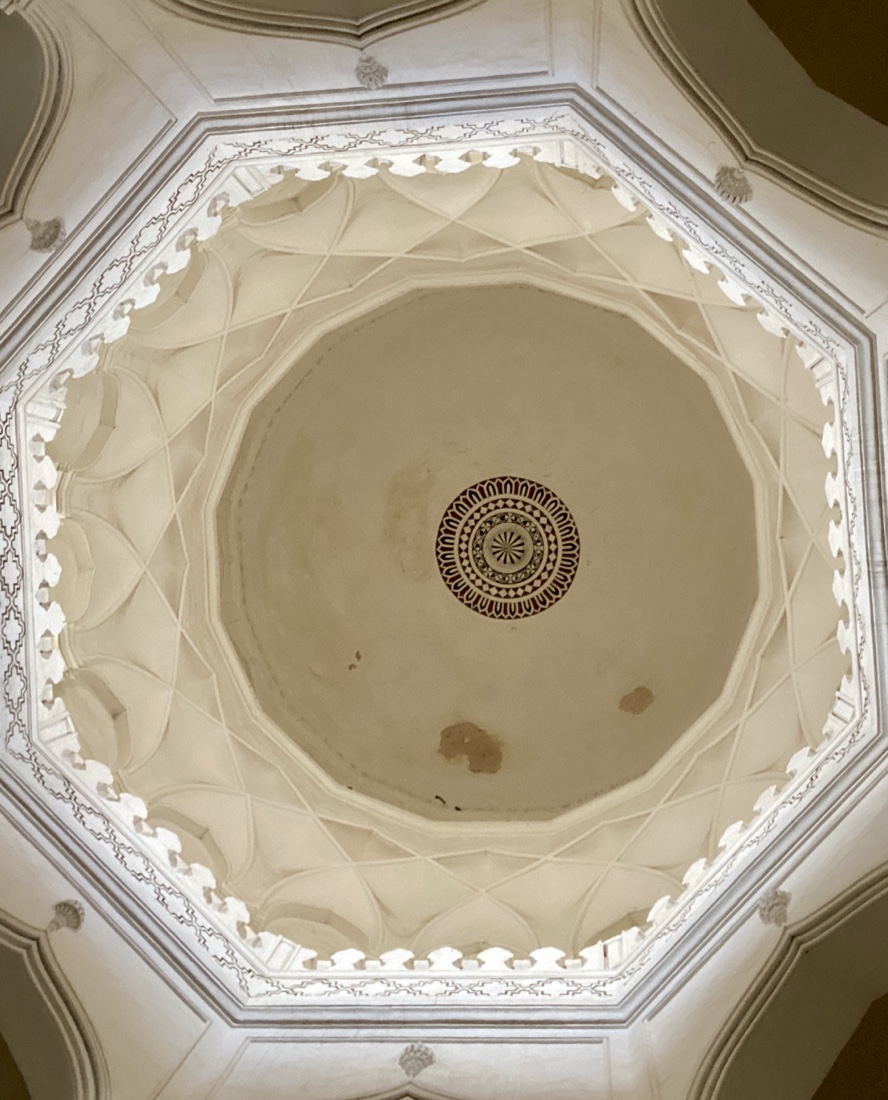 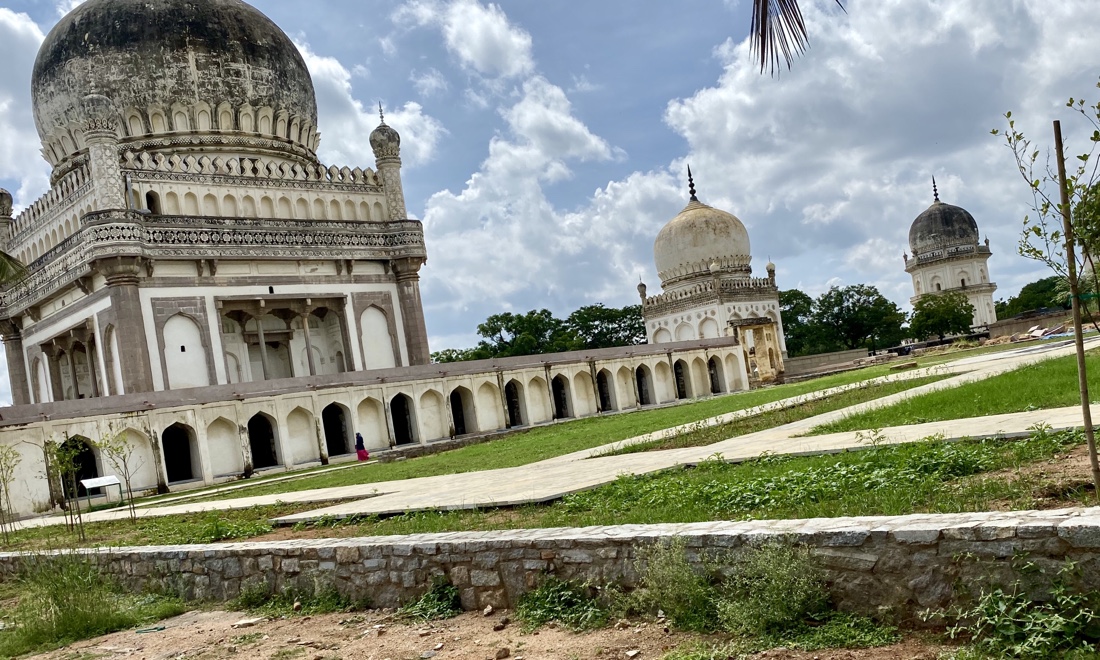
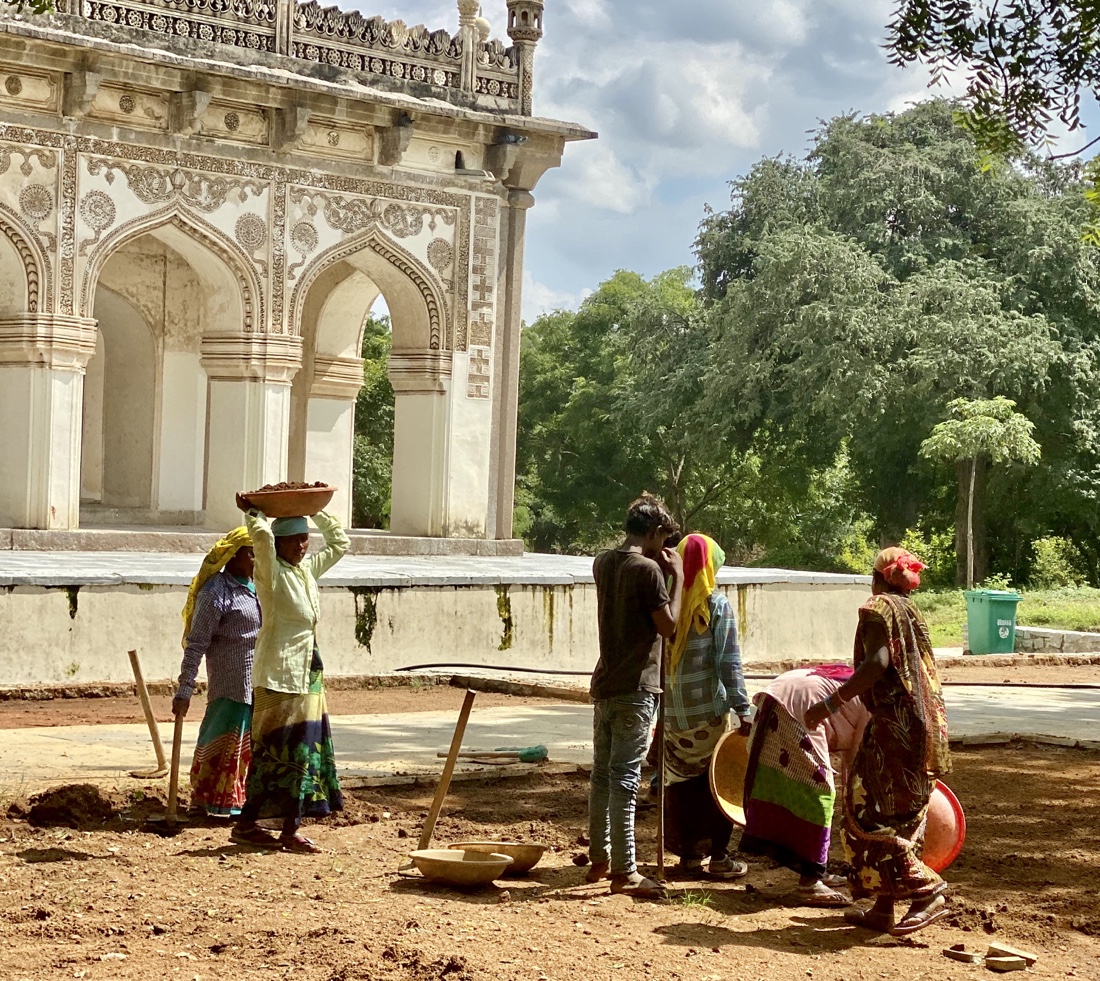 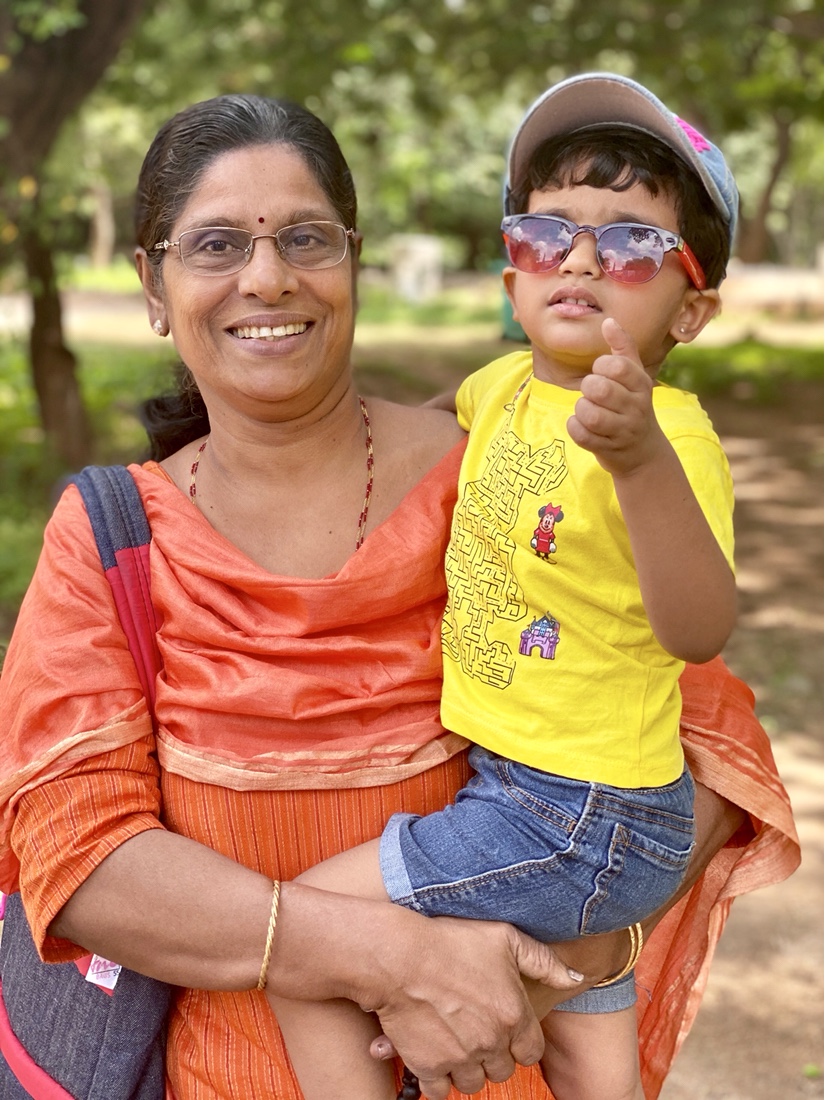
Lunch is at Simply South, a highly-regarded South Indian restaurant. Jonty knows the owners and chef and, since she is an expert on food, we entrust all ordering to her. We are rewarded with a very diverse and delicious meal, much more fun than I’d anticipated. 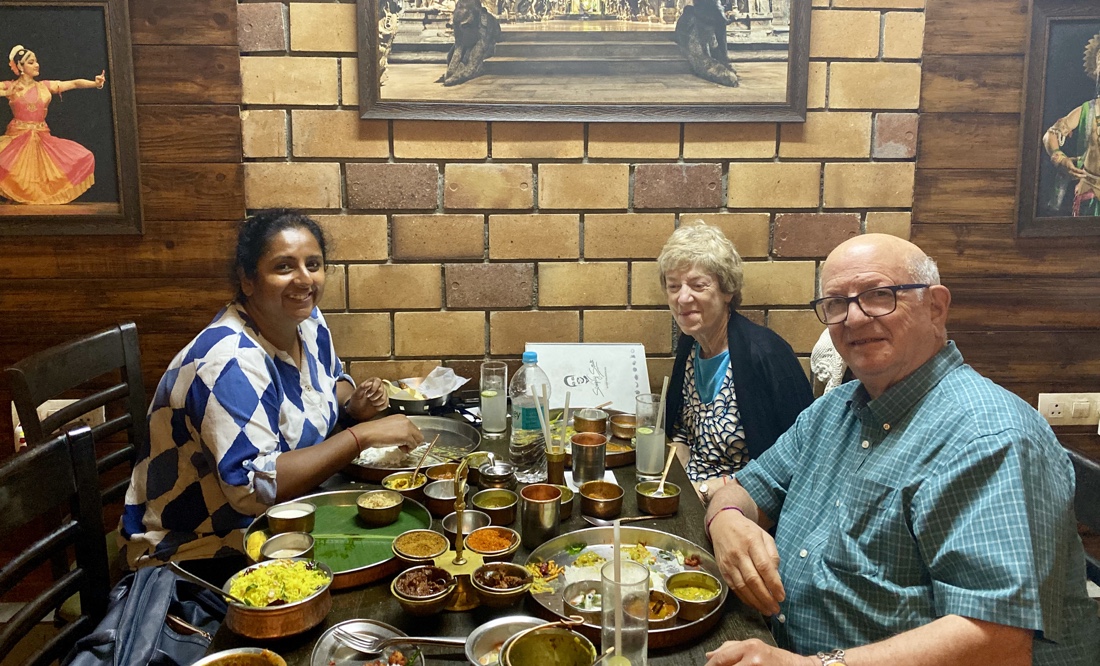 The restaurant is crowded with many of the patrons dressed up finely in anticipation of the Diwali holiday. The restaurant is crowded with many of the patrons dressed up finely in anticipation of the Diwali holiday.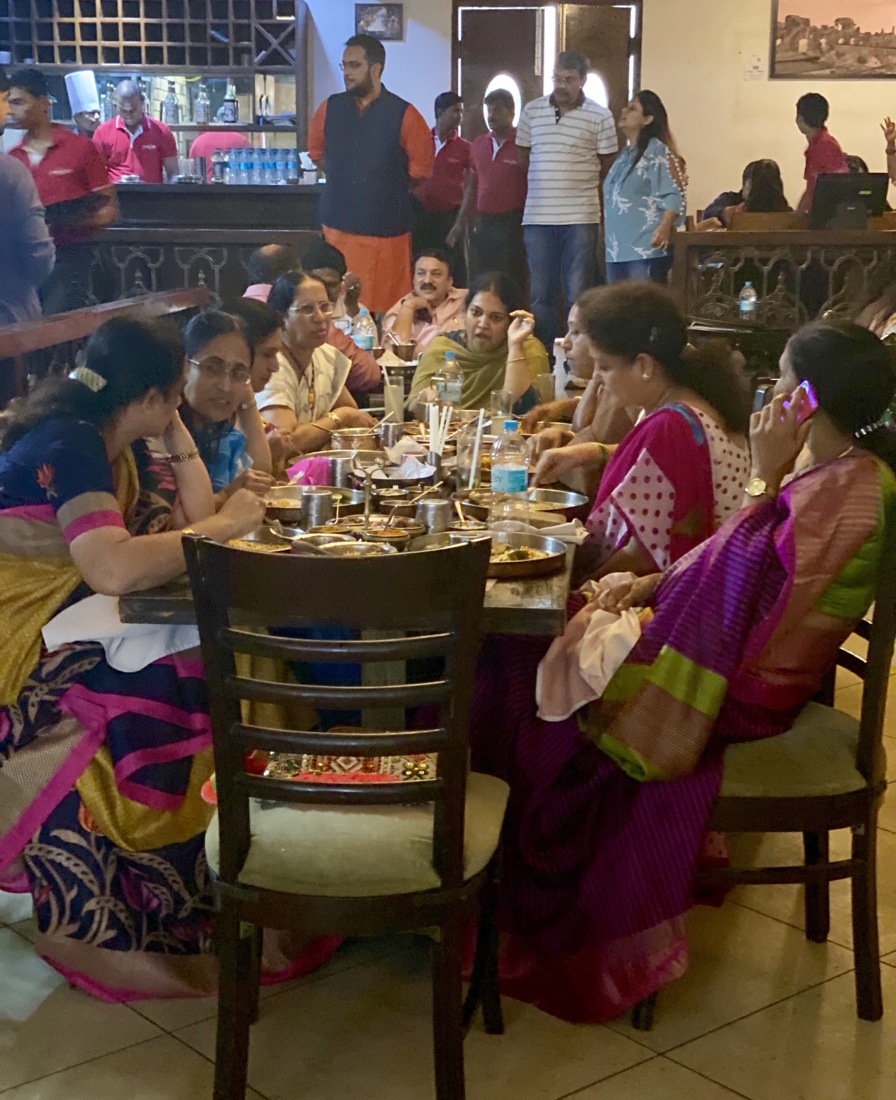
We then head to the Begum Bazaar market area, with hoards of people shopping for Diwali decorations, mostly very gaudy stuff. 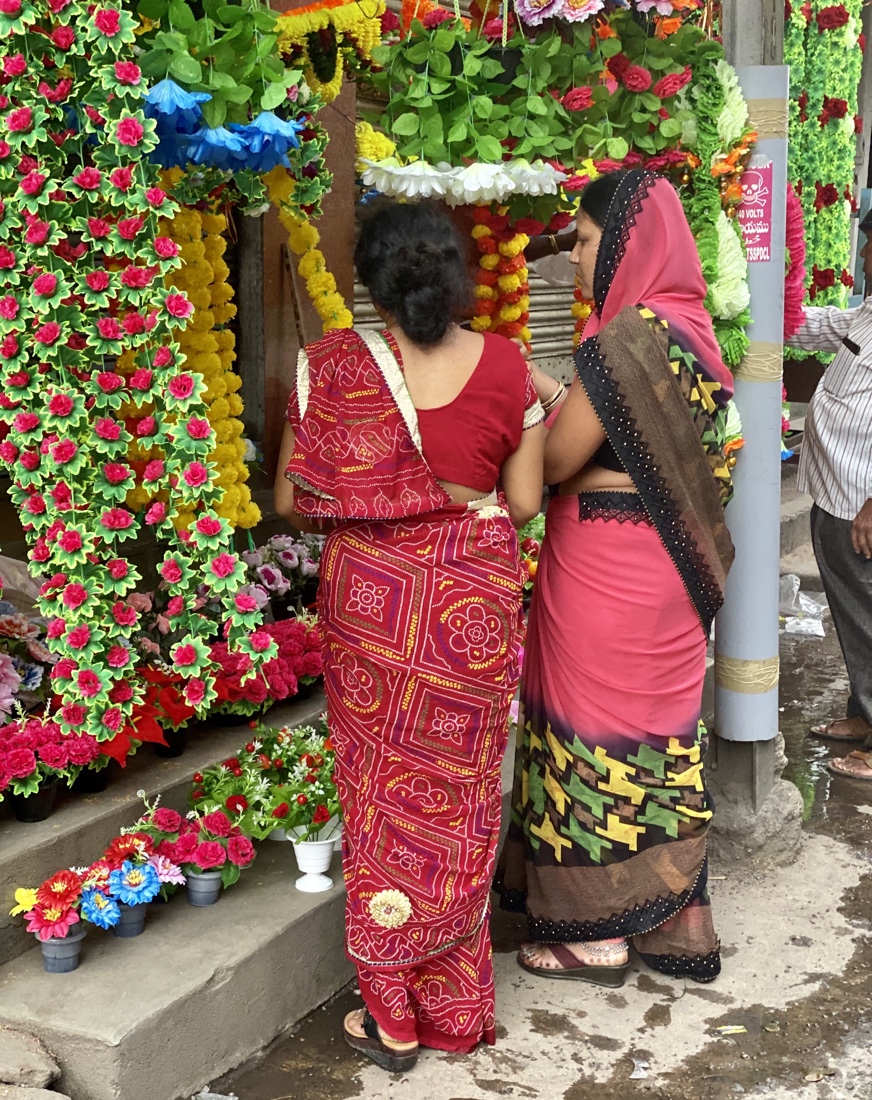 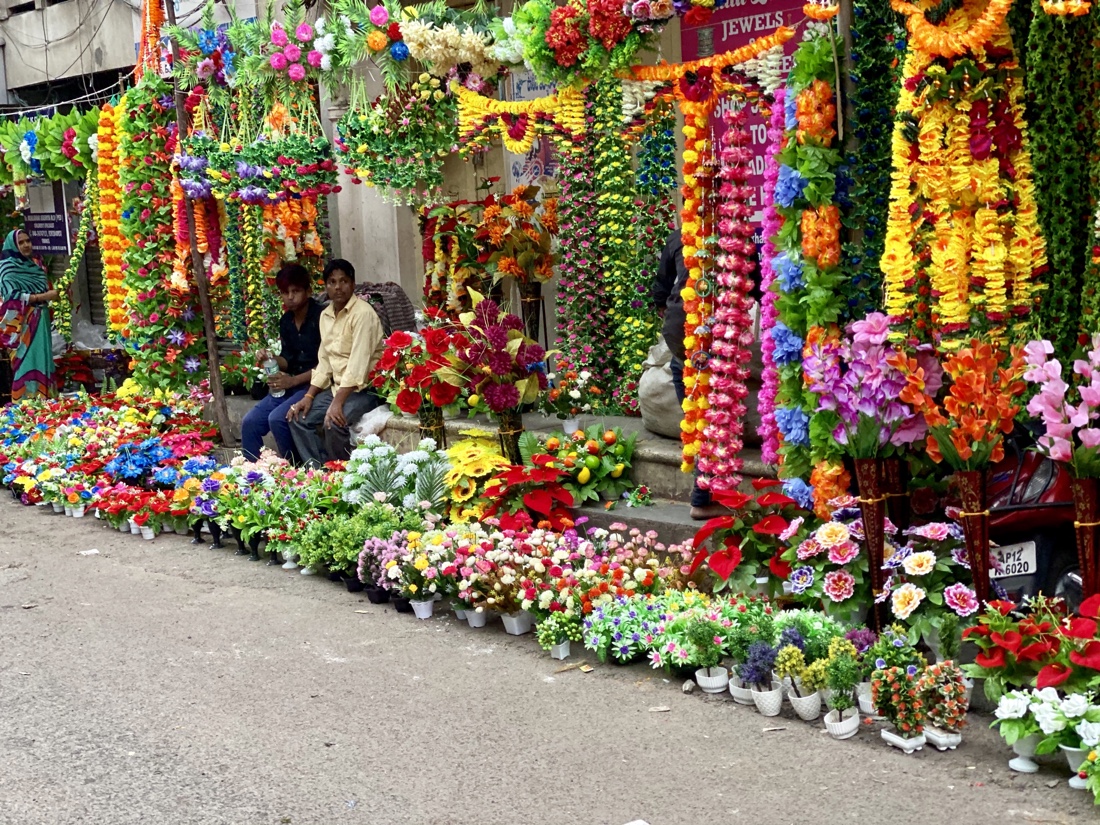 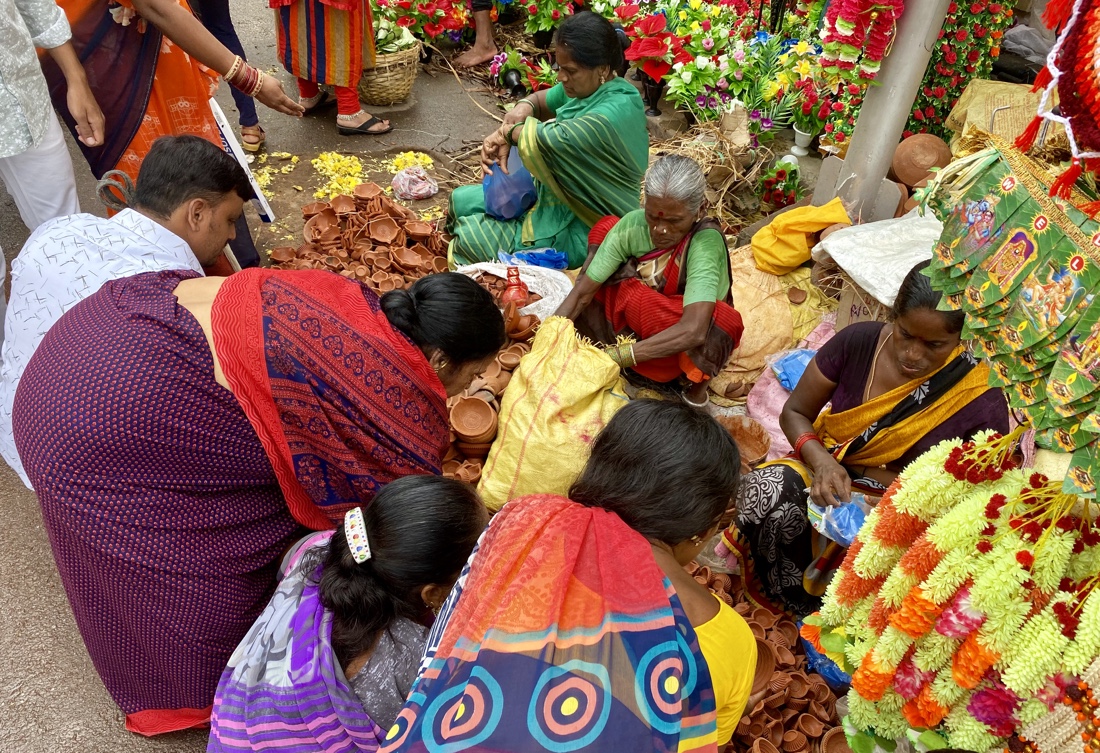 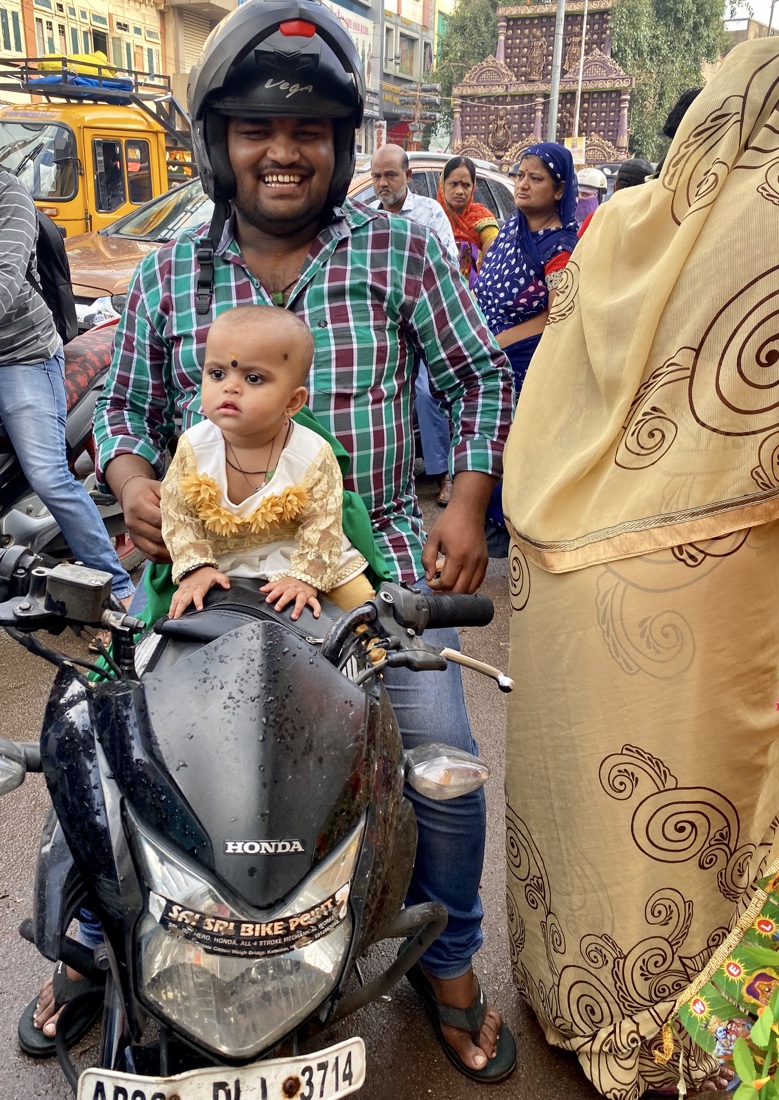 It begins to drizzle, we take temporary shelter, then tread precariously through very narrow streets filled with motor bikes, tuk-tuks, cars and pedestrians, happy to escape in one piece. The narrow streets were generally too harrowing to photograph, except for the one with the cute baby on the motor bike above, but here’s a photo of a wide avenue to give you a hint. It begins to drizzle, we take temporary shelter, then tread precariously through very narrow streets filled with motor bikes, tuk-tuks, cars and pedestrians, happy to escape in one piece. The narrow streets were generally too harrowing to photograph, except for the one with the cute baby on the motor bike above, but here’s a photo of a wide avenue to give you a hint.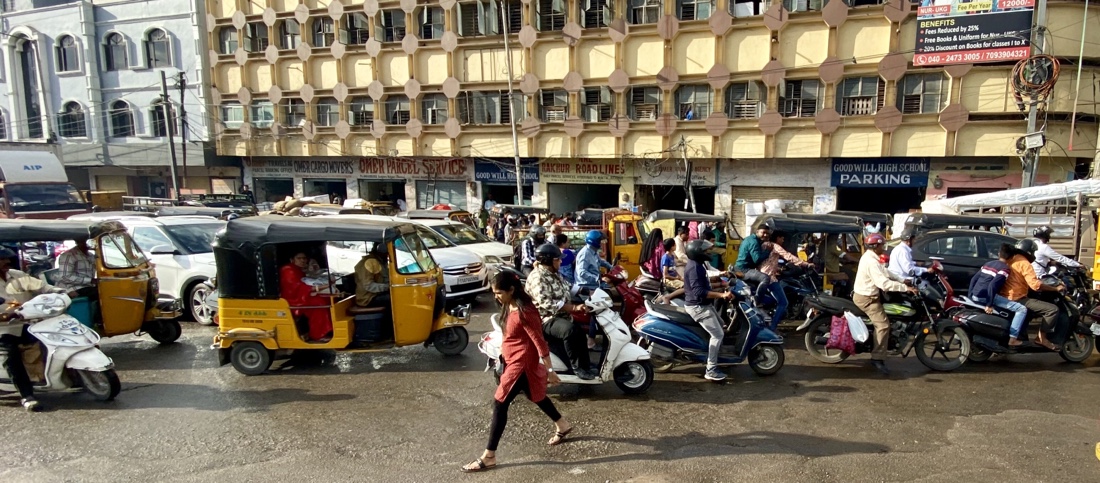
We make it back to our hotel in time to catch the daily tour by the historian of the hotel, a tall, basically undecipherable fellow with a rather pompous manner. I last about seven minutes of the hour tour before slipping down a staircase and heading back to the room. Carol lasts considerably longer, but does not finish the tour.
Back at the room, we rest up and decide to give the Italian restaurant another try. Again, a very good dinner, this time without the annoying music. By the way, before going out this morning, I ran into the guy who had greeted us when our carriage pulled up to the palace last night. When I told him about our music/noise experience of last night, he’d already heard about it from the staff, a sign of a very good hotel.
Today was a very good day, due in large part to Jonty, clearly our new #1 guide of this trip. She has a very easy manner, a good sense of humor, the ability to express things clearly and her English is completely understandable. What more could anyone want?
October 24
We bid goodbye to our humble villa, seen here from the outside.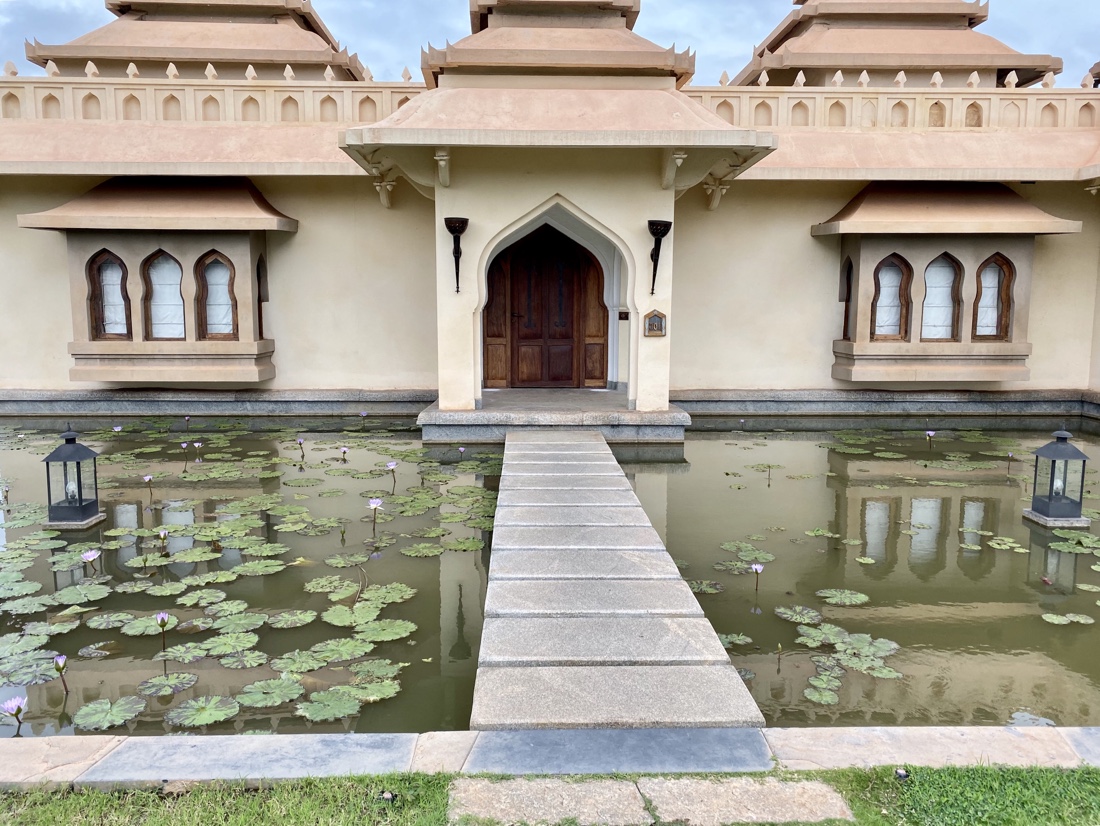 I’d written that it was the size of our condo, but I checked at the front desk, and, in fact, our condo is larger, but only by a little bit. I’d written that it was the size of our condo, but I checked at the front desk, and, in fact, our condo is larger, but only by a little bit.
Today is another full day of travel. These days are unavoidable when you’re trying to cover a lot of territory. and they are not a total waste, as you get to see life unfold in the villages, women in colorful saris, walking to work in the fields, with baskets and lunch carried on their heads, share the road with cows, dogs, pigs, oxcarts, tuk-tuks, buses, trucks, motor bikes, and cars. Businesses and trash along the roadside. We pass areas with large pools of water from the heavy rains in recent weeks. Nomads live in makeshift tents by the roadside and herd their goats along the road.
Passing through towns, I’m reminded that, in India, driving is a sport—passing blind, narrowly missing cows and pedestrians and regarding the concept of the correct side of the road as a quaint notion that applies, if at all, to others.
Towards the end of our four-plus hour drive to Kubli I take some random photos out of boredom, and so that you’ll have something to look at. You’re welcome (as my grandson, Maxi, would add).
Here’s a hotel we decided not to book.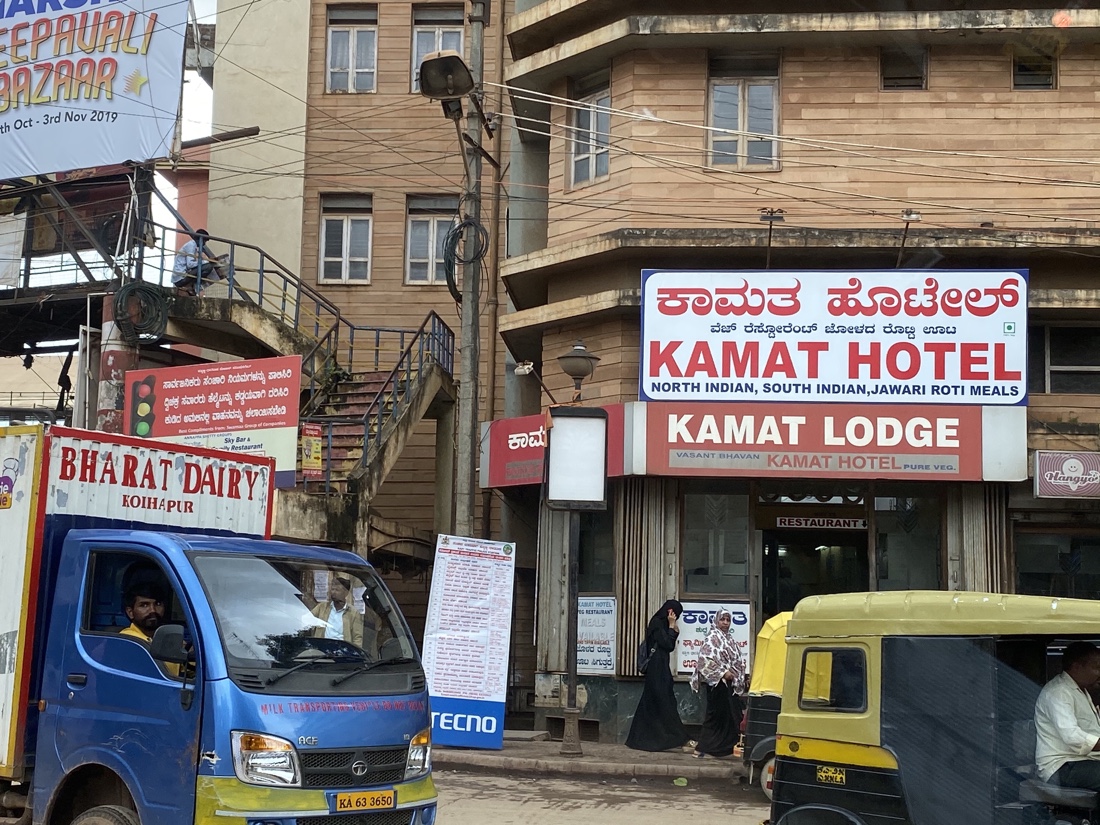
Residences by the side of the road.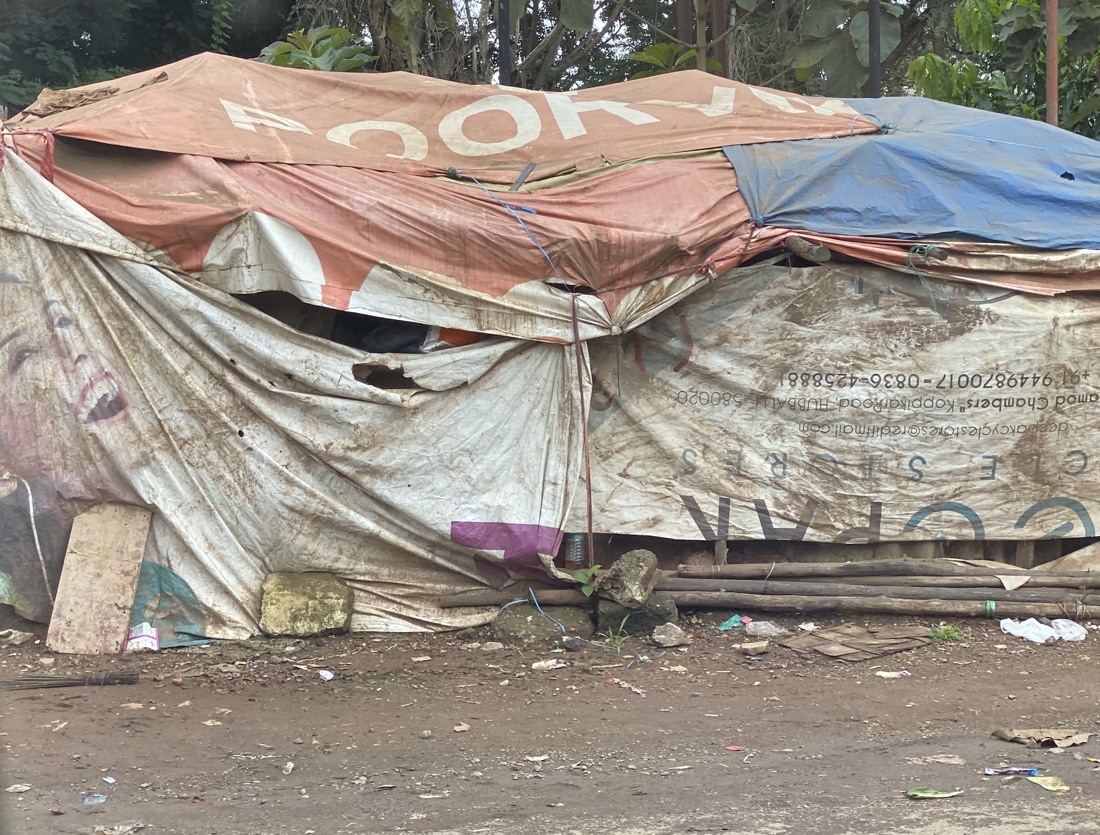 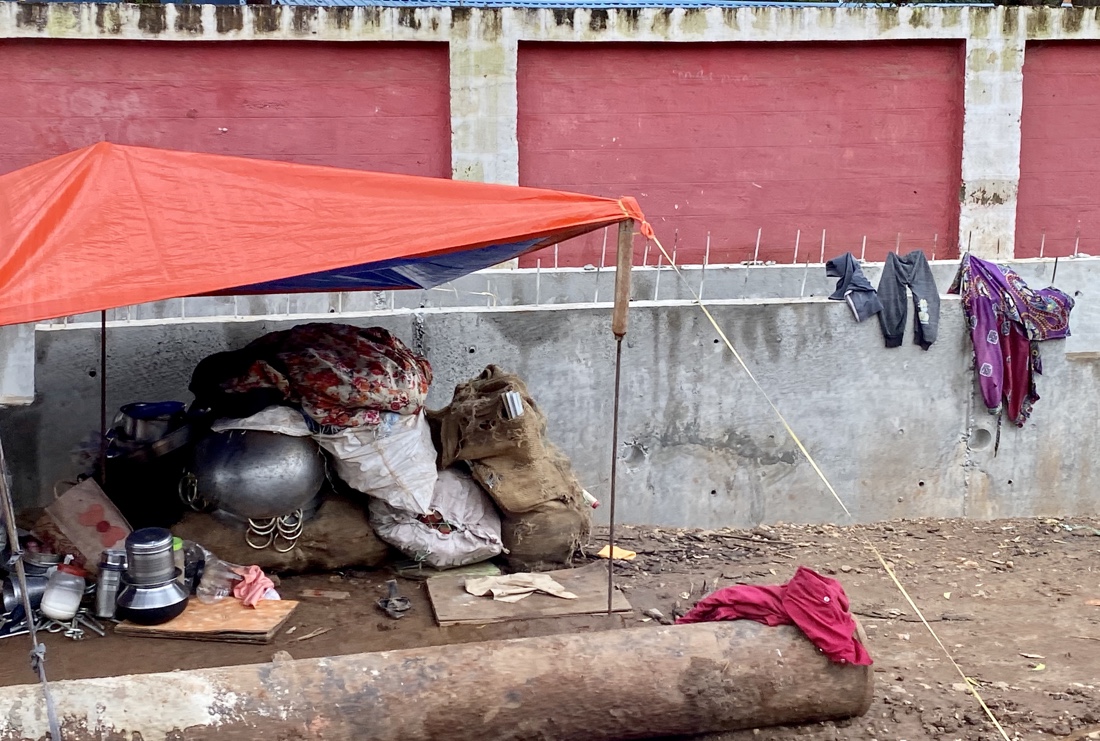
And a few assorted roadside scenes.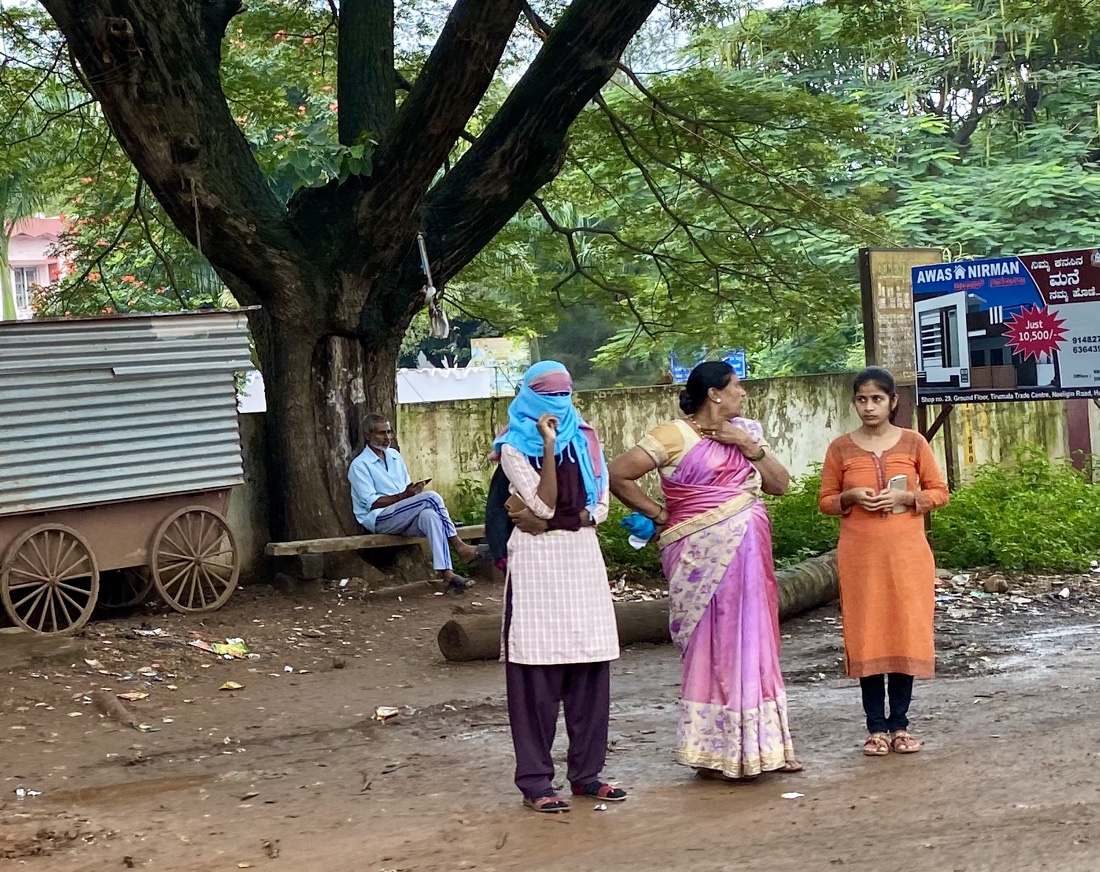 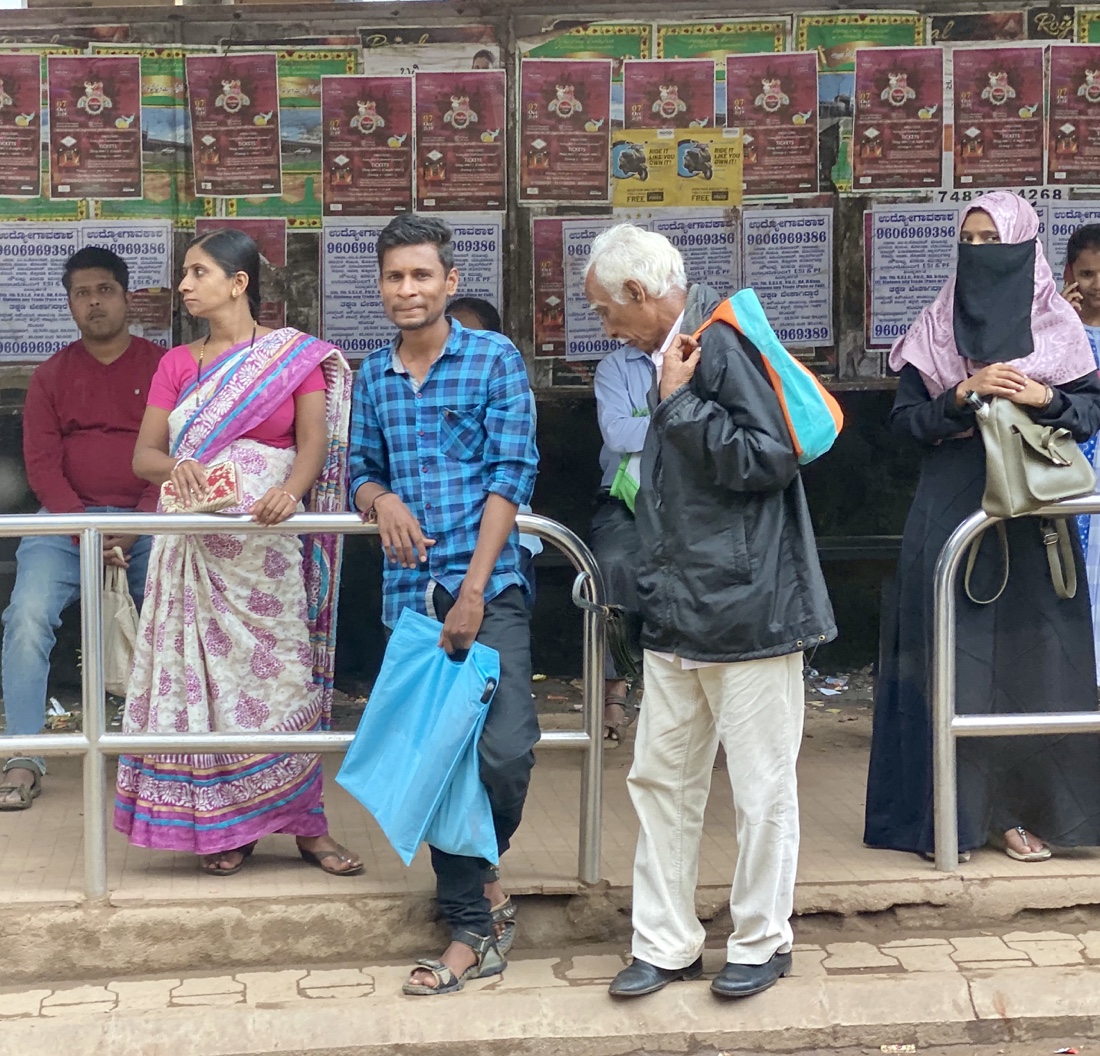 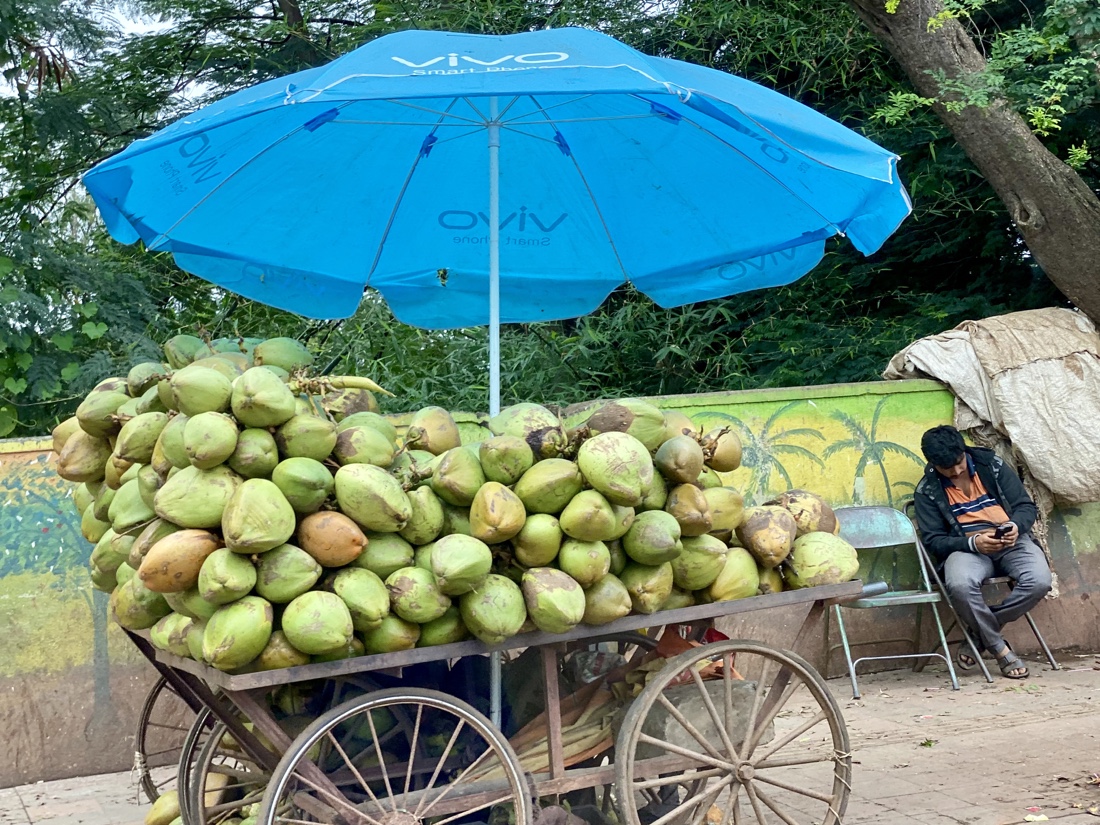 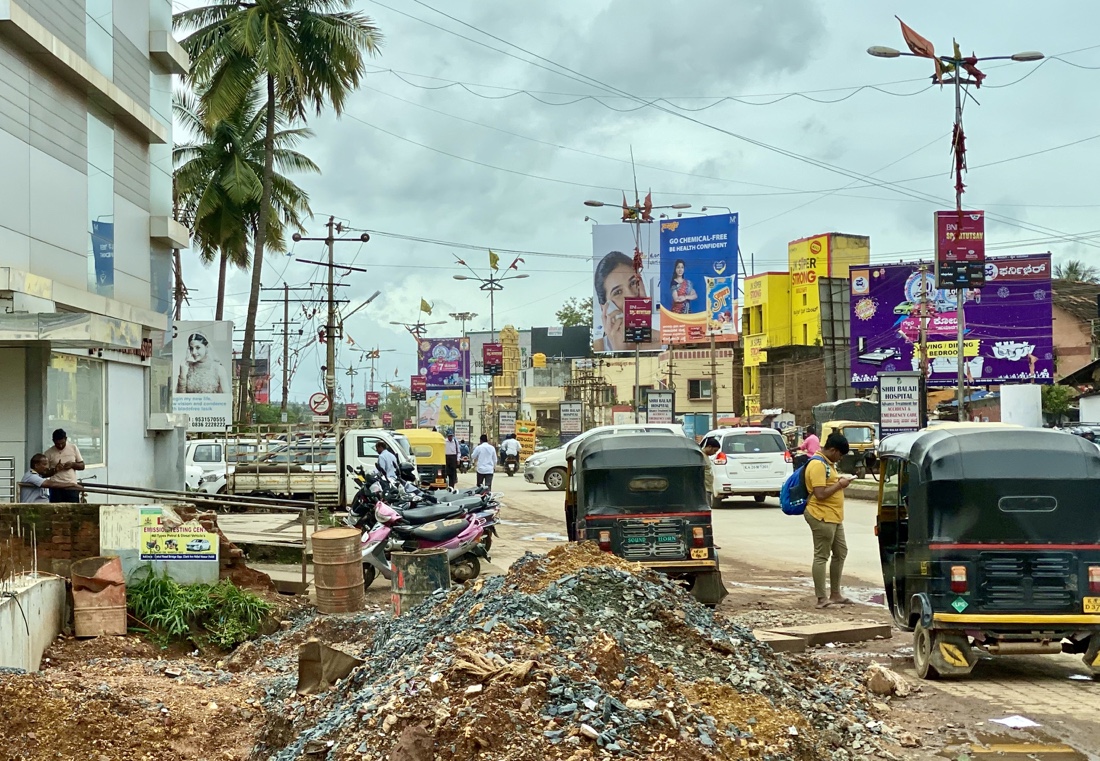
In the car we have ample time to discuss life with our guide, Ravi, including arranged marriages, attitudes toward homosexuality and the like. In sum, things remain pretty-much traditional in the towns, but have gone to hell in the cities. This is my summary, not his words, but I think it accurately reflects what we heard, and probably does not differ all that much from what you’d hear in many small towns in the U.S.
We have about an hour and a half at the Kubli airport. Looking around, I tell Carol that I feel as if we’re on Devon Street, with all the saris, and people eating samosas. I ask her whether she’d rather go to India or Devon Street. She’s still pondering her answer, but, for me, the answer is clear. Despite the difficulties in getting here and the travails of navigating through our itinerary, I really like India.
Our flight from Kubli to Chennai is an hour. There we transfer to our flight to Hyderabad, where we will spend the next few days.
The Chennai airport is new and modern. One sign of that is that there is a Krispy Kreme donut store, not only on the main gate level, but also at the lower level, on which our gate is located. 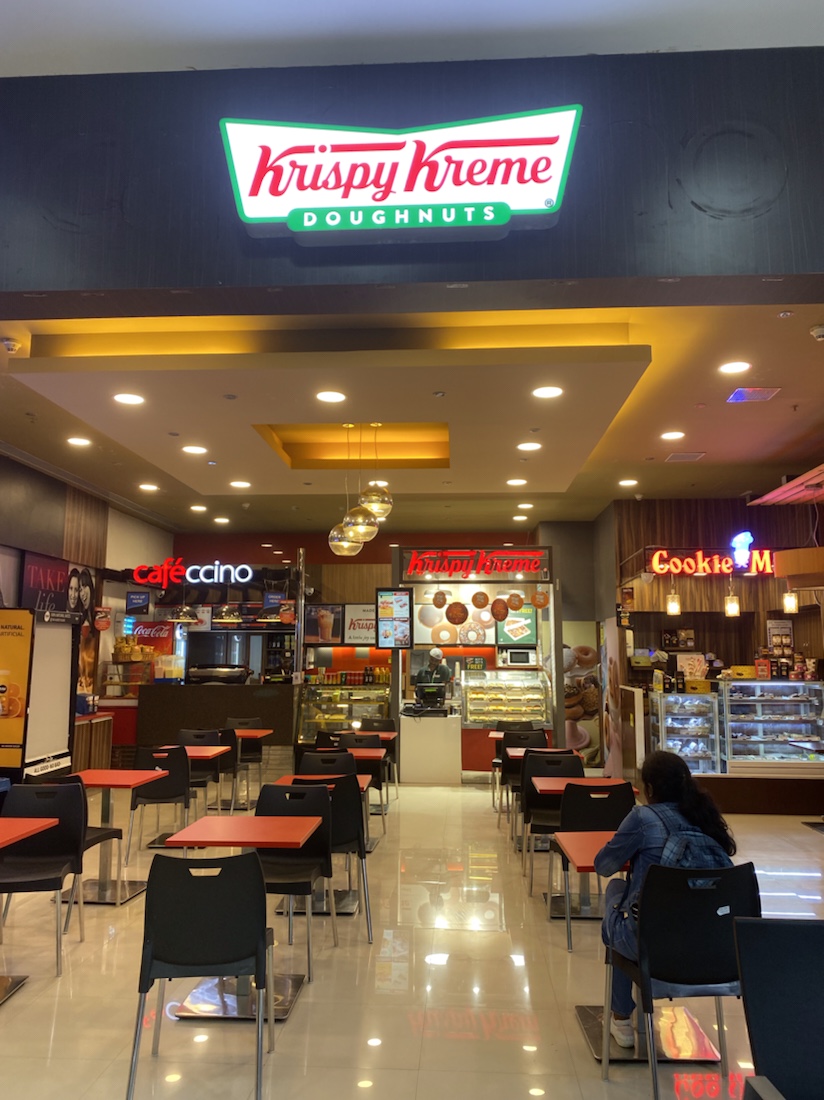 Another sign of that modernity is that it is a “silent airport” with no announcement of gates. Sounds like a great idea right, combatting noise pollution? Another sign of that modernity is that it is a “silent airport” with no announcement of gates. Sounds like a great idea right, combatting noise pollution?
The problem is that at the gate, there is no sign as to what flight is leaving from there. There are no gate attendants nor, as far as we can determine, any airport personnel of whom one can ask questions. So, one needs to find the flight listings, which rotate slowly, alternately in English and Hindi, by time of departure, periodically to confirm that one is at the correct gate. After our appointed boarding time, we learn, from the slowly rotating screen, that our flight has been delayed. Then, later, we learn that our gate has been changed from Gate 15, on the lower level, to Gate 5, on the upper level, so we head up there, passing the upstairs Krispy Kreme.
We find seats near Gate 5, and Carol takes off in an unsuccessful search for an airport official and to see whether the Krishna Jewelry store has any great sales (it does not). She returns with no new information, but says she’ll go check the slowly rotating sign. There she discovers that our gate has been changed from Gate 5 to Gate 12, back on the lower level, but not past either Krispy Kreme. Reaching Gate 12, we see a huge, sorta line, which we enter at what seems like it could be the end and eventually reach the front and board the crowded bus to our flight, now an hour and a half late.
In short, if anybody actually designed this system, it is the stupidest frigging system ever designed by man.
We’re met at the Hyderabad airport and driven to our hotel. Here, I have to remind you of the spectacular hotel villa we occupied at Hampi and tell you that compared to our new hotel, the Hampi hotel was a slum, sort of a Days Inn. Of course, I exaggerate, but…..
We are staying at the fabulous Hotel Falaknuma Palace. The “mirror of the sky” was the royal guest house of the Nizam of Hyderabad, considered for many years to be the richest man in the world. This sixty room palace once the sole preserve of royalty, among them King George V and the last Russian Tsar, Nicolas II now plays host to visitors from across the world. Architecturally the palace is a blend of Italian and Tudor architecture. It is home to priceless art and artifacts, ornate inlaid furniture from Kashmir, rich handcrafted tapestries and brocades from France, and intricate frescos with English and Indian influence.
Whereas we were driven to our room in a nifty Ambassador in Hampi, our mode of transportation here was different, as you can see in the two photos below, the second taken in front of “our” palace.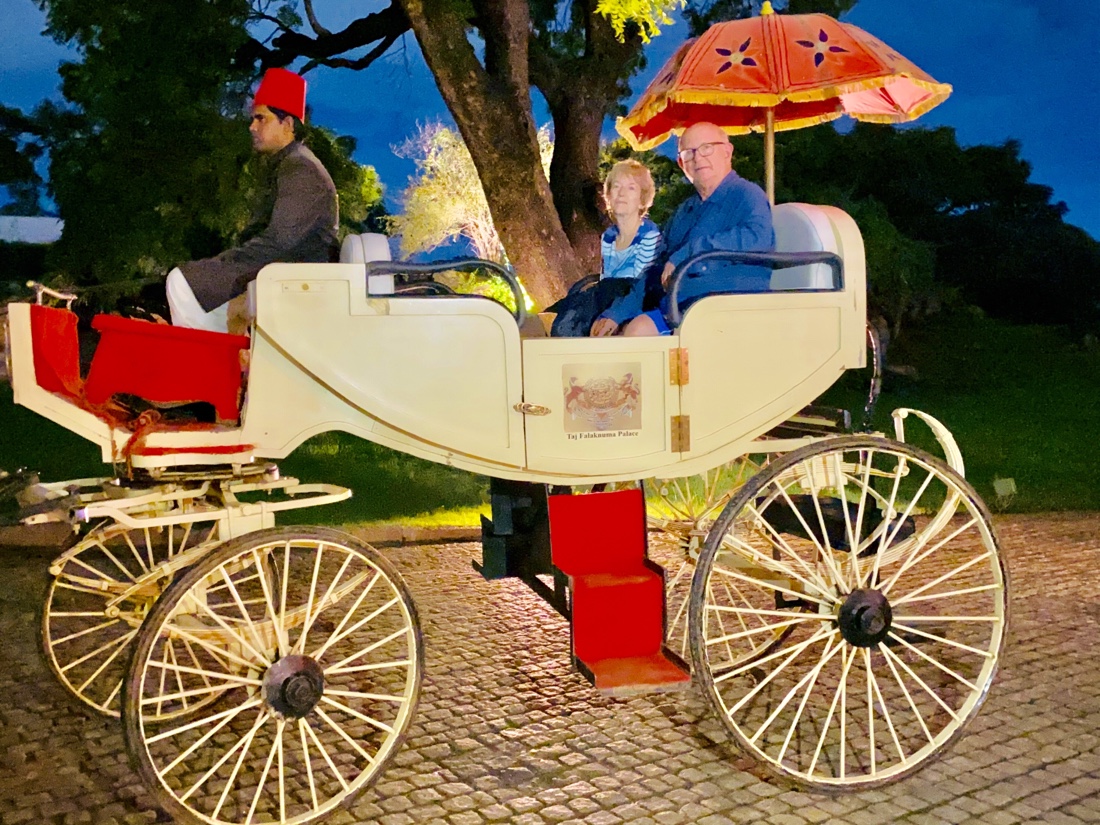 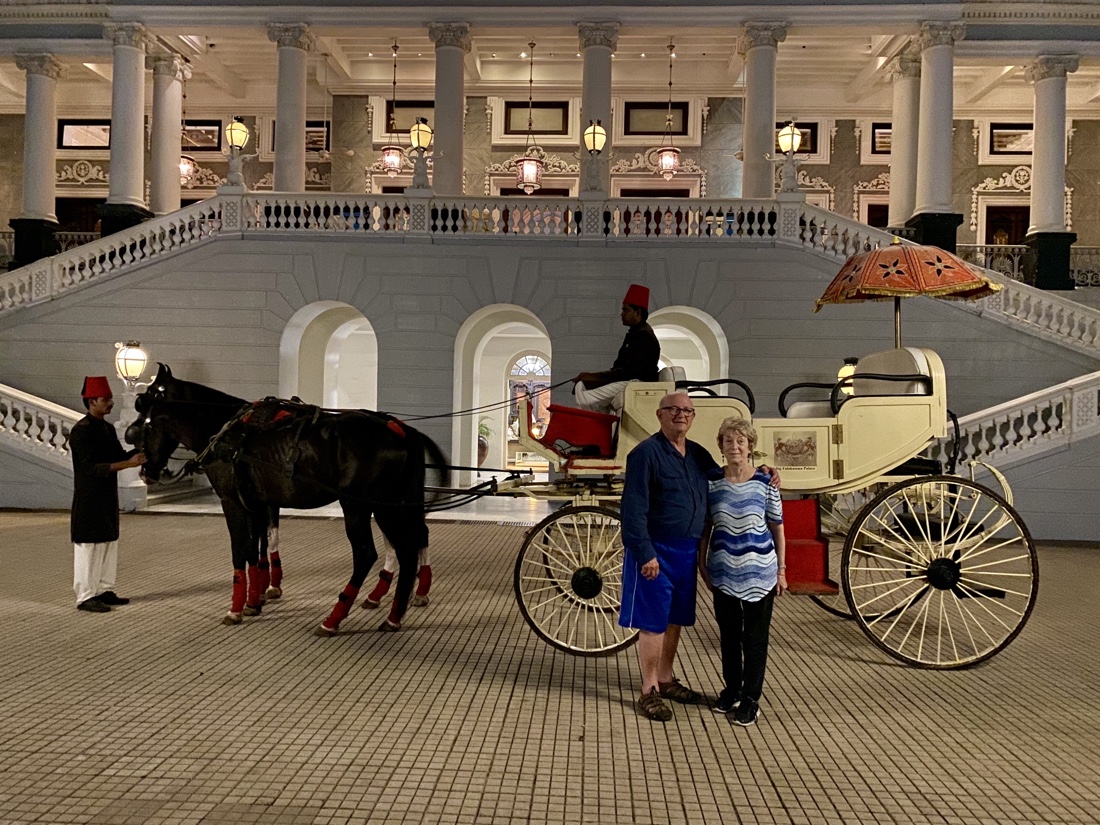
The photo below is looking out from in front of the palace.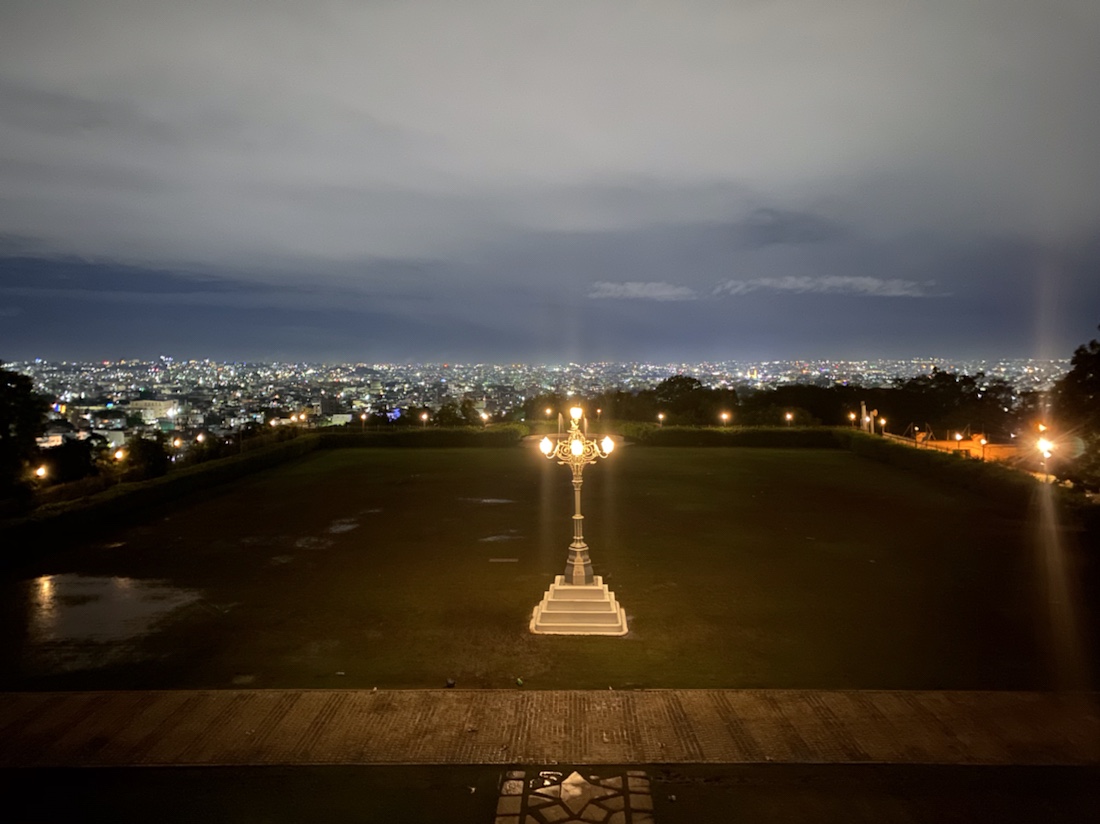
Here’s a photo of the courtyard off of which our suite is located, followed by several photos of our room.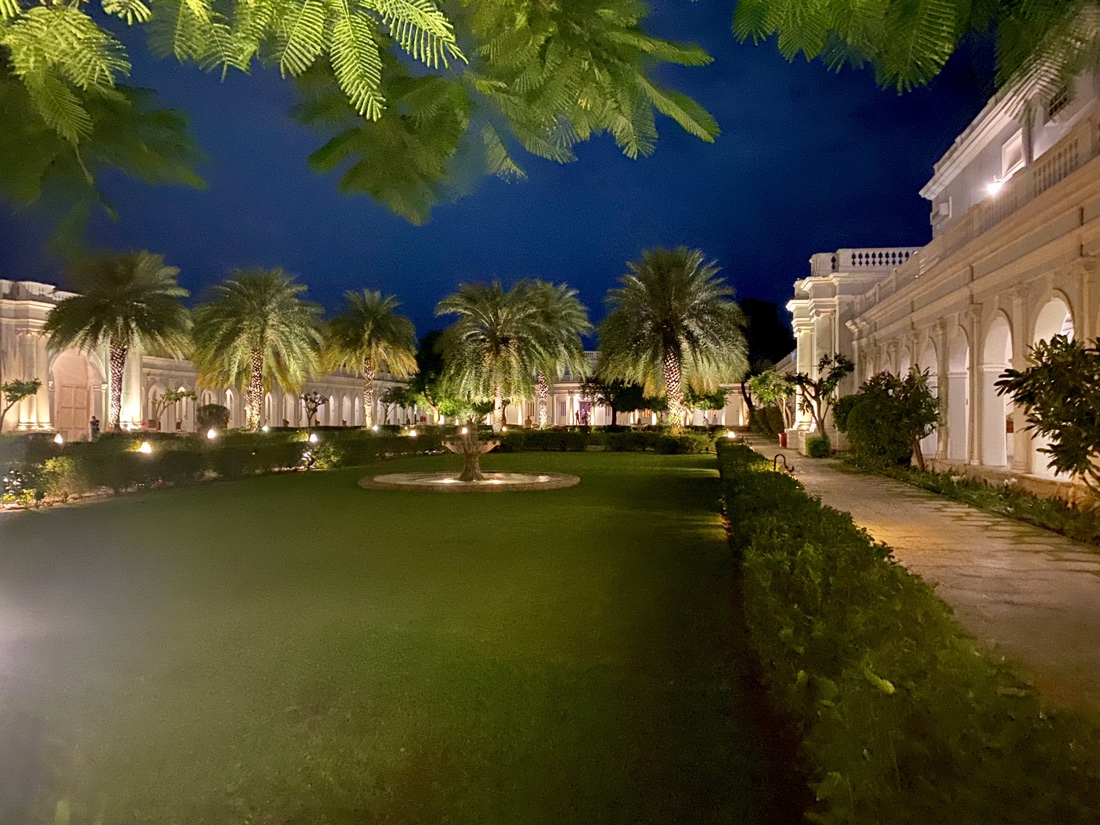 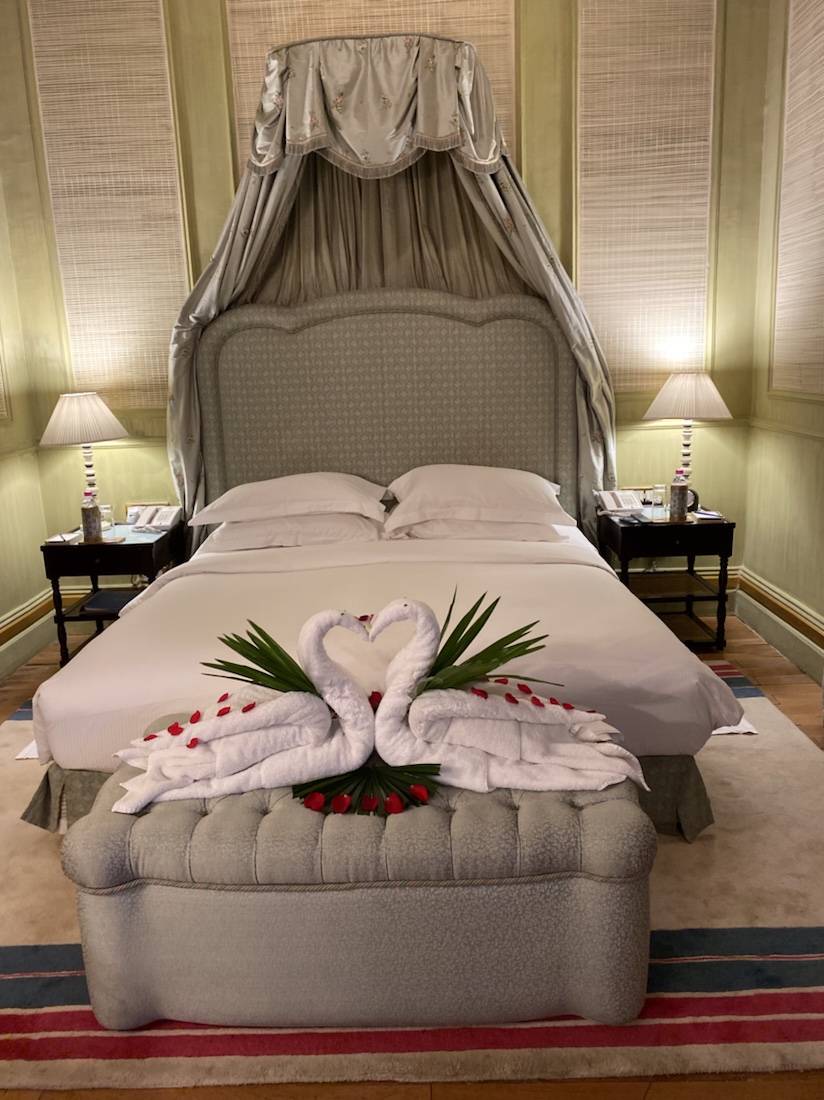 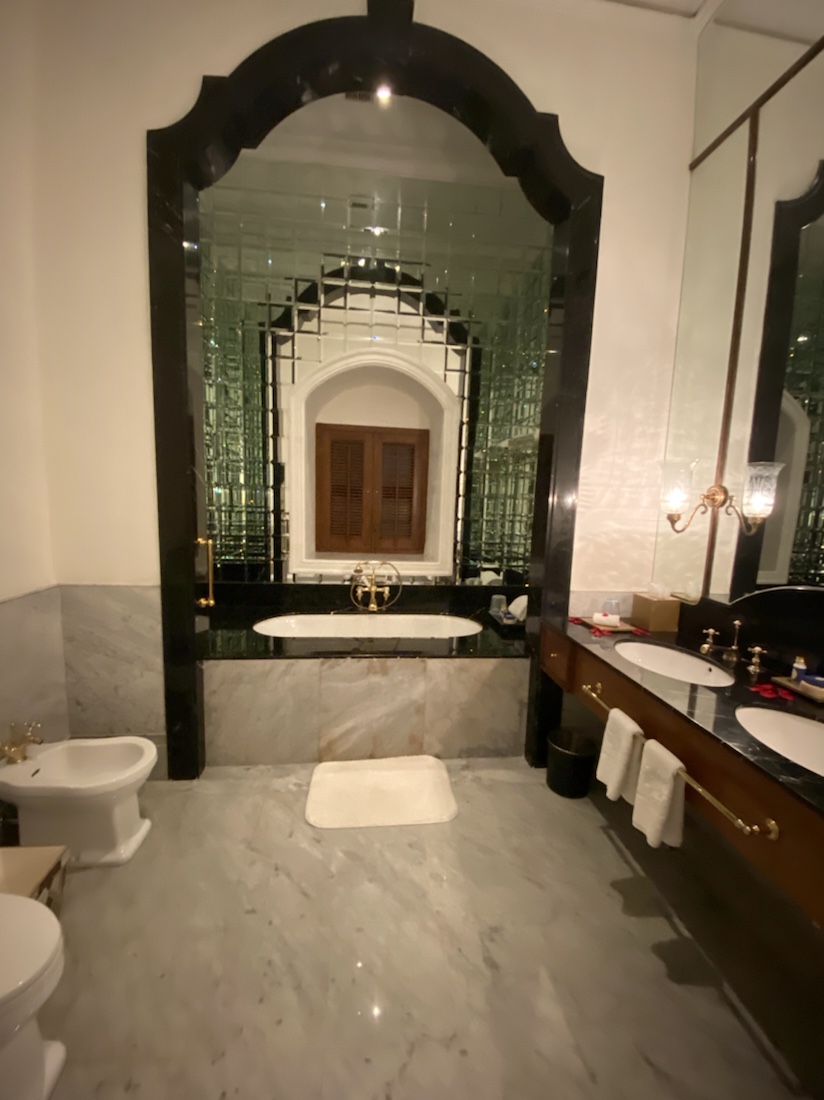 I’m sure there will be much more to say about our palace tomorrow, in the light of day. But I’ll close with evidence that “nothing’s perfect.” We decided to opt for dinner at the Italian, rather than the Indian, restaurant. As we approached the restaurant, I heard loud sounds of what appeared to be a woman in serious distress. These noises continued and could be heard, loudly, in the Italian restaurant. Upon inquiry, the sound was of a woman singing traditional South Indian music. I’m sure there will be much more to say about our palace tomorrow, in the light of day. But I’ll close with evidence that “nothing’s perfect.” We decided to opt for dinner at the Italian, rather than the Indian, restaurant. As we approached the restaurant, I heard loud sounds of what appeared to be a woman in serious distress. These noises continued and could be heard, loudly, in the Italian restaurant. Upon inquiry, the sound was of a woman singing traditional South Indian music.
Being the timid type, I had both our waiter and the maitre d’ over at our table. Both understood clearly and apologized, but said it was part of a program. I said that was fine for people who signed on for the program, but not fine to impose on others who might expect a quiet dinner. To make a long story short, they shortened the program to last only another ten or fifteen minutes and, on our way out, the restaurant manager said that he would schedule music on other nights so as not to occur while we were dining.
Dinner, by the way, was terrific.
We retired right afterwards, exhausted from our twelve hours of travel, but happy to be tucked in at our little palace suite.
October 23
We spend today exploring Hampi starting at the ruins of what was the urban core and including the remains of the royal palaces and temples. A UNESCO World Heritage Site, the fabled city of Hampi sprawls across a spectacular barren boulder strewn landscape. This city served as the capital for three generations of Hindu rulers for more than 200 years, and reached its zenith between 1510 AD and 1542 AD.
Our guide is Viru Pakshi, an art graduate of Gulbarga university, who has been guiding since 1991 and one of the best guide in Hampi region. He has had an opportunity to work with Mr. John Fritz and George Michell an anthropologist and archaeologist respectively, which has given him vast knowledge of history and architecture of Hampi.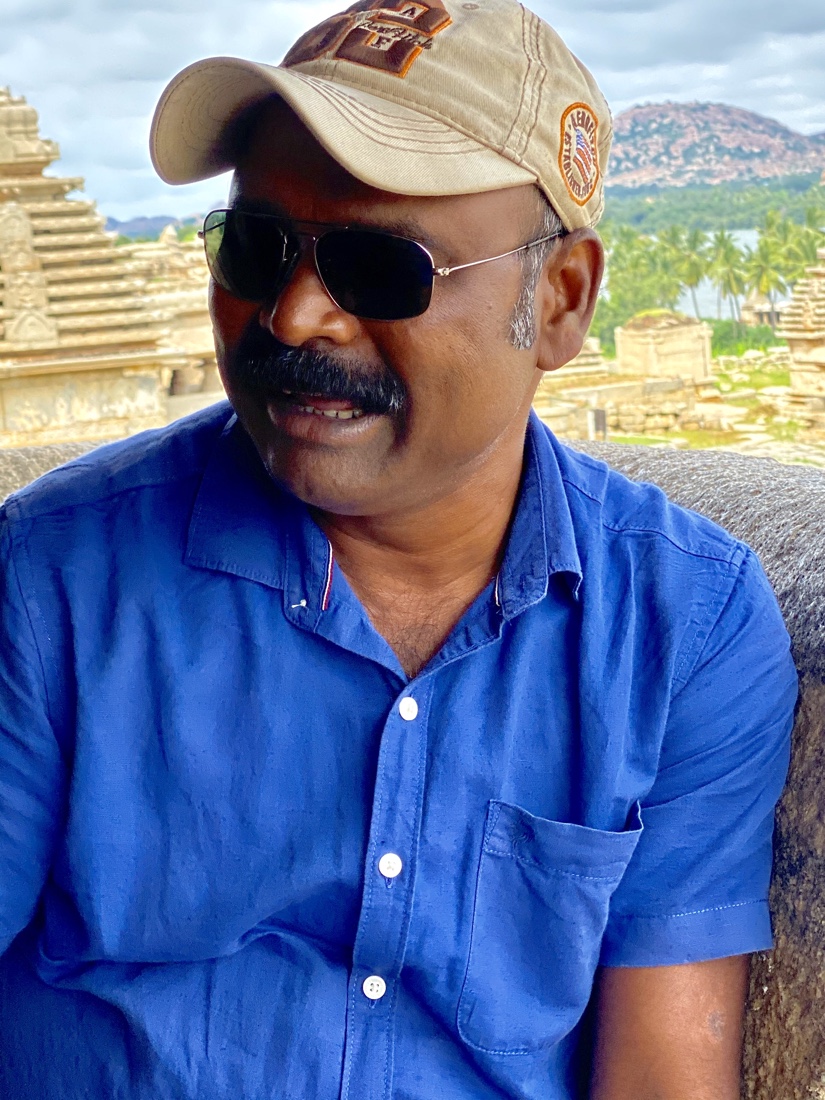
When we met him, I told him that we needed Hampi for Dummies, not a sophisticated and detailed account. We could understand him fine and generally he did okay (Carol gives him lower marks than I do). We’d both agree, though, that of the four guides we’ve had so far, he’s #4.
This is an absolutely extraordinary site, encompassing 56 square kilometers, or almost 40 square miles. The monuments are in remarkable condition and the restoration that’s been done is first class and does not detract from the original. I’d put this in a category comparable to Angkor Watt, Bagan, and Egypt. Carol probably would not rank it that high, but even if she’s right, being a notch below those spots is pretty amazing. So, if it’s not there already, put Hampi on your bucket list.
We had excellent weather, though the sun got quite hot at times. I used my walking sticks which were quite useful, but I think carry the danger of becoming more reliant on them than one need be. Some of the most dangerous walking is on flat land, where you don’t notice a stone of a different height and trip over it. While walking sticks would be useful in that situation, chances are I wouldn’t be using them then. So, I’d say this is still a work in progress, but probably a good idea.
We returned to the hotel for lunch, then had a couple hours during which I swam n our private villa pool.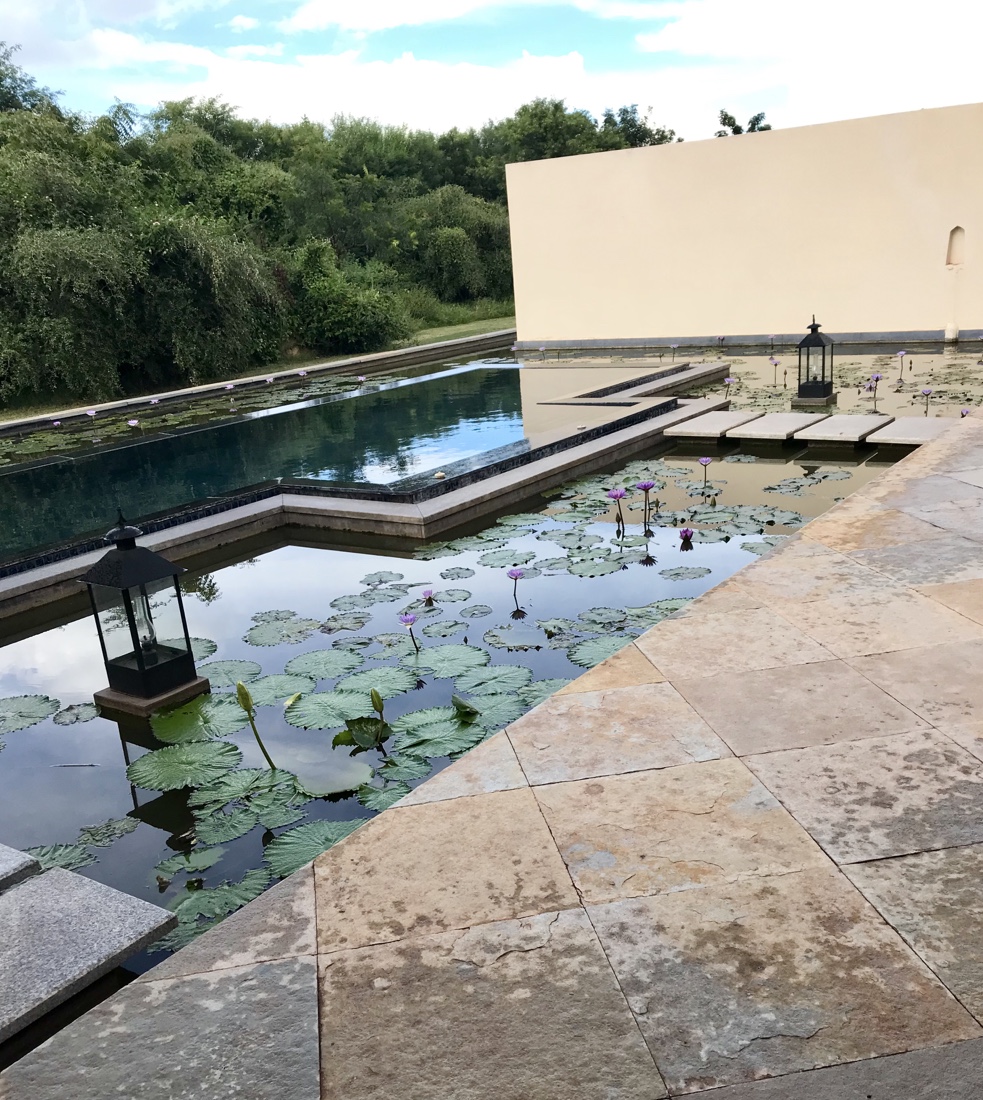 Tough work, but somebody’s gotta do it. Tough work, but somebody’s gotta do it.
The afternoon was mixed, because it rained for about the second half of it. While that adds to the adventure, it does not add to the comfort. We did have an umbrella, though, and the rain was not too hard, so we survived it.
Best I can do is just include a lot of photos, of the site and environs. I won’t try to identify them for you, but they’ll give you some idea of the overall impression.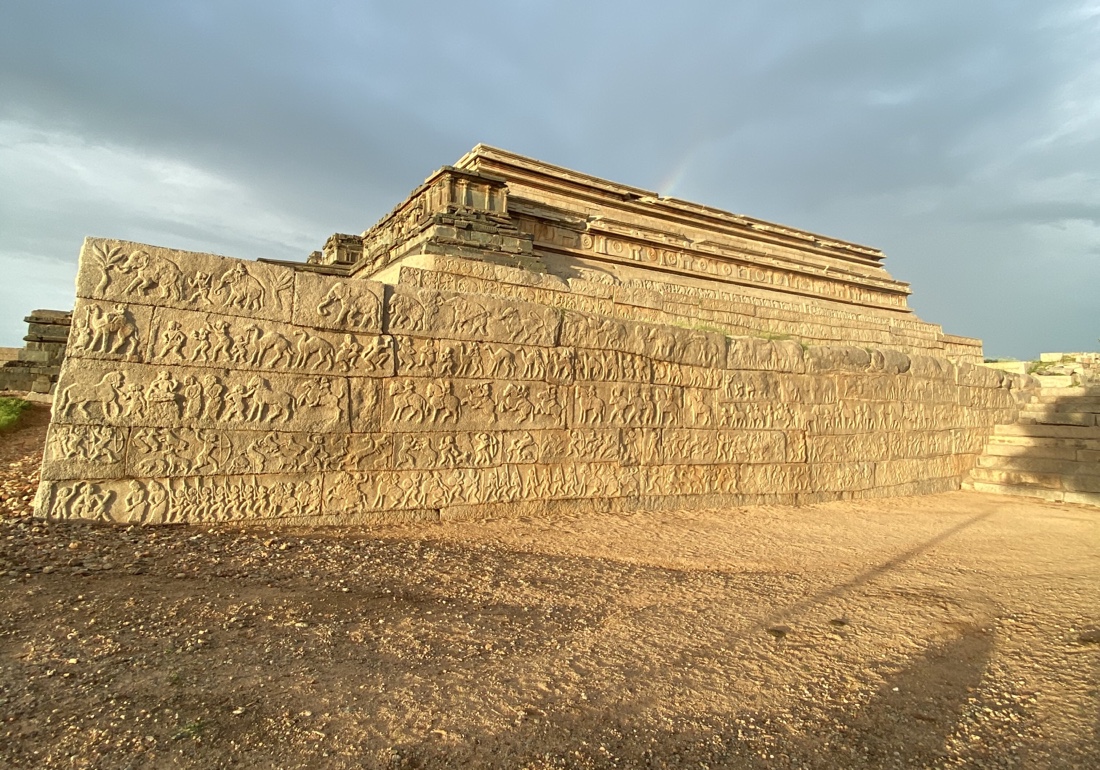 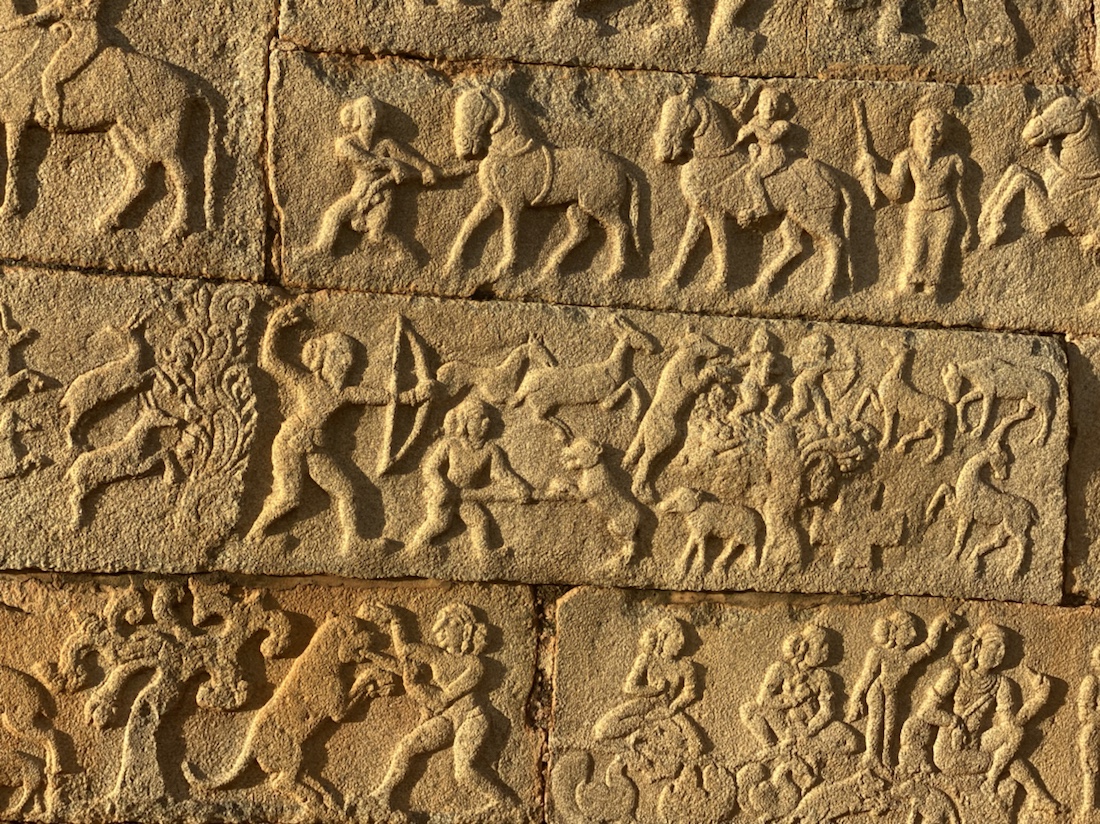 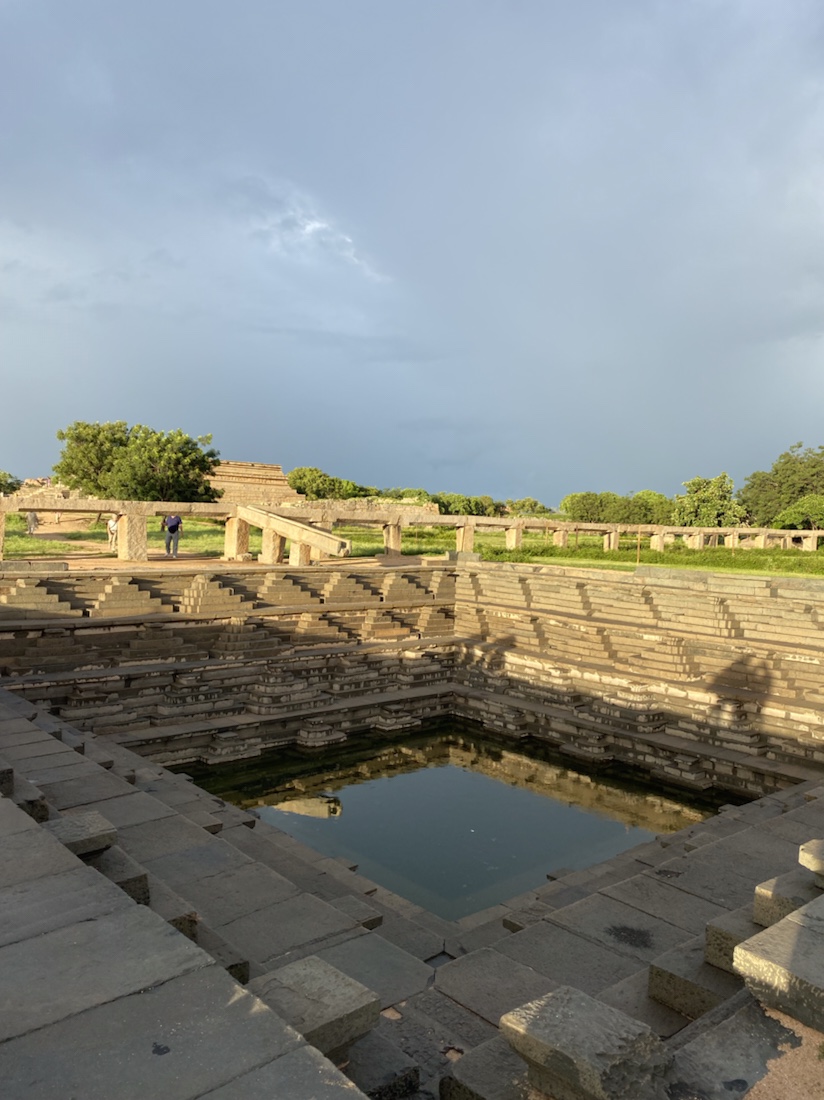 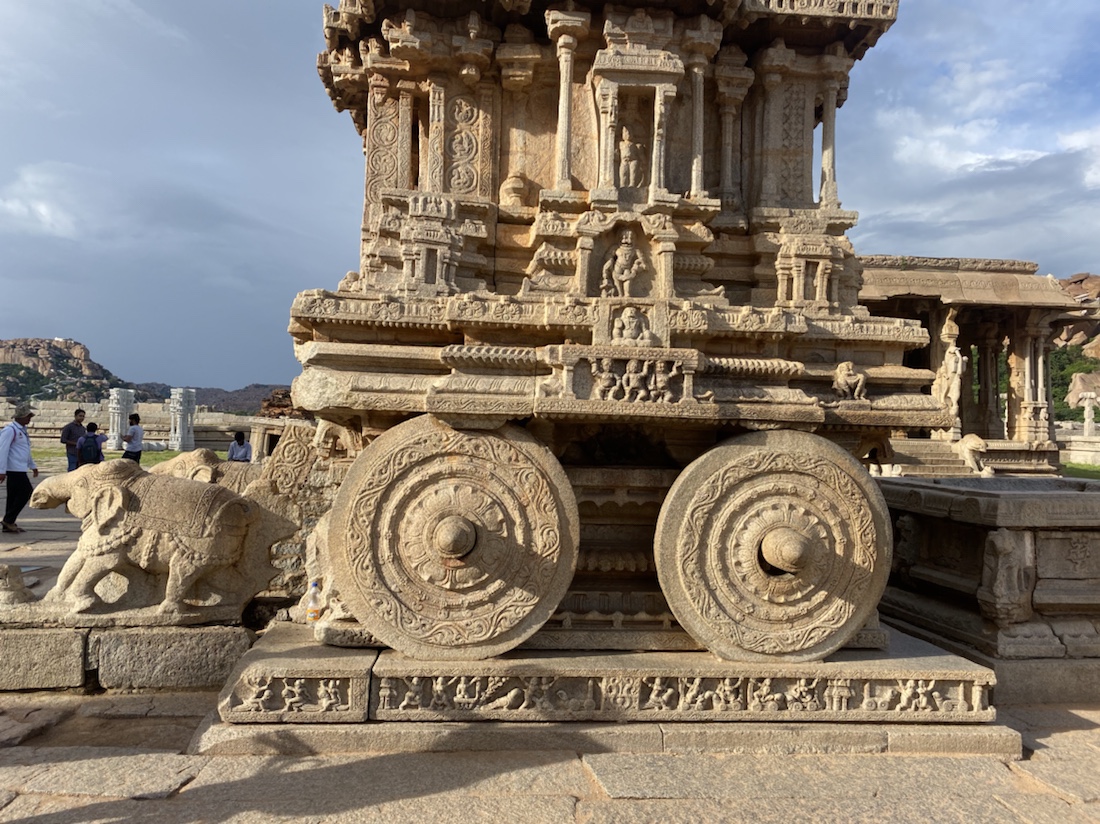 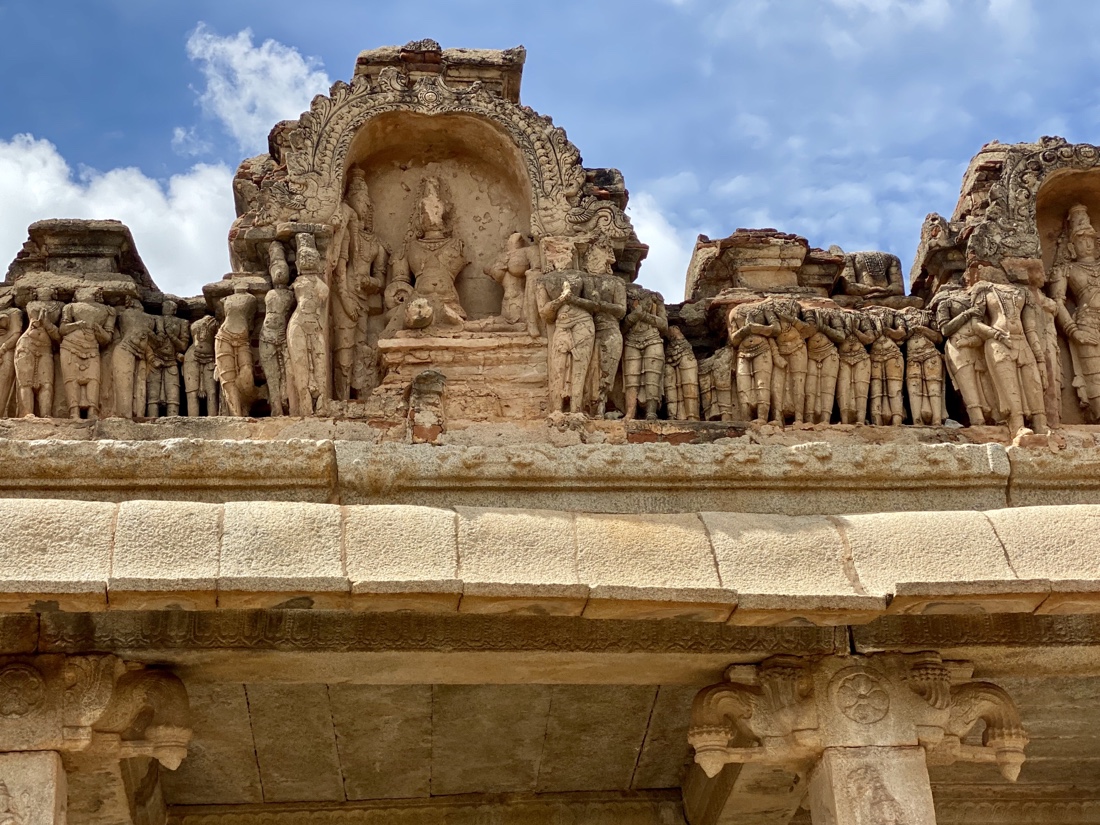 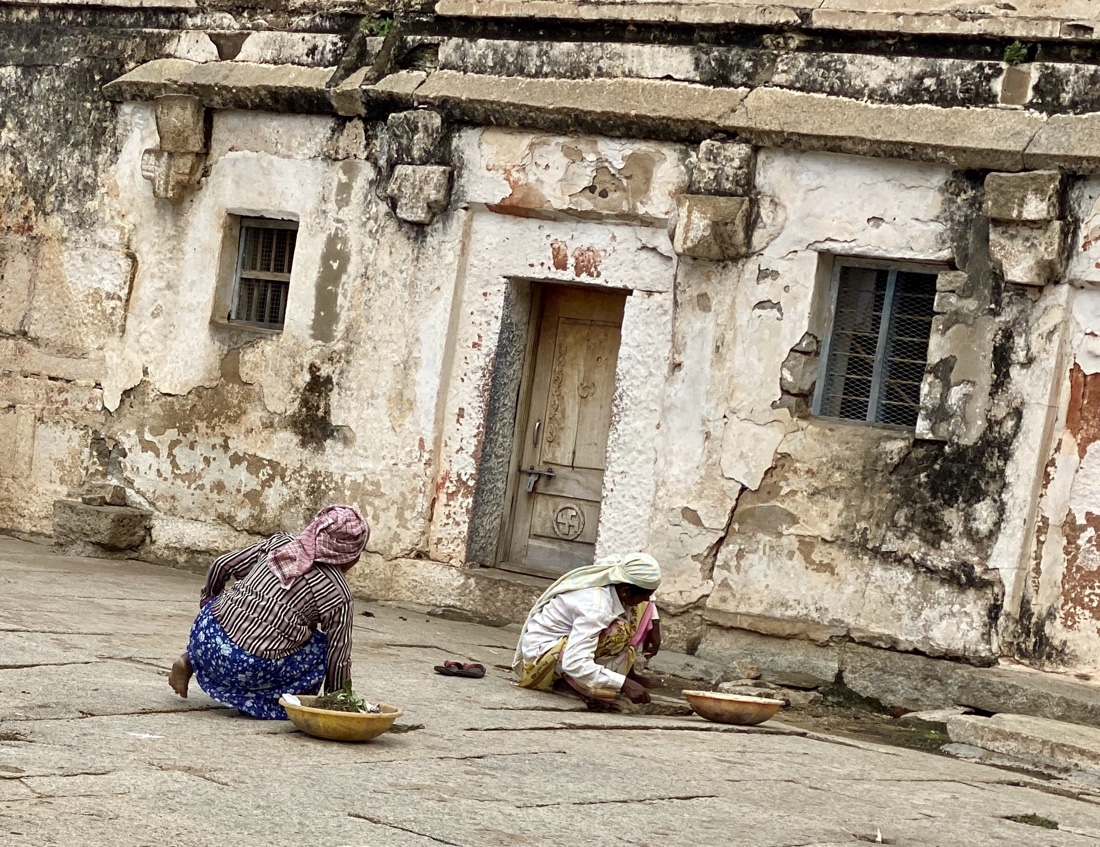 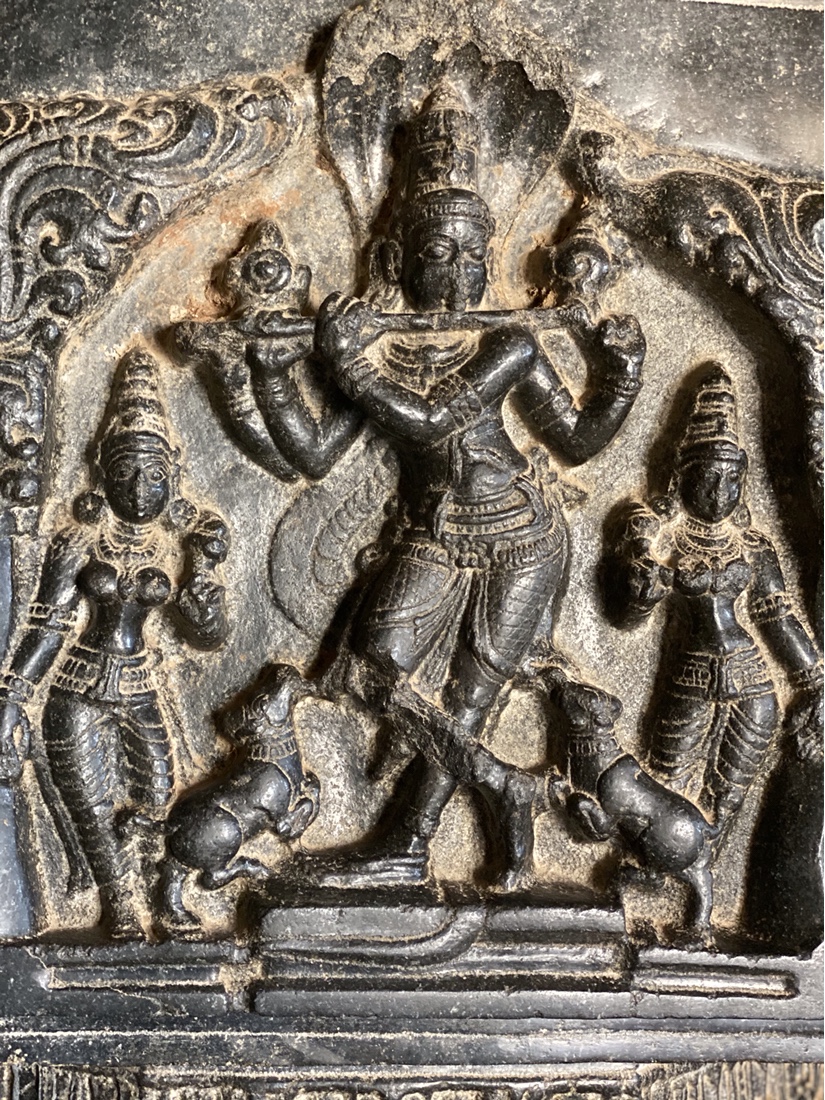 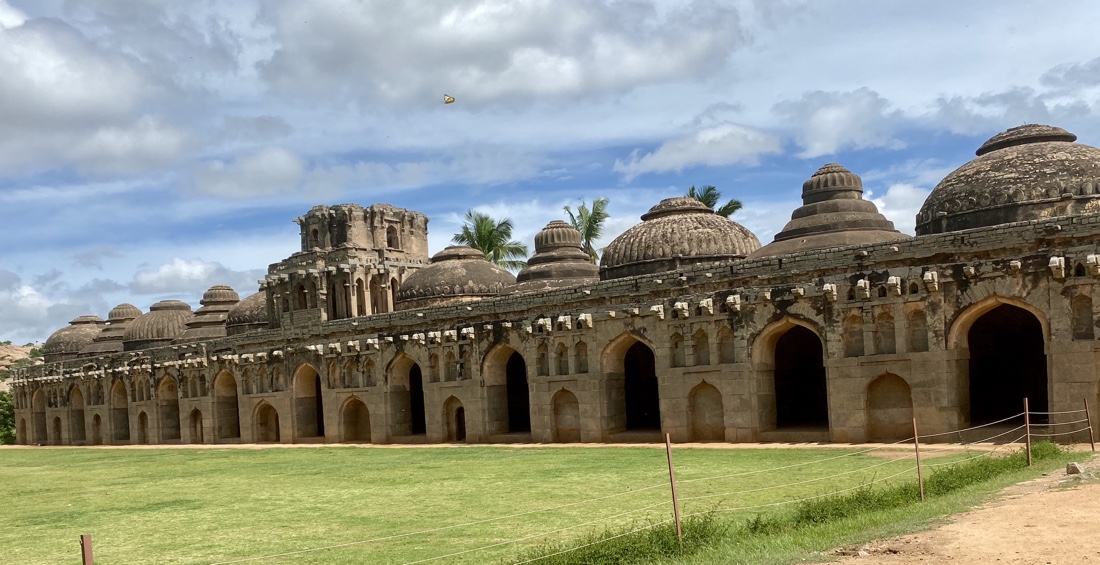 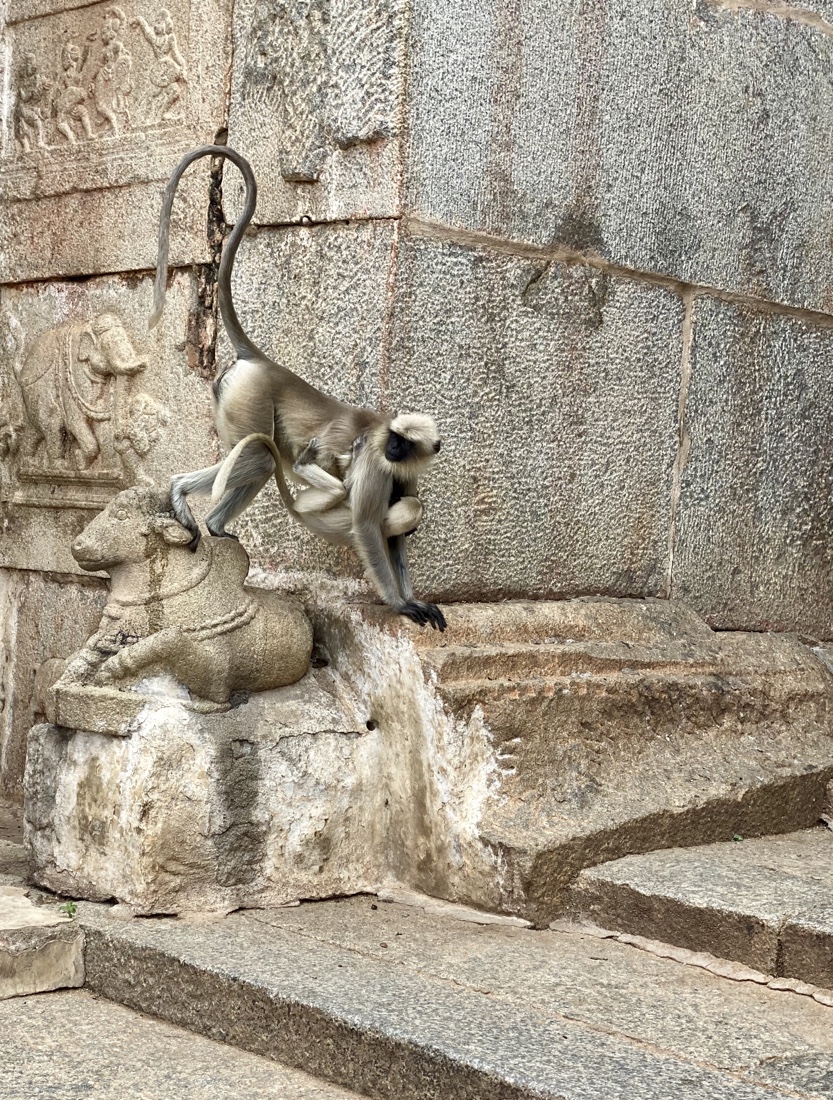 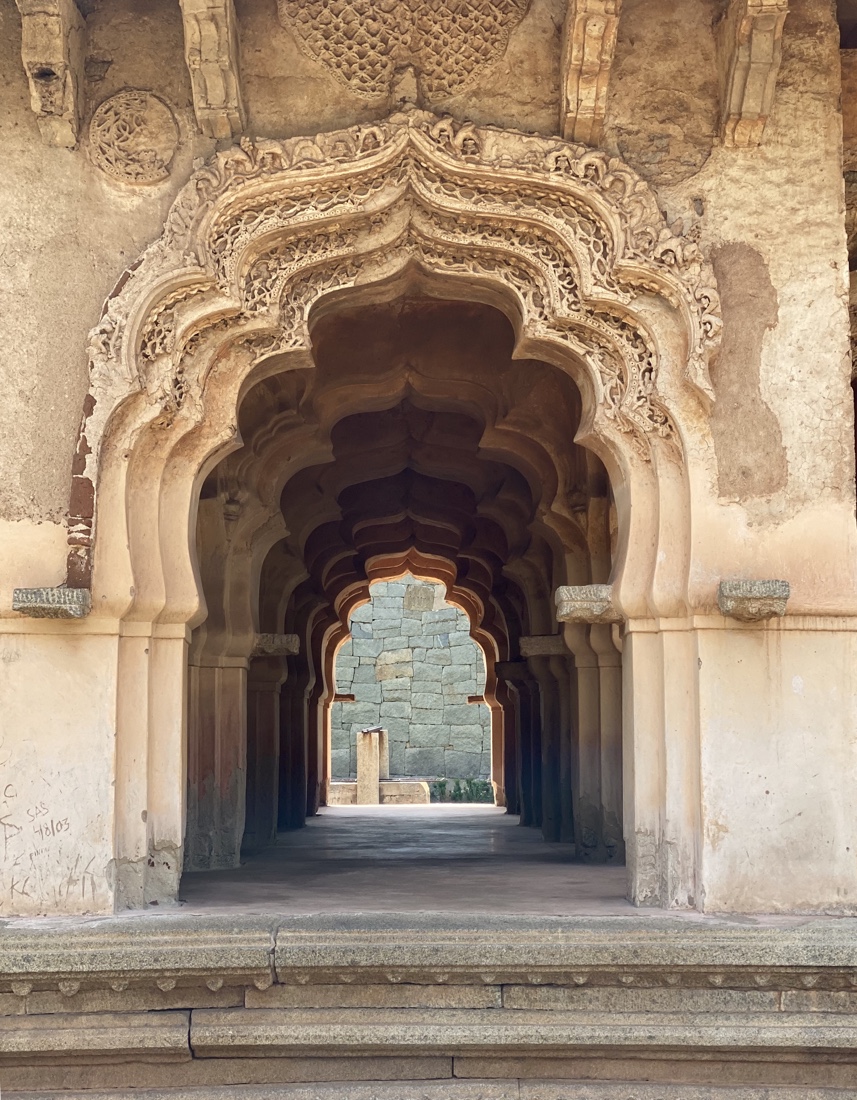 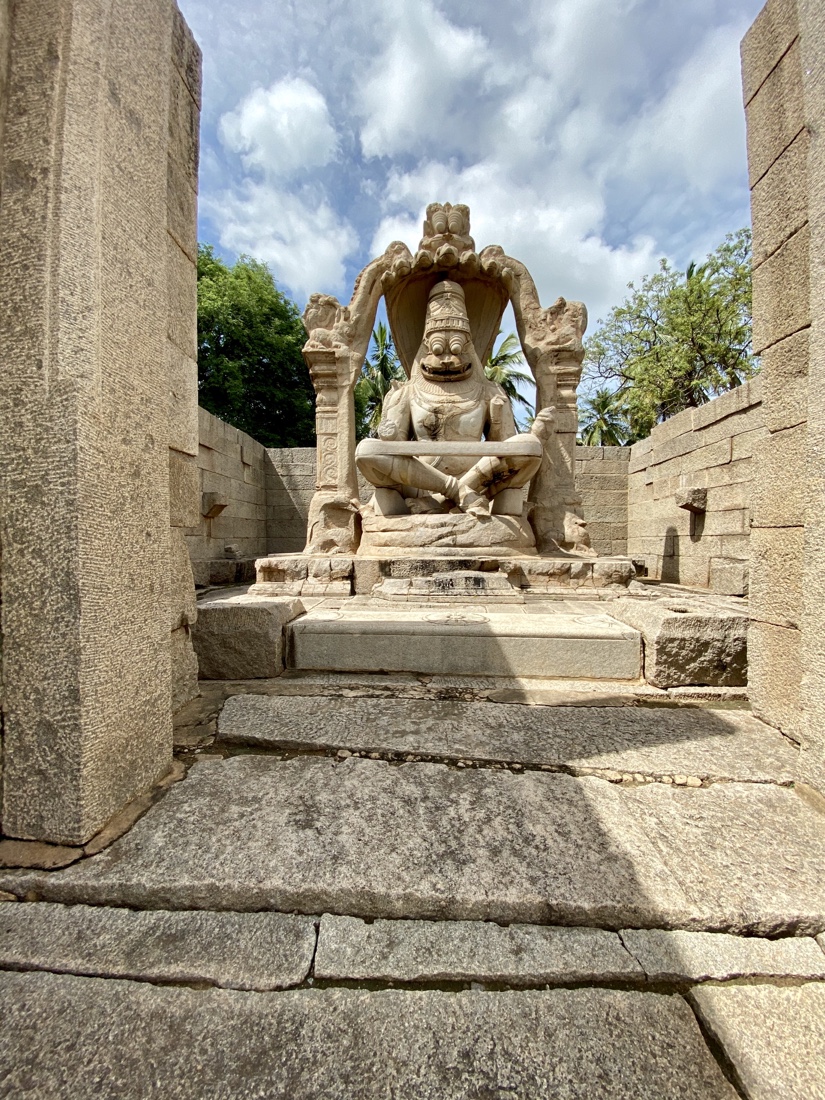 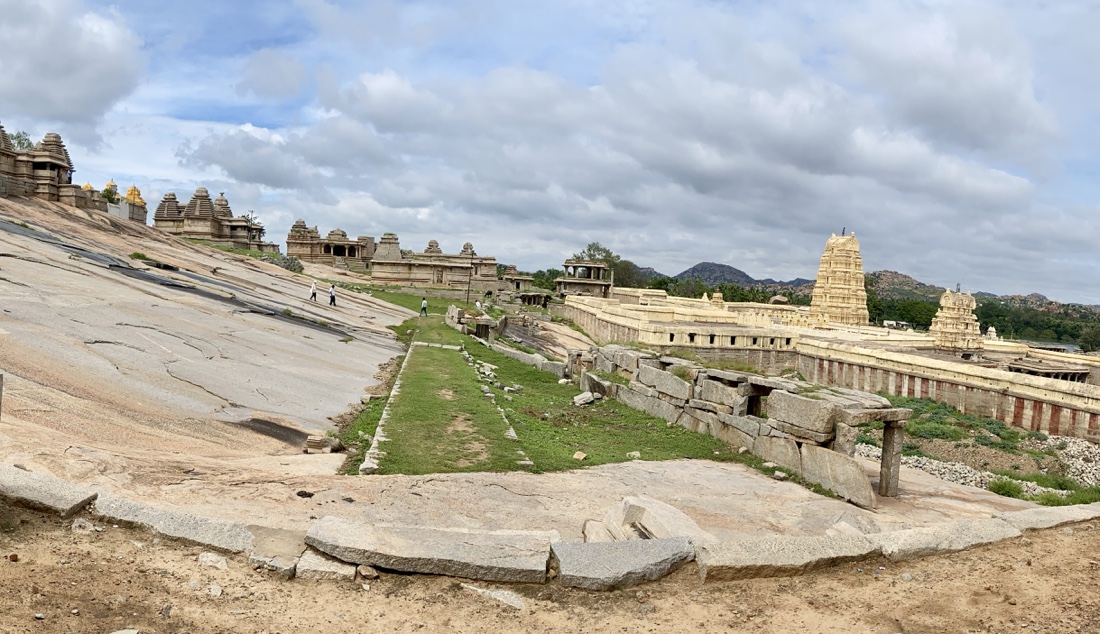 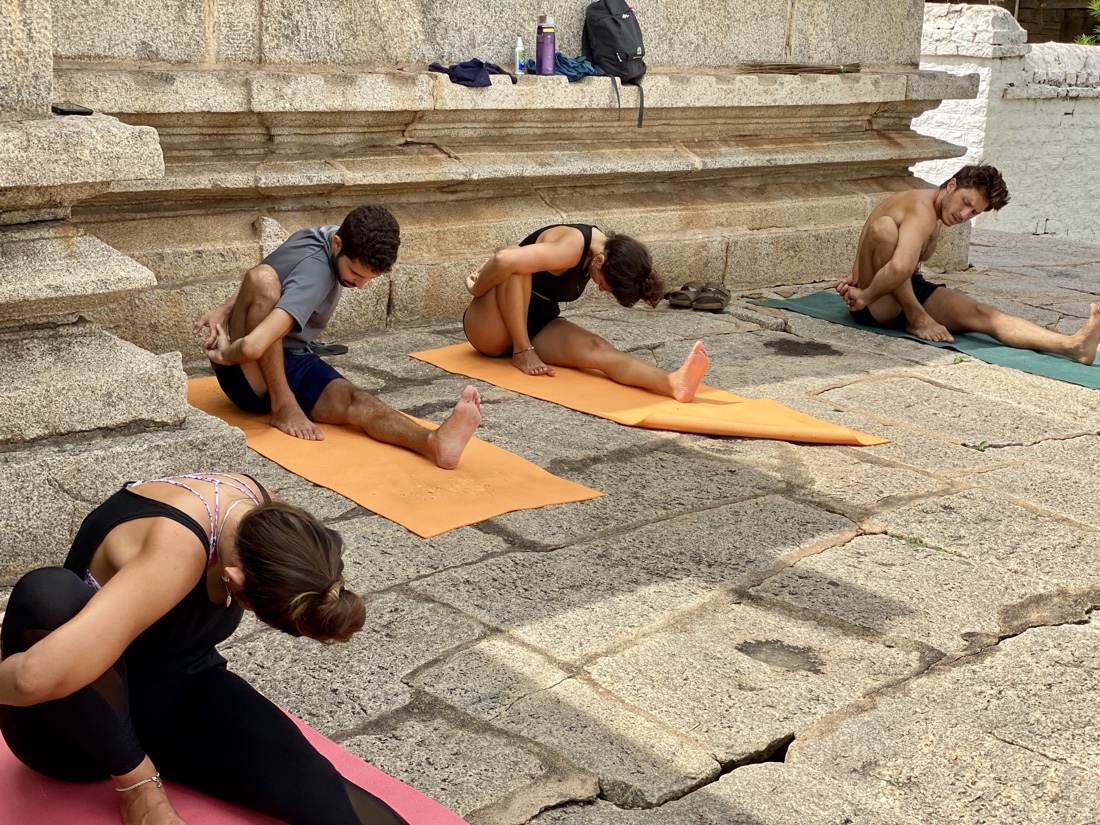 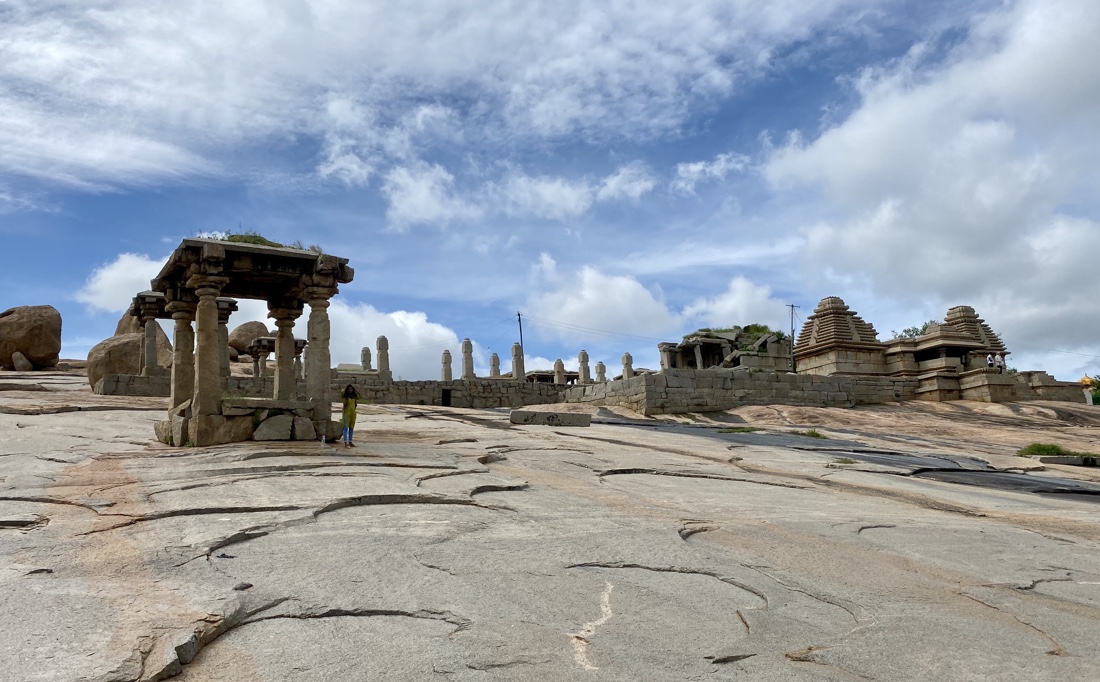 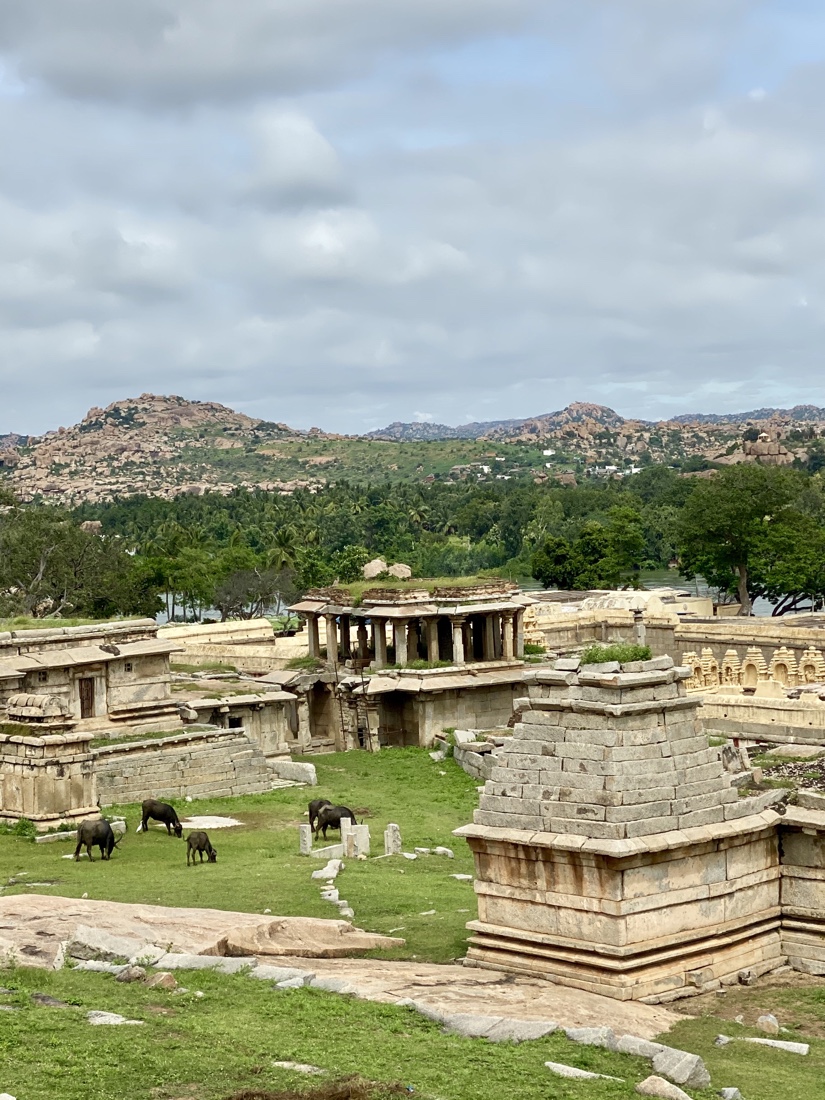 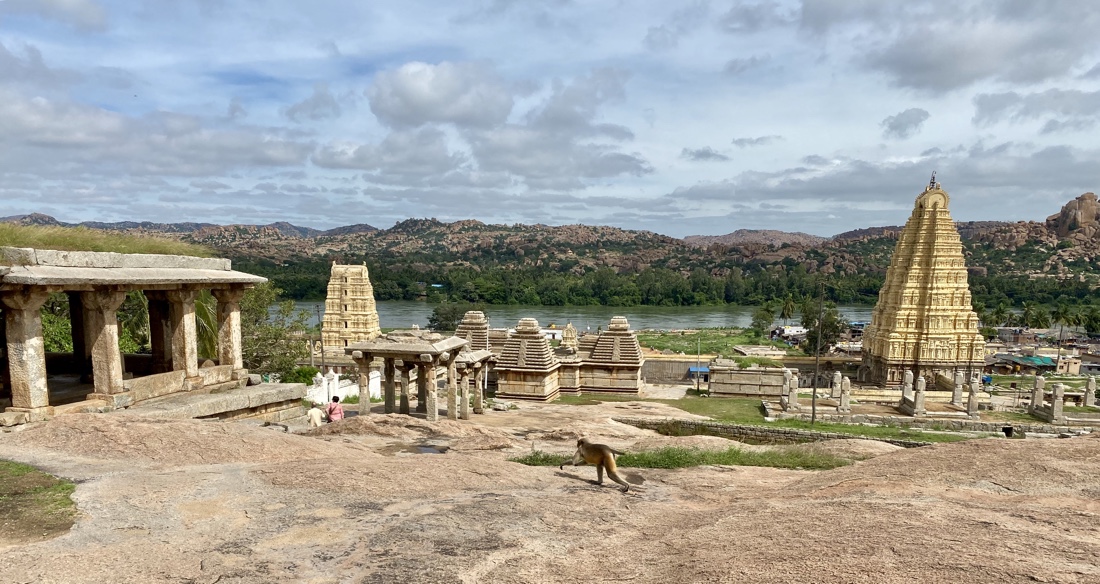 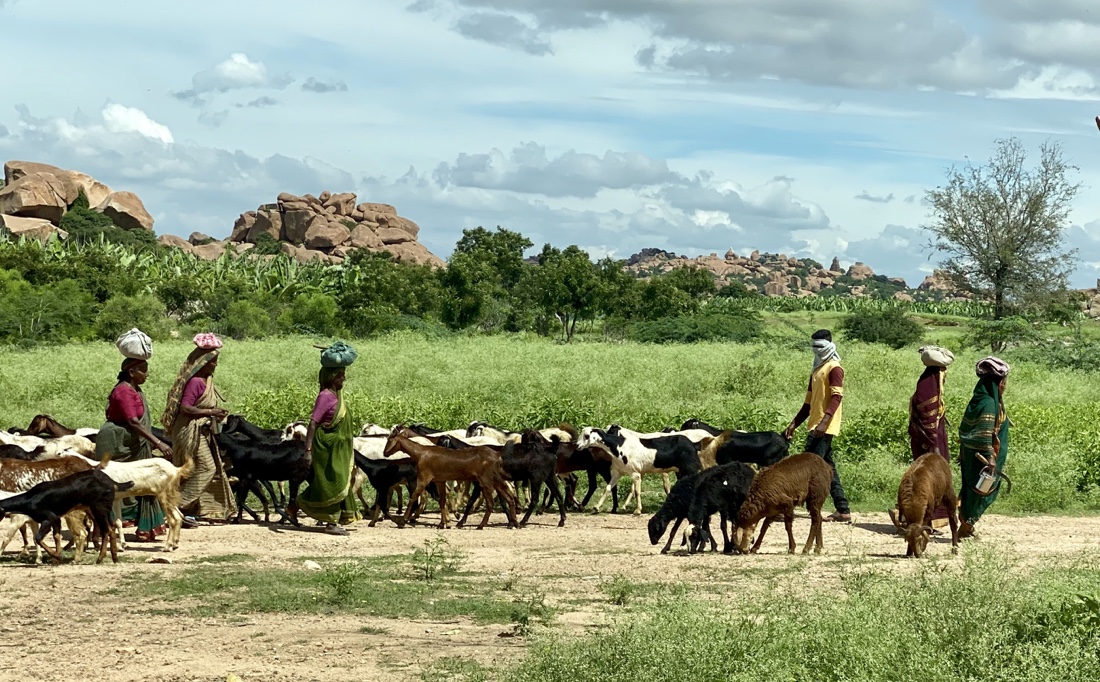 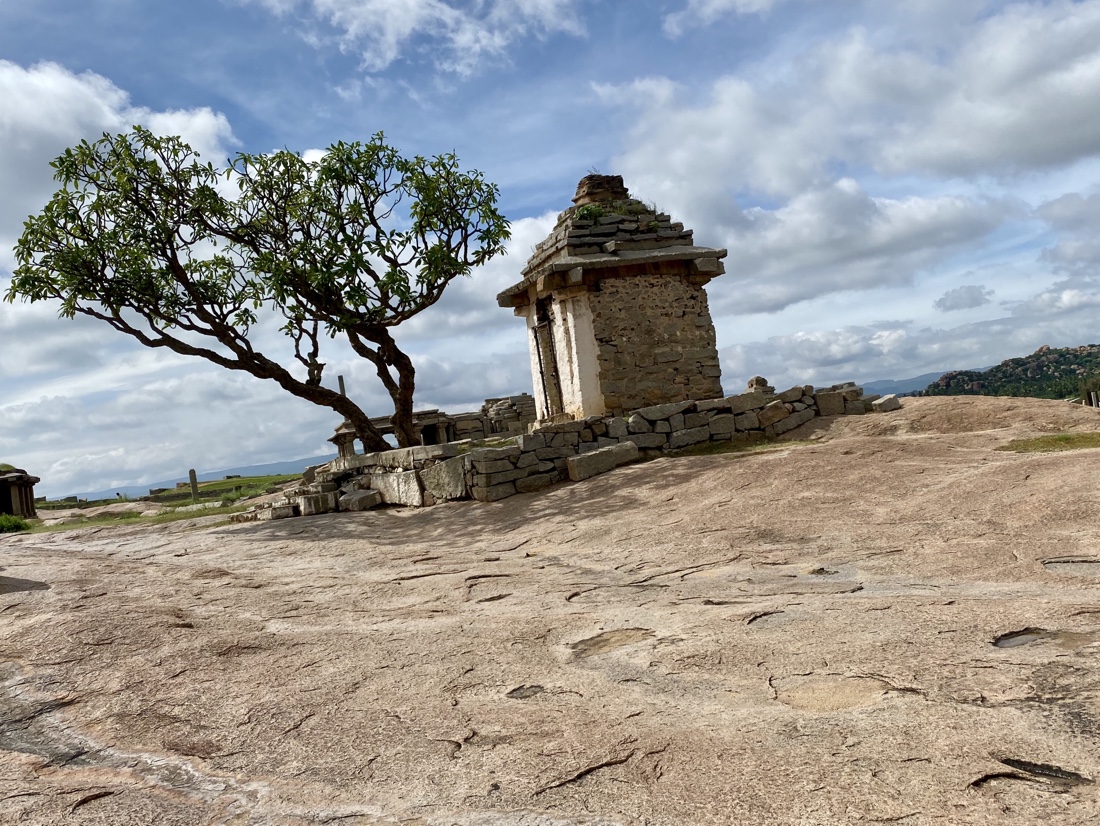 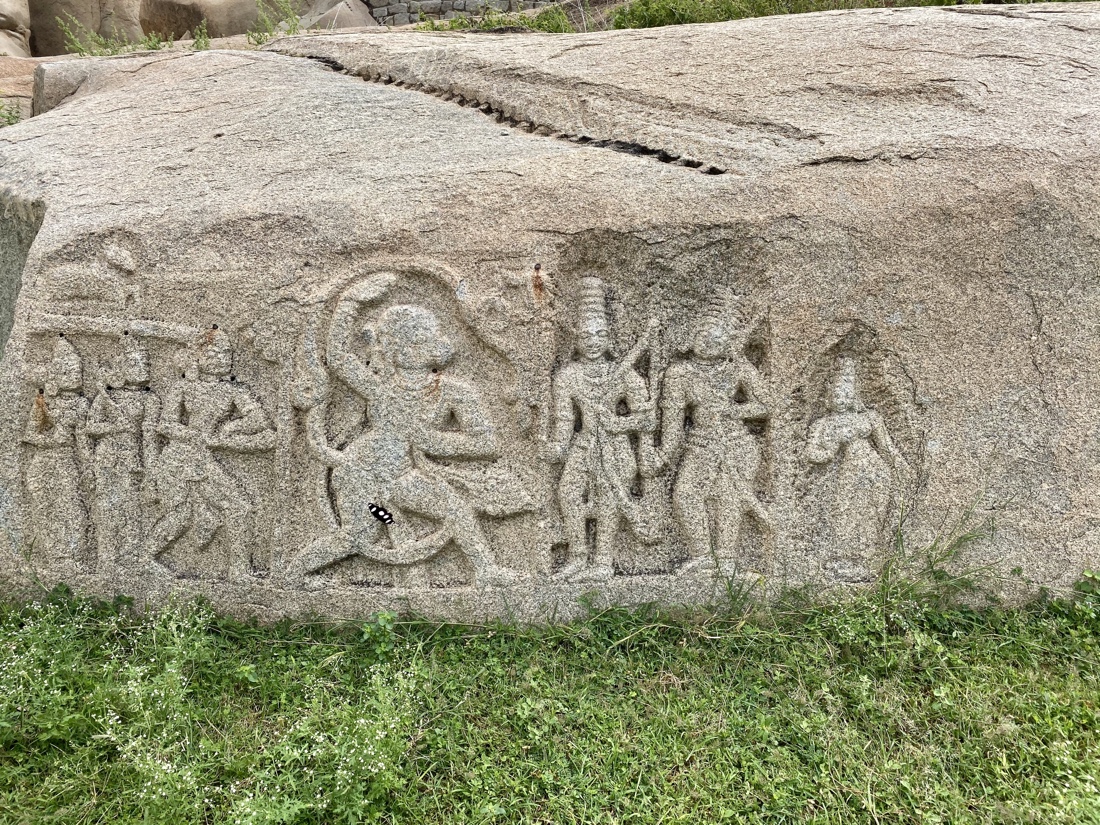 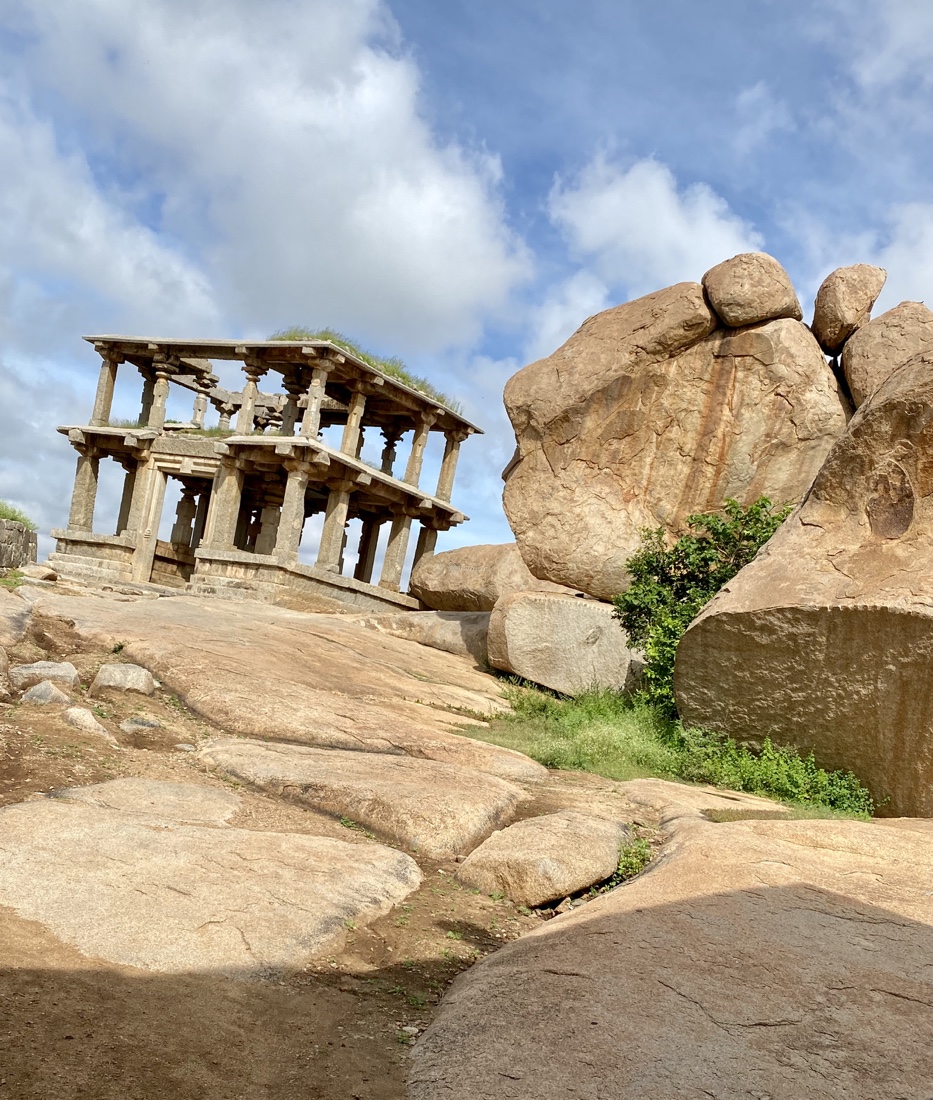 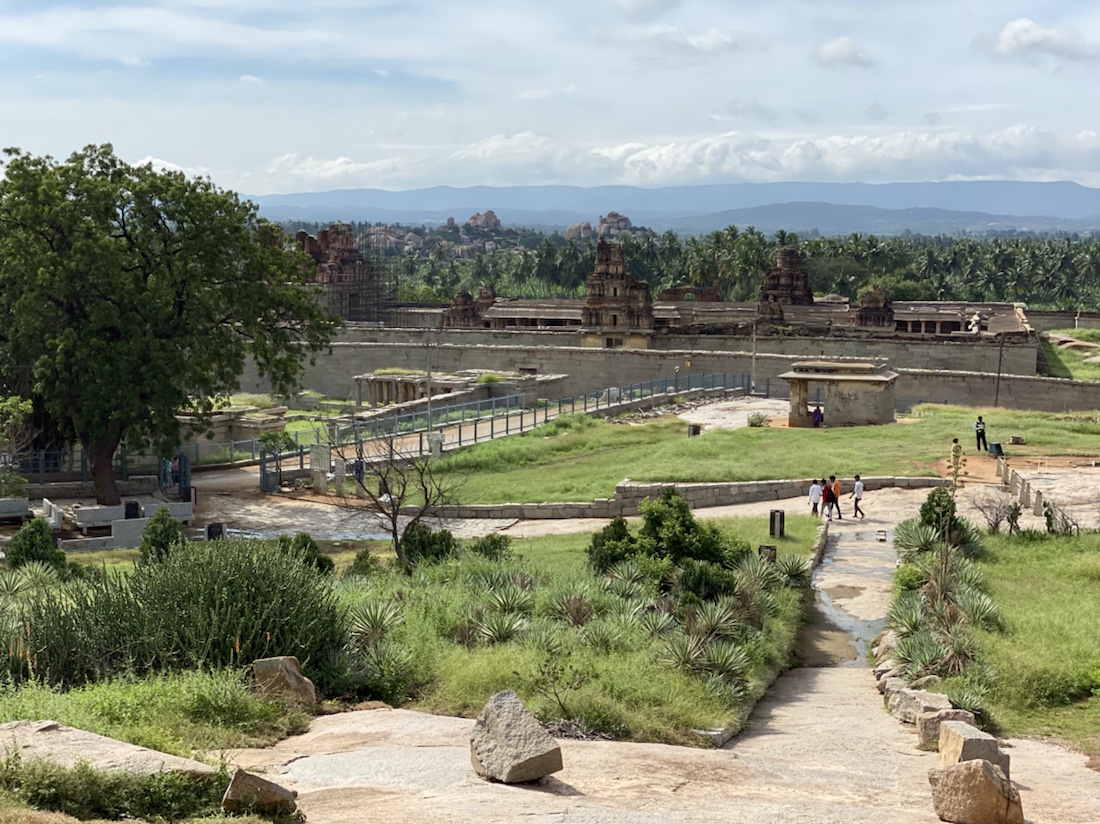 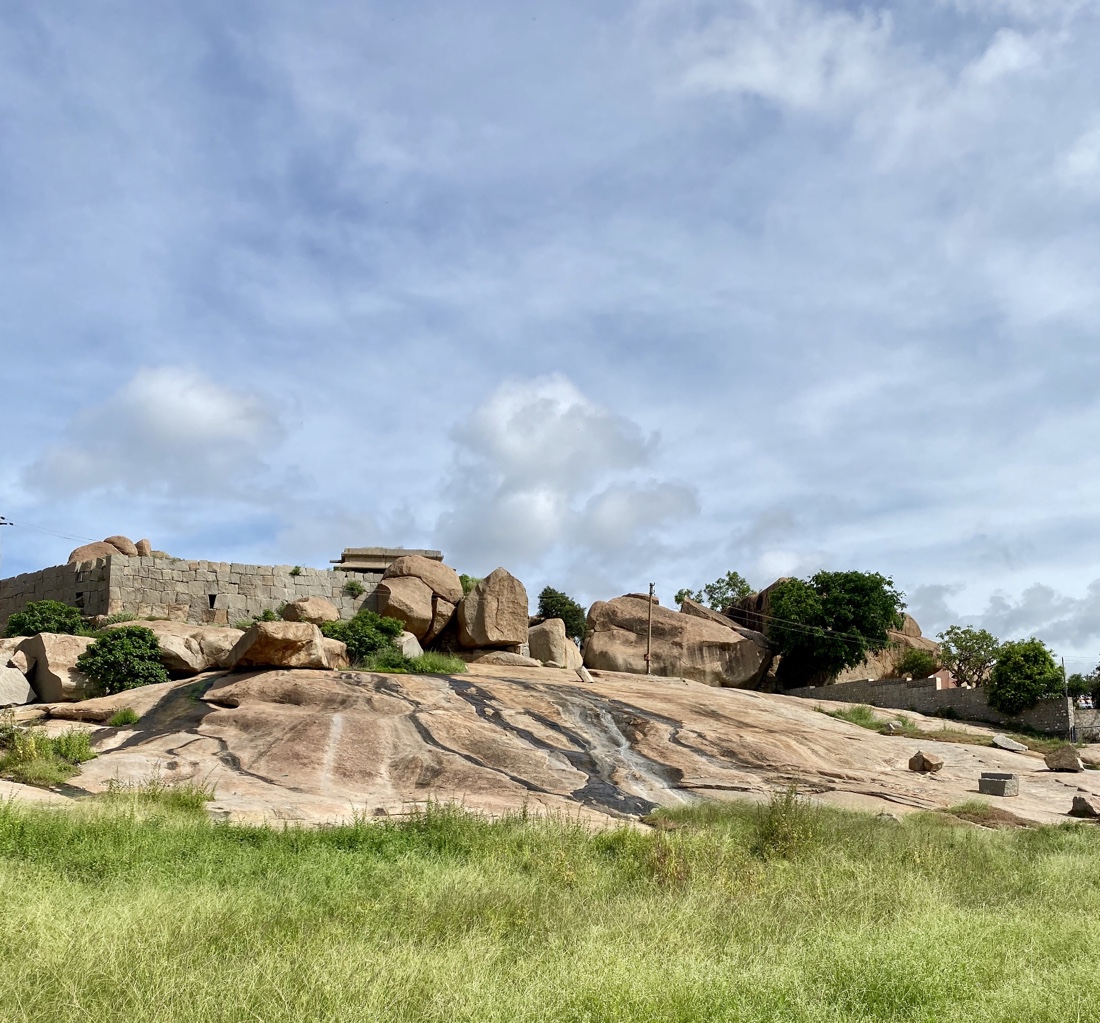 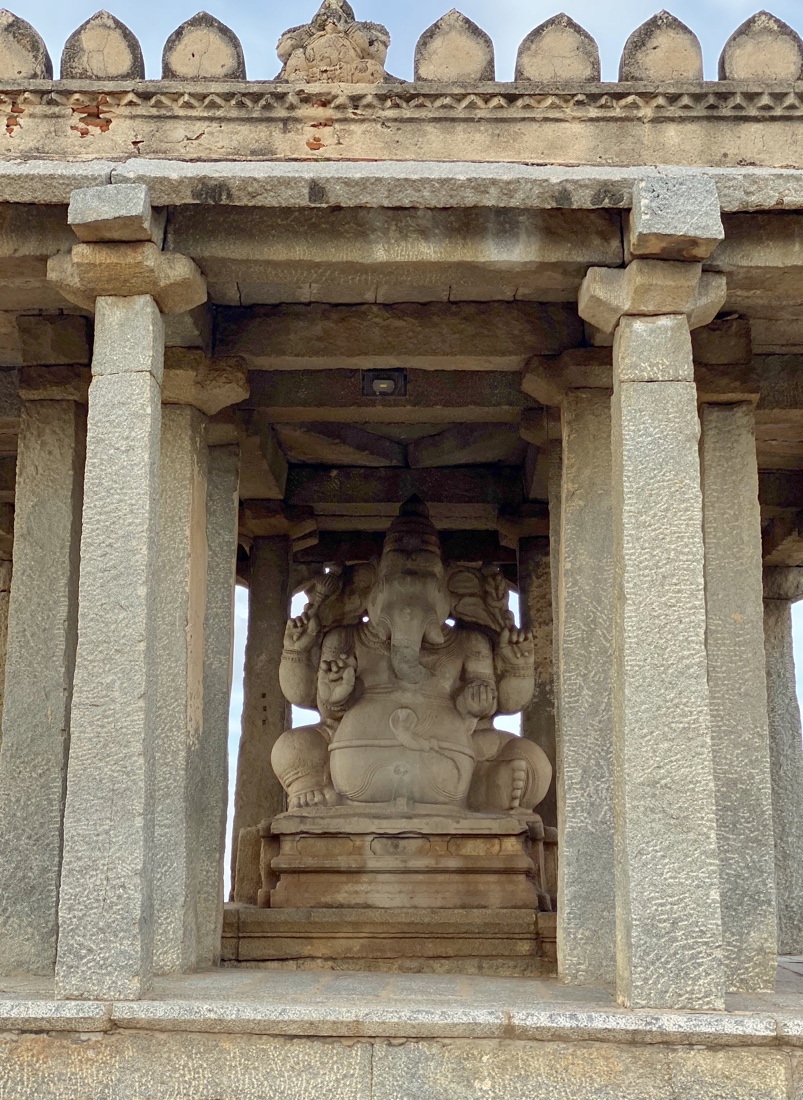 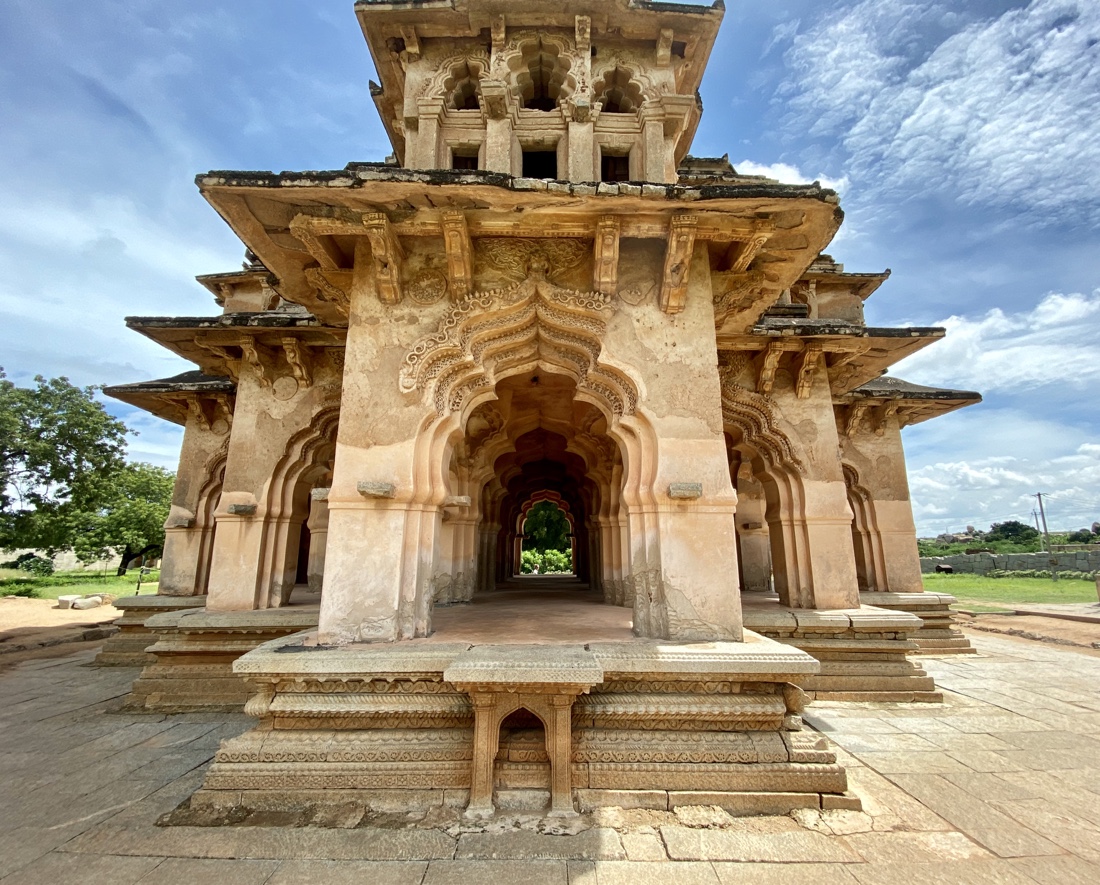
Tonight we had a lovely candle-lit dinner at the hotel’s fancy restaurant alone on a patio. Nice.
|
|

 The hotel is decked out magnificently for Diwali, with fresh flower arrangements everywhere.
The hotel is decked out magnificently for Diwali, with fresh flower arrangements everywhere.

 Later in the afternoon we walk around the blue city, with our guide, Praveen, an enthusiastic Jodhpur native
Later in the afternoon we walk around the blue city, with our guide, Praveen, an enthusiastic Jodhpur native driven there by Mahendra (Manu), who shares the road with Ubers
driven there by Mahendra (Manu), who shares the road with Ubers 

 You see some blue as you look out over the city, towards the fort that was occupied by the rulers until they built and moved into the palace that is now our hotel.
You see some blue as you look out over the city, towards the fort that was occupied by the rulers until they built and moved into the palace that is now our hotel. But there also is plenty of trash
But there also is plenty of trash And, one of the “problems” of traveling as much as we do is that when you hear somebody rave about a blue city, you compare it to another blue city, Chefchaouen , that you saw in Morocco and, as blue cities go, the latter wins, hands down.
And, one of the “problems” of traveling as much as we do is that when you hear somebody rave about a blue city, you compare it to another blue city, Chefchaouen , that you saw in Morocco and, as blue cities go, the latter wins, hands down. The most interesting part of walking around Jodhpur is seeing people preparing for Diwali, by ironing with a coal iron
The most interesting part of walking around Jodhpur is seeing people preparing for Diwali, by ironing with a coal iron



 For Diwali, the festival of lights and one of India’s most beautiful celebrations, oil lamps are lit to decorate homes, and in the evening a “puja” is performed to welcome the Lakshmi, the goddess of wealth. People spend more than a week preparing, cleaning and decorating their homes. We are able to experience the celebration, first hand, with Lokendra and Rama, which is a real treat.
For Diwali, the festival of lights and one of India’s most beautiful celebrations, oil lamps are lit to decorate homes, and in the evening a “puja” is performed to welcome the Lakshmi, the goddess of wealth. People spend more than a week preparing, cleaning and decorating their homes. We are able to experience the celebration, first hand, with Lokendra and Rama, which is a real treat.



 Our guide and driver have waited two and a half hours for us, and now drive us back to the hotel, after our most enjoyable and unusual evening.
Our guide and driver have waited two and a half hours for us, and now drive us back to the hotel, after our most enjoyable and unusual evening.














 As was true of the vegetable market, Carol likes this far more than I do. She enjoys watching the meal being prepared. Lunch is tasty.
As was true of the vegetable market, Carol likes this far more than I do. She enjoys watching the meal being prepared. Lunch is tasty.






 We see the iconic four towers structure in the heart of the market
We see the iconic four towers structure in the heart of the market We walk through the colorful and chaotic market where vendors sell an extraordinary variety of items ranging from mundane household goods, to the colorful bangles for which the city is so well known. Carol buys a bunch of bangles, with Jonty’s assistance. It is a slice of Hyderabadi life – vibrant, chaotic and absorbing.
We walk through the colorful and chaotic market where vendors sell an extraordinary variety of items ranging from mundane household goods, to the colorful bangles for which the city is so well known. Carol buys a bunch of bangles, with Jonty’s assistance. It is a slice of Hyderabadi life – vibrant, chaotic and absorbing.














 The restaurant is crowded with many of the patrons dressed up finely in anticipation of the Diwali holiday.
The restaurant is crowded with many of the patrons dressed up finely in anticipation of the Diwali holiday.



 It begins to drizzle, we take temporary shelter, then tread precariously through very narrow streets filled with motor bikes, tuk-tuks, cars and pedestrians, happy to escape in one piece. The narrow streets were generally too harrowing to photograph, except for the one with the cute baby on the motor bike above, but here’s a photo of a wide avenue to give you a hint.
It begins to drizzle, we take temporary shelter, then tread precariously through very narrow streets filled with motor bikes, tuk-tuks, cars and pedestrians, happy to escape in one piece. The narrow streets were generally too harrowing to photograph, except for the one with the cute baby on the motor bike above, but here’s a photo of a wide avenue to give you a hint.
 I’d written that it was the size of our condo, but I checked at the front desk, and, in fact, our condo is larger, but only by a little bit.
I’d written that it was the size of our condo, but I checked at the front desk, and, in fact, our condo is larger, but only by a little bit.






 Another sign of that modernity is that it is a “silent airport” with no announcement of gates. Sounds like a great idea right, combatting noise pollution?
Another sign of that modernity is that it is a “silent airport” with no announcement of gates. Sounds like a great idea right, combatting noise pollution?




 I’m sure there will be much more to say about our palace tomorrow, in the light of day. But I’ll close with evidence that “nothing’s perfect.” We decided to opt for dinner at the Italian, rather than the Indian, restaurant. As we approached the restaurant, I heard loud sounds of what appeared to be a woman in serious distress. These noises continued and could be heard, loudly, in the Italian restaurant. Upon inquiry, the sound was of a woman singing traditional South Indian music.
I’m sure there will be much more to say about our palace tomorrow, in the light of day. But I’ll close with evidence that “nothing’s perfect.” We decided to opt for dinner at the Italian, rather than the Indian, restaurant. As we approached the restaurant, I heard loud sounds of what appeared to be a woman in serious distress. These noises continued and could be heard, loudly, in the Italian restaurant. Upon inquiry, the sound was of a woman singing traditional South Indian music.
 Tough work, but somebody’s gotta do it.
Tough work, but somebody’s gotta do it.























